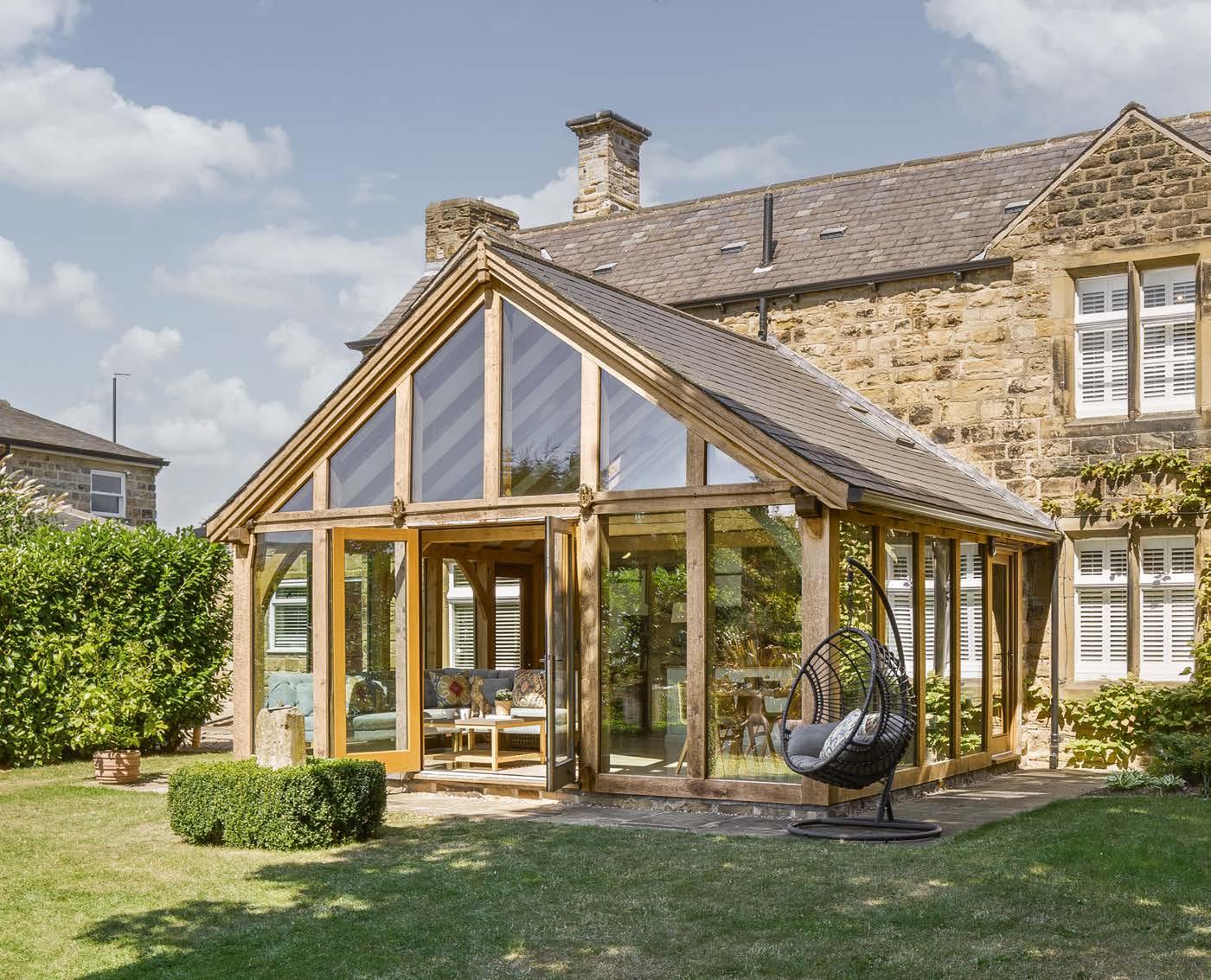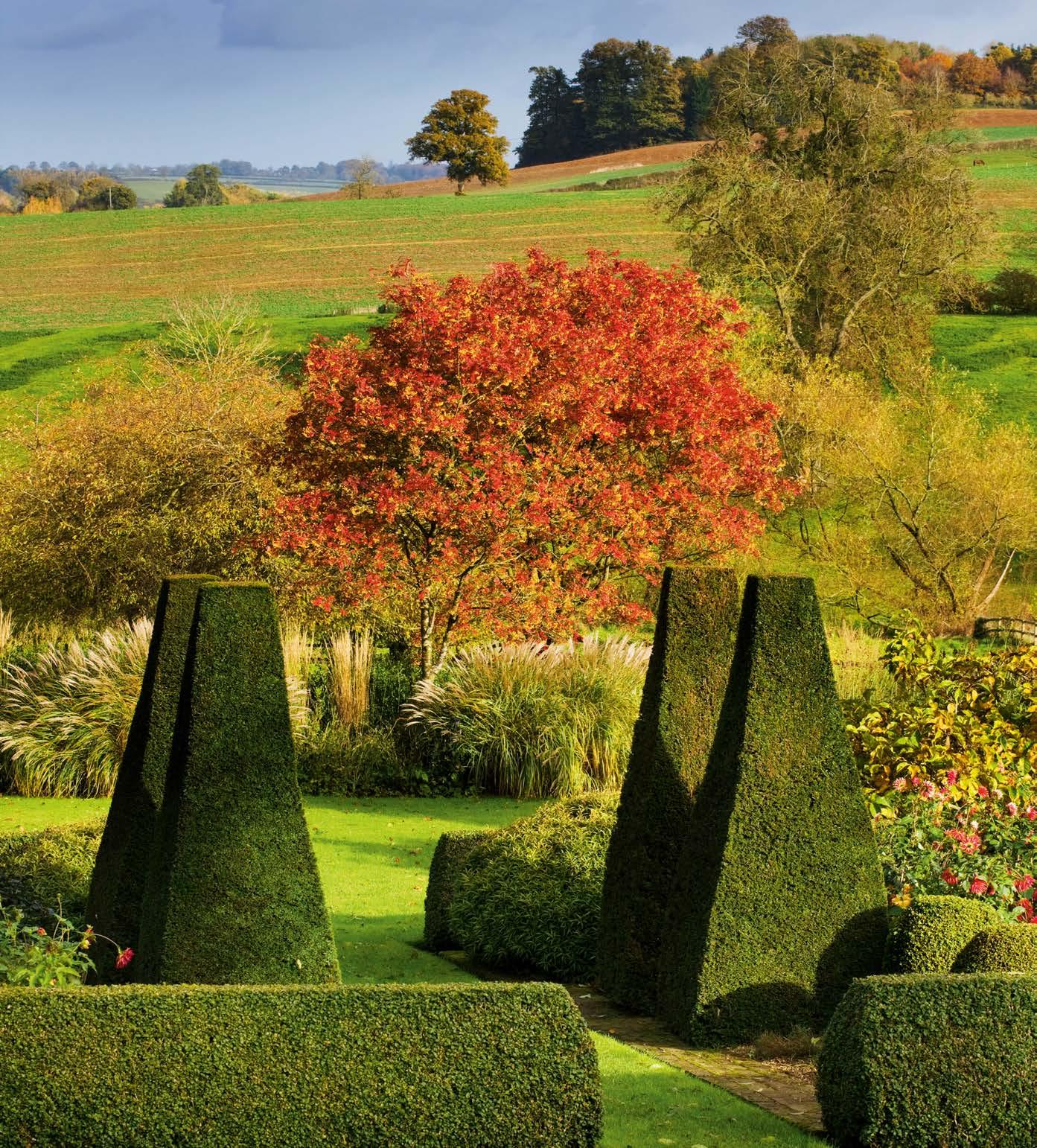



















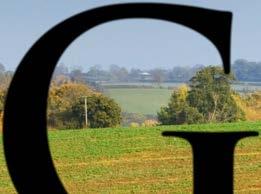




Desirable shrubs for beautiful BERRIES CHANGING LEAVES AND AUTUMNAL HUES TREES Time for Greenhouses & Coldframes in association with Join our exclusive SOMERSET & DORSET garden tour PAGE 62 November inspiration Chrysanths for CUT FLOWERS EVERGREEN pittosporum Grow your own GRAPES TOP 10 multi-stemmed trees 9 7 7 1 3 6 1 2 8 4 1 5 6 1 1 £5.50 GARDEN THEenglish NOVEMBER 2022 www.theenglishgarden.co.ukFor everyone who loves beautiful gardens

Stefan has been a writer and broadcaster for over 40 years.

He holds the RHS Veitch Memorial Medal and the Garden Media Guild’s lifetime achievement award. He visits Gresgarth Hall in Lancashire on p22.
We were halfway through working on this issue when we heard the sad news that Her Majesty the Queen had died, and so it was with heavy hearts that we finished o its last few pages. The Queen has always been a steadfast part of the gardening world in the same way she has been a constant and cherished part of our lives for so many years. We will miss her, but we also look forward to the reign of King Charles III, whose own beautiful English garden at Highgrove has featured previously in these pages. He is a passionate gardener and a long-standing champion of the environment, and we wish him well in keeping these issues top of mind as we enter a new Carolean era.
Sandra Lawrence
Sandra is a freelance journalist and the author of 16 books.


Her most recent, Miss Willmott’s Ghosts, is a new biography of Edwardian horticulturist Ellen Ann Willmott. Sandra visits Spetchley Park on p32.
This year we were urged to ‘plant a tree for the Jubilee’ and even though the Queen’s historic reign has come to an end, it’s still a wonderful reason to plant one. We’re on the cusp of the best time of year to plant trees, so if you’d like to celebrate her legacy – while enjoying all the many benefits a tree brings to your garden – turn to page 71 where we select some favourites from the dizzying array of choice. The gardens in this issue are also full of autumn colour thanks to trees’ magnificent seasonal show, so there’s plenty of inspiration if you’d like to plant a beautiful new specimen that will bring joy for years to come.
ON THE COVER
Ian Tocher


Ian is garden manager for Historic Royal Palaces at Hampton Court Palace, where he looks after the nursery, productive gardens and garden volunteers. Find out how he cares for Hampton Court’s Great Vine on page 97.

It’s time to plant trees and enjoy their colourful, autumnal glory, like this Sorbus ‘Joseph Rock’ at Pettifers, photographed by Clive Nichols.
DIGITAL PLATFORMS
Buy digital editions of The English Garden for phone and tablet from the App Store for iPhones, and Google Play for Android.



NEWSLETTER






Sign up to our newsletter for regular gardening tips and advice. theenglishgarden. co.uk/newsletter/
 CLARE FOGGETT, EDITOR
Stefan Buczacki
CLARE FOGGETT, EDITOR
Stefan Buczacki
NOVEMBER 2022 THE ENGLISH GARDEN 3
IMAGE JAYNE LLOYD @TEGmagazine englishgardenukThe-English-Garden-Magazine theenglishgardenmagazine Welcome
CONTRIBUTORS





TIMELESS CLOTHING & EQUIPMENT TO CARRY YOU THROUGH THE SEASONS carriercompany.co.uk ALWAYS MADE IN THE UK
The Chelsea Magazine Company Ltd, 020
GARDENDESIGN TRAININGFOR PROFESSIONALS


Findoutmoreaboutourinspirational trainingatRoyalBotanicGardensKew, RHSGardenWisleyandonline.

SUBSCRIPTION English CDS Sovereign Park, Market Harborough, Leicestershire LE16 9EF, UK. Tel: 01858 438854. and Rest of World: +44 (0)1858 438854. £80 (13 £90; €110 (13 £110; $150; AUS $215 (13 Distribution Ltd, 2 East Poultry Avenue, London EC1A 9PT, UK. Tel: +44 (0)20 7429 3667.

OurDiplomaandProfessional Developmentprogrammesareavailable onlineinreal-timeclassesaswellasat ourhomeinRoyalBotanicGardensKew. In2022wealsohaveshortcoursesfor professionalsandgardenenthusiastsat RHSWisleyGarden,DenmansGarden andonline.
Visitourwebsite lcgd.org.uk tohearhow ourstudentsarecreatingsuccessful gardendesigncareersanddiscoveran ever-changingrangeofcoursesforthe gardenenthusiast.
 Design:WillWilliams +44(0)1483762955info@lcgd.org.uk
Design:WillWilliams +44(0)1483762955info@lcgd.org.uk
NOVEMBER 2022 THE ENGLISH GARDEN 5
For everyone who loves beautiful gardens
Jubilee House, 2 Jubilee Place, London SW3 3TQ Tel:
7349 3700 Email: theenglishgarden@chelseamagazines.com Editorial EDITOR Clare Foggett DEPUTYEDITOR Vivienne Hambly ARTEDITOR Jeremy Bird PRODUCTIONEDITOR Vanessa Longworth CONTRIBUTINGONLINEEDITOR Phoebe Jayes Advertising GROUPSALESDIRECTOR Catherine Chapman HEADOFSALESOPERATIONS Jodie Green ADVERTISINGMANAGER Astrid Elsen Tel: 020 7349 3743; astrid.elsen@chelseamagazines.com ADVERTISINGPRODUCTION allpointsmedia Publishing CHAIRMAN Paul Dobson MANAGINGDIRECTOR James Dobson CHIEFFINANCIALOFFICER Vicki Gavin PUBLISHER Caroline Scott CIRCULATIONMANAGER Daniel Webb OPERATIONSMANAGER Sarah Porter EATOCHAIRMAN Sophie Easton Online GROUPDIGITALMANAGER Ben Iskander EMAILANDDIGITALCREATIVEMANAGER Jenny Choo Production REPROGRAPHICSMANAGER Neil Puttnam PRINTING William Gibbons Ltd, Willenhall, UK The English Garden (UK issue) ISSN no 1361-2840. Printed in England. Manage your print and digital subscriptions online, stay up to date with the latest issues, update your personal details and even renew your subscription with just a click of a button. Sign up at https://www.subscription.co.uk/chelsea/Solo/ © The Chelsea Magazine Company Ltd 2022. All rights reserved. Text and pictures are copyright restricted and must not be reproduced without permission of the publishers. The information in The English Garden has been published in good faith and every effort has been made to ensure its accuracy. However, where appropriate, you are advised to check prices, opening times and dates etc before making final arrangements. All liability for loss, disappointment, negligence or damage caused by reliance on the information within this publication is hereby excluded. The opinions expressed by the contributors of The English Garden are not necessarily those of the publisher. www.chelseamagazines.com: publishers of The English Home, Artists & Illustrators, Baby, Little London, Wedding Ideas, BRITAIN, Discover Britain, Cruise International, Independent School Parent and associated guides, Racecar Engineering, Classic Boat, Sailing Today, Yachts & Yachting and Popshot.
OFFICE The
Garden,
Global,
Europe
SUBSCRIPTION ENQUIRIES 01858 438854 EMAIL theenglishgarden@subscription.co.uk SUBSCRIPTION RATES UK
issues) Europe
issues) ROW
US
issues) NEWS DISTRIBUTION Seymour
theenglishgarden.co.uk The Professional Publishers Association Member
CONTENTS





Gardens
22 Gresgarth Hall It may look sublime in its late-autumn finery, but for self-confessed perfectionist Arabella Lennox-Boyd there is always work to be done at her Lancashire home for “no garden is set in aspic”.

32 Spetchley Park Generations of the Berkeley family have worked on this Worcestershire garden, resulting in mature layers of planting and extensive botanical riches that make it something to treasure.
42 Inverewe On the windy north-west coast of Scotland, planting pockets cut into the sheltering pine forest and the warming e ects of the North Atlantic Drift allow an almost tropical garden to flourish.



49 Brockholds Manor This Hertfordshire garden is imbued with a sense of the past, while its owners aim to preserve its heritage and adapt to a changing climate.
56 Daws Hall Piercing the autumnal haze that hangs over the pools at this garden on the Essex-Sussex border is an array of beautiful specimen trees, blazing with seasonal colour in a naturalistic setting.

Plants
65 Top 10 Plants Multi-stem trees are a striking addition to any garden, and designer Stefano Marinaz suggests ten candidates particularly well suited to the form.
71 Trees Winter is the very best time of year to plant trees, and we have suggestions for small gardens, seasonal interest, di erent soil types and those seeking privacy.


79 Plant Focus Evergreen pittosporum is the go-to statement shrub for practically any situation thanks to its gorgeously glossy foliage and low-maintenance habit.
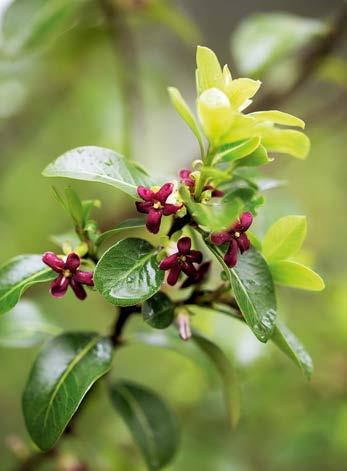
85 A Cut Above In the first of a four-part series exploring the most covetable plants of the winter season, Philip Clayton looks at shrubs for berries, flowers and foliage.
89 Chrysanthemums At Green & Gorgeous in Oxfordshire, Rachel Siegfried shares the secrets to growing opulent chrysanthemums.
97 Grapevines How the team at Hampton Court Palace care for the garden’s enormous 254-year-old ‘Black Hamburg’ grapevine, plus recommended varieties to try at home.
6 THE ENGLISH GARDEN NOVEMBER 2022 49 22 79
subscription PAGE 18
November 2022 19


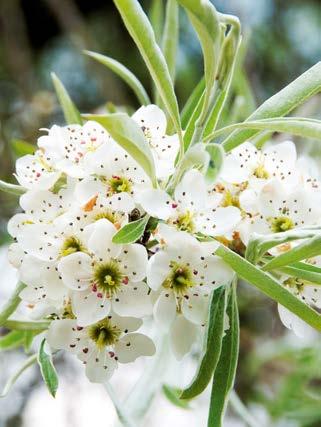







NOVEMBER 2022 THE ENGLISH GARDEN 7 42 71 65 103 Overwintering As temperatures fall, it’s time for gardeners to take steps to keep halfhardy and tender plants safe over winter. Regulars 9 This Month Plants, people, news and events, books and beautiful things to buy, plus designer Bunny Guinness’s diary. 19 Shopping Brighten up the shortening autumn evenings with these garden lights. 114 To Conclude The fig is a favourite of Non Morris, who recommends select varieties. Offers 18 Subscribe & Save Subscribe to The English Garden and save money. 62 Garden Tours Visit the gardens of Dorset and Somerset with Sisley Garden Tours.IMAGES KAT WEATHERILL; ANNA OMIOTEK-TOTT; DIANNA JAZWINSKI; RAY COX; SHUTTERSTOCK FOR THE FINEST CONSERVATORIES, ORANGERIES AND ROOFLIGHTS +44(0)1476 564433 www.valegardenhouses.com
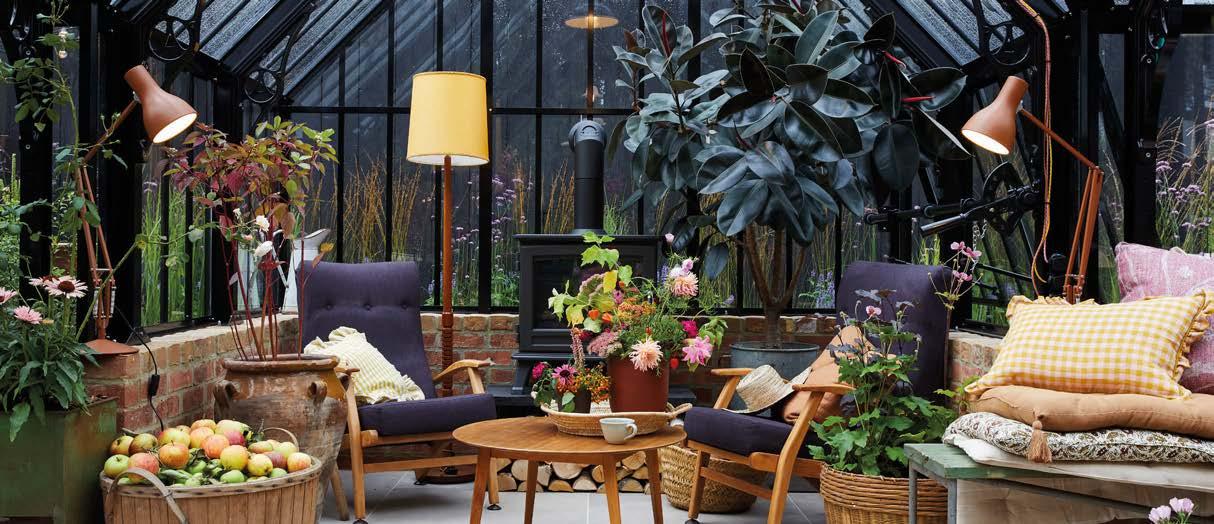
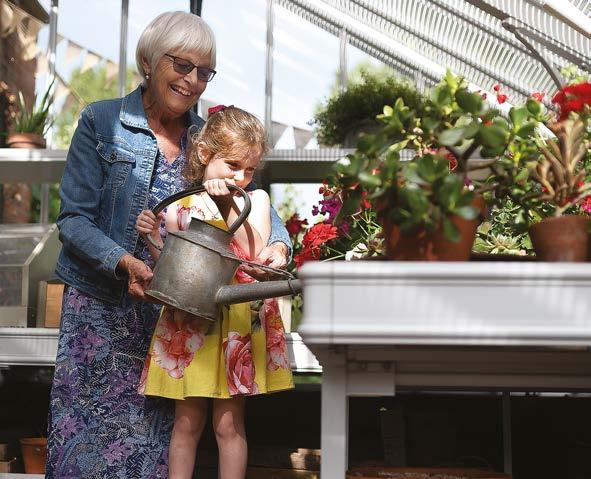
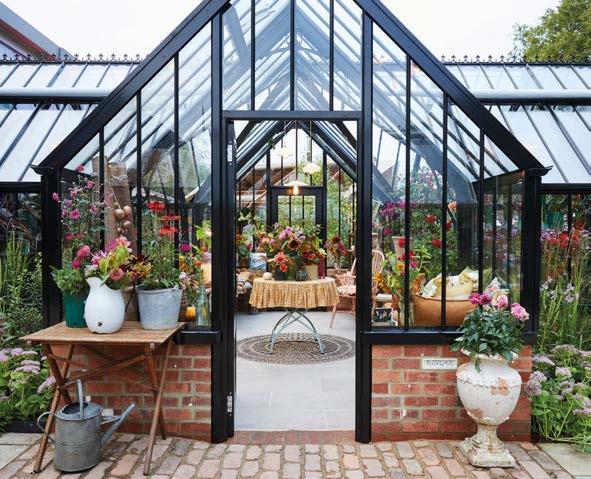
GREENHOUSES AND CONSERVATORIES GREENHOUSES AND CONSERVATORIES Passionate about all that grows www.alitex.co.uk 01730 826900
This Month
Our guide to plants, people, gardens and events, tasks and shopping in November

Cyclamen hederifolium FLOWER NOW
You know it’s autumn when the delicate pale pink flowers of Cyclamen hederifolium emerge from the soil, appearing all the more fragile for their lack of leaves. The foliage will emerge later, patterned with silver, and it’s said that, like snowflakes, no two plants have the same
leaf markings. Autumn is also the best time to plant this cyclamen’s plump tubers. They thrive in the dappled shade of trees and shrubs and will soon seed around, helped by the ingenious way the flower stalks tightly coil once seed has set to bring the seedpod down to soil level.
NOVEMBER 2022 THE ENGLISH GARDEN 9
IMAGE CLIVE NICHOLS
IN



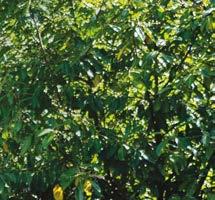

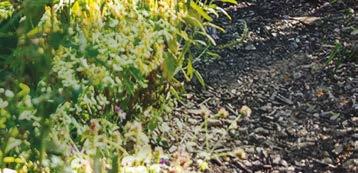











































An amazing innovation in outdoor cooking that takes everything you cook to a whole new level. Inspired by the charcoal ovens which are the secret of top professional kitchens, the Charlie oven makes it effortless to create truly incredible flavours. Whatever the food, whatever the occasion, whatever the season. ALL-IN-ONE CHARCOAL OVEN, SMOKER, PIZZA OVEN & BBQ. FEEL LIKE A CHEF EVERY TIME YOU COOK. WWW.CHARLIEOVEN.COM
Darryl Moore
I grew up in New Zealand, and as a child I had a very typical outdoor kind of life. We took it for granted that walking through bush and camping was what people did: we had a very direct relationship with the land. We learnt to respect the landscape and its potential dangers while still interacting with it in a positive way.
After moving to the UK as an adult in the 1980s, I
worked in the music industry for a long time as a DJ and sound artist. I grew fascinated by the way sounds are shaped by the spaces they’re in, and started making field recordings. My focus gradually shifted from the sound within a space to the design that was influencing the sound. There was a buzz around landscape architects Martha Schwartz and Peter Walker,
who brought conceptual and artistic elements to their work.




In time, I found there was this kind of confluence between my work and interests, so in the 1990s I visited the classic gardens of Great Dixter in East Sussex and Derek Jarman’s garden in Dungeness, then enrolled at the Pickard School of Garden Design. It was an intense period of work and study.
In 2010, Adolfo Harrison and I formed Cityscapes, bringing together di erent creative approaches to design. There were a lot of empty spaces in London at that time, and we wanted to turn them into dense, green, urban areas. We struck up an association with local cultural organisations, which led to us working with Sarah Eberle and St Mungo’s, the homelessness charity, to make Gibbons’ Rent, a pocket park near London Bridge. It was the start of a long relationship with St Mungo’s that led to our Chelsea show garden with them in 2022.
Having wild spaces in cities is important, but they have to be intentional. I’d like to see more robust policies that ensure green elements are central to redevelopment with planting involved in an integral way. I’d also like to create more of a culture around plants and celebrate the local and traditional knowledge of plants in this country. Every space has potential to be transformed by plants.
Gardening in a Changing World by Darryl Moore (Pimpernel, £20) is out now. darrylmooredesign.com; cityscapes.org.uk
RECOMMENDED Darryl’s favourite gardens to visit
By the Crossways Su olk
This three-acre garden on an organic farm has elements of previous formal structure – there is a crinkle-crankle wall – but it’s becoming more wild around the edges and I find that very interesting. Tel: 01449 740325; bythecrossways.co.uk

Burgess Park
London
James Hitchmough’s work at this South London park is really interesting. I go quite often to see how the wild meadows are developing. It’s a good social space that works well, with di erent planting and spaces for di erent activities. Tel: 020 7525 2000; southwark.gov.uk


Introducing we most in British People to Meet
NOVEMBER 2022 THE ENGLISH GARDEN 11
INTERVIEW VIVIENNE HAMBLY IMAGES GAP/JULIETTE WADE; ALAMY
the gardeners and public figures
admire
horticulture
Landscape designer and co-founder of Cityscapes Darryl Moore sees opportunity for transformation in every unloved city space
Out & About
Wildlife Photographer of the Year
14 October 2022-2 July 2023, London
The latest exhibition of the Natural History Museum’s annual competition opens in October. More than 100 photographs will be on display, illustrating the precious beauty of the natural world – a common theme of the photos is the impact of human activity on wildlife across the globe. Among the images is seven-year-old Joshua Cox’s portrait of a stag in London’s Richmond Park (right). Wildlife Photographer of the Year is developed and produced by the Natural History Museum, London. Adult tickets £17, book at nhm.ac.uk

RHS Gardens Start to Glow
From 16 November, Various locations
The five RHS gardens of Bridgewater, Harlow Carr, Hyde Hall, Rosemoor and Wisley, will all be lit up this winter as part of Glow, the annual event that fills each garden with twinkling light trails and colourful, illuminated displays. Check each individual garden for the dates of its specific Glow event. Bridgewater kicks things o on 16 November, when the garden’s yew domes will be spangled with fairy lights and a trail will lead visitors through colourfully lit trees to a dramatic fountain display. These after-dark openings are an opportunity to see the gardens in a whole new light and promise to be bigger than ever. Advance booking is essential at rhs.org.uk

Paradise on Porcelain
14 November-19 December, Online
Plants and flowers provide endless inspiration for artists, not least those creating ceramics. In a new series of six weekly online talks, The Gardens Trust will explore how floral images and themes have influenced and inspired the creation and decoration of ceramics. Speakers include historians and curators on topics ranging from the symbolism of Chinese peonies to the iconic Green Frog Service. Talks are available individually for £5, or listen to the full series for £24. thegardenstrust.org

NGS Garden
The Swiss Garden Bedfordshire
This enchanting garden was created in the ‘Swiss picturesque’ style for the third Lord Ongley in the early 19th century and reopened in July 2014 after major restoration. Serpentine paths lead towards clever vistas, bridges, ponds and a Pulhamite-lined Grotto Fernery. The Swiss Garden, Old Warden, Biggleswade Bedfordshire SG18 9ER. Opens 3 November. Adult: £10; Child: Free. ngs.org.uk
 IMAGES HEPWORTH; JOSHUA COX/WILDLIFE PHOTOGRAPHER OF THE YEAR; DARREN HARBAR
IMAGES HEPWORTH; JOSHUA COX/WILDLIFE PHOTOGRAPHER OF THE YEAR; DARREN HARBAR
12 THE ENGLISH GARDEN NOVEMBER 2022
RHS/NEIL
Unmissable events, news and the very best gardens to visit this month



Discover the secret of Hartley Botanic by calling 0800 783 8083 or visit www.hartley-botanic.co.uk The only aluminium Glasshouses and Greenhouses endorsed by the RHS ® The Royal Horticultural Society. The Royal Horticultural Society, and its logo, are trade marks of The Royal Horticultural Society (Registered Charity No 222879/SC038262) and used under licence from RHS Enterprises Limited. NOTHING ELSE IS A HARTLEY Victorian Manor, Utah, USA THE HARTLEY COLLECTION


Unforgettable Experiences What’s included Stroll through 80 acres of parkland at the yearly spectacle of Keukenhof Gardens Built on a myriad of canals, Amsterdam’s crooked buildings and traditional gabled façades house a multitude of enticing bakeries, vintage shops and relaxed bistros. Enjoy cultural insights as guest speakers such as Charlie Dimmock share their knowledge. Visit the Battlefields of Ypres and enjoy an on board talk by Col. Piers StoriePugh OBE. 7 nights on board the luxurious 5-Star Amadeus ship Choice of cabins 5-Star Dining and drinks with dinner UK Tour Manager Daily Flexible Excursions Fully Escorted Return Rail from London St Pancras Departures April 2023 and 2024 Lose yourself in the scents and colours of spectacular floral displays on this scenic cruise through Belgium and the Netherlands. Walk among colourful tulips at the Keukenhof Gardens, visit poignant war sites and meander along the quaint streets of Amsterdam, Bruges and Ghent. Protected by ABTOT. Dates and prices are subject to availability. Prices shown are per person, based on 2 people sharing. Prices may change prior to and after publication. Terms & Conditions apply, please see website for details. 49 YEARS OF EXPERTISE Based on 2,551 reviews 4.7 out of 5 Call 01904 734442 Visit greatrail.com/NER Springtime Tulips & Keukenhof Gardens River Cruise 8 Days from £1,495pp London Amsterdam Ghent Bruges Arnhem Keukenhof Gardens Amsterdam London RIVER CRUISING REDEFINED BY RAIL Explore Di erently.
Bunny’s Diary
Last year, in two identical terracotta pots of 57cm internal diameter, I planted 75 tulip bulbs of three di erent varieties per pot from Gee Tee Bulb Company ( gee-tee.co.uk). In one I planted three layers (‘lasagne’ style, in layers 15cm apart). In the other all were at the same level, 15cm from the top. There was little di erence: the single layer came into flower a few days earlier and finished a few days earlier, but otherwise the performances were identical.

Squirrels adore bulbs so I buy a 1kg drum of cayenne pepper from Amazon and put pepper on top of each bulb. I often use a match to mark where I’ve planted bulbs in my borders, so I can top up the chilli

powder over winter, and you could do the same in pots, too. You can bargain hunt in January for half-price tulips, which are ideal for mass meadow planting, but you’ll have a much more restricted choice. Late planting also helps prevent tulip fire. Collecting up leaves instantly makes the garden look good and they can be used to make a wonderful leafmould. I put them into builders bags and it takes deciduous leaves around two years to rot. Leafmould contains few nutrients but loads of organic matter and fungi. I put it on top of the soil in borders and vegetable beds whenever I have a gap. It generally has a neutral pH unless it is made from pine needles, which temporarily make the soil more acidic and take a good few years to rot down.

I’ve moved my less hardy treasures to my snug areas: against a sheltered south wall and under a south-facing lean-to. When temperatures are set to drop below freezing (weather apps are essential – I use several) I fling multiple layers of fleece or whatever else I have to hand over the top. In truly Arctic conditions, I move them to a cool room in the house for a short period. Thick fleece (30gsm) keeps 5-6 degrees of frost o ; thinner fleece (17gsm) keeps 2-3 degrees o . Surprisingly, my Plumbago auriculata have survived the past two winters outside.
Visit Bunny’s YouTube channel to watch videos such as November’s ‘Garden Highlights’ and ‘How to Change Your Microclimate with Shelterbelts’.
 Bunny’s planting tulip bulbs, collecting fallen leaves and protecting tender plants
Bunny’s planting tulip bulbs, collecting fallen leaves and protecting tender plants
NOVEMBER 2022 THE ENGLISH GARDEN 15
IMAGES NEIL HEPWORTH; SHUTTERSTOCK
Beautiful & Useful
New plants, books, tools and creative designs, plus shopping inspiration
A Touch of Tradition
Now is the time to plant spring bulbs, and with that in mind you may be wondering about new containers for your displays. Arthur Jack & Co specialises in garden ornaments with a traditional look, fashioned from galvanised steel. New to the range is a window box designed to fit the side bay windowsills of Victorian and Georgian homes. At 15cm x 18cm x 45cm, it features adjustable legs to cope with sloping sills and aid drainage. An optional bottom tray is also available. Designed and made in England, the collection includes larger window boxes, water butts and boot washes with built-in scrapers. Window box, £125 with £30 delivery, arthurjack.co.uk

Stay Warm and Dry
As the cooler weather settles in and rainfall increases, spare a thought for your feet. Highquality neoprene-lined rubber boots from the Original Muckboot Company are just the ticket for keeping them warm and cosy during the chilly winter months. A brand new design, the women’s Arctic Sport II Ankle is intended to be lightweight and easily slipped on and o – perfect for keeping by the back door. The raised ankle height improves insulation, fits neatly around trouser legs and accommodates calves of all shapes and sizes. The boots are completely waterproof and abrasion resistant. Arctic Sport II Ankle, available in grey, olive or black, £135, muckbootcompany.co.uk

Brilliant English Gardens by Clive Nichols Clearview Books, £60

A superb new title from acclaimed photographer
Clive Nichols showcases some of the country’s most exquisite gardens, many previously featured in this magazine. Every colourful page of this finely produced hardback is a treat. Among the 27 gardens featured, find Bruern Abbey in Gloucestershire, Ulting Wick in Essex and Forde Abbey in Somerset.
Trees by Paul Smith Thames and Hudson, £40 Plant ecologist and conservationist Paul Smith explores the mystery and wonder of trees and wooded spaces.

Considering all aspects of trees, from seeds to symbiosis, he looks at their influence on climate, other creatures and human cultures. In this meticulously researched and illustrated book, detailed scientific facts are peppered with fascinating anecdotes.
Grasping the Nettle by Tamsin Westhorpe Orphans Publishing, £14.99
On the back of Diary of a Modern Country Gardener, the former editor of The English Garden o ers this warm, funny memoir detailing garden mishaps and adventures. From buying a rusty Land Rover as a horticultural student to dispensing advice on garden gnomes on television, Tamsin is adept at seeing the brighter side of life, and this book is a delightfully cheering read.

16 THE ENGLISH GARDEN NOVEMBER 2022
WORDS VIVIENNE HAMBLY IMAGES STEPHEN STUDD PHOTOGRAPHY


























































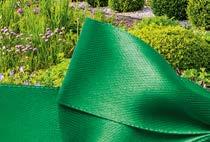












ANOTHER GREAT GIFT IDEA... Surprise a loved one with a subscription to The English Home. Filled with dreamy images of gorgeous houses, every issue includes useful advice for creating classical, elegant interiors in the quintessentially English style. 1 year (12 issues) for just £44.95 www.chelseamagazines.com/CENHXM22 Call +44 (0)1858 438 889 quoting CENHXM22 THE PERFECT CHRISTMAS GIFT The Celebrating homegrown craftsmanship, makers & style BRITISH BY DESIGN Four charming, characterful,forever homes in rural settings COUNTRY INTERIORS ENGLIS HOME Celebrating the essence of English styleSeptember 2022 Issue 211 £4.99 UK Edition 22 cover SHUTTERSTOCKDelivered every month, it’s the gift that keeps on giving! • Take a creative course • Explore British vineyards period homes Georgian Give a gift subscription to TheEnglishGardenthis Christmas and treat a friend to beautiful gardens and valuable planting advice throughout the year. 1 year (13 issues) for just £44.95 (usually £80) – that’s a saving of 43% TO SUBSCRIBE www.chelseamagazines.com/ CTEGXM22 or Call +44 (0)1858 438 833 quoting CTEGXM22 *Free gift available for subscriptions delivered to the UK mainland only. Your free gift will be delivered within 28 days to the bill payer’s address. All gift subscriptions will start with the rst issue published after Christmas. Free gift is subject to availability, we reserve the right to exchange for an alternative item. SAVE OVER 35% SAVE OVER 43% PLUS FREE Stoneglow - Rose Petal & May Chang scented candle WORTH £20* Gold Leaf deerskin gardening gloves WORTH £14.99*
Light up the Night
Use lights to extend the time you spend in the garden as shorter autumn evenings draw in. Professionals can install systems to highlight specimen trees, steps or paths, but even a simple string of festoon lights or candles will jolly up a table this Bonfire Night. Ultimate Connect 5m Warm White Festoon Lights, £59.99. Tel: 01423 816040; lights4fun.co.uk.
 WORDS HAMBLY. ARE CORRECT AT THE TIME OF GOING
WORDS HAMBLY. ARE CORRECT AT THE TIME OF GOING
NOVEMBER 2022 THE ENGLISH GARDEN 19
VIVIENNE
ALL PRICES
TO PRESS.
Garden Zone Beta5 ring bollard light, £76.50. Tel: 0345 6052505; worm.co.uk


Elipta chatham wall light in solid brass, £62.40. Tel: 01462 486777; lightingforgardens.com

Smart Garden Avant black solar-powered stake light, pack of 5, £25. Tel: 0333 0143357; diy.com
Hunza adjustable wall spot in copper, £162. Tel: 020 7602 5757; hollowaysofludlow.com



Beam solar shed light, £19.99. thesolarcentre.co.uk

Gold Aurelia hurricane lantern, £49. Tel: 01572 759190; ellajames.co.uk


Oslo outdoor hanging lantern £210.60. Tel: 0345 6052505; worm.co.uk

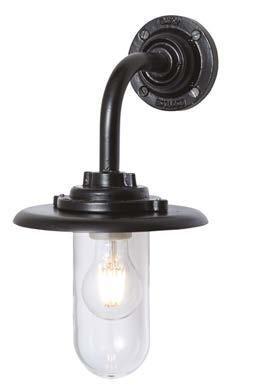
Limehouse pagoda wall lantern, £649. Tel: 020 7602 5757; hollowaysofludlow.com
Murcia rustic fire pit £299. Tel: 0330 0584158; limelace.co.uk


20 THE ENGLISH GARDEN NOVEMBER 2022

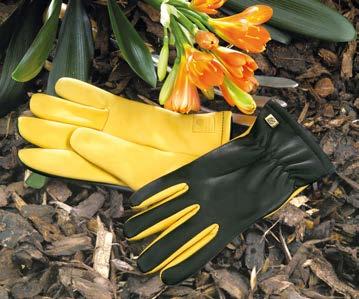




The World’s Finest Gardening Gloves Superior Deerskin Gardening Gloves by GOLD LEAF NOTHING COMPARES! Telephone: +44 (0)23 8040 2025 Website: www.goldleaf-gloves.com Endorsed by DISCOVER • REVIEW • SHARE ® The Royal Horticultural Society. The Royal Horticultural Society, and its logo, are trademarks of The Royal Horticultural Society (Registered Charity No 222879/SC038262) and used under licence from RHS Enterprises Limited.
The temperatures may be dropping, but trees glow with warm colour at Gresgarth Hall on a frosty November day.

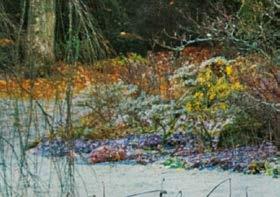



It may look sublime in its late-autumn finery, but for self-confessed perfectionist Arabella Lennox-Boyd there is always work to be done at Gresgarth Hall in Lancashire for “no garden is set in aspic”



 WORDS STEFAN BUCZACKI PHOTOGRAPHS KAT WEATHERILL Price of PERFECTION
WORDS STEFAN BUCZACKI PHOTOGRAPHS KAT WEATHERILL Price of PERFECTION
The

Above The terrace by the house was the first area Arabella began to develop, followed by the beautiful centrepiece lake that sits below it.
Right Part of an exquisite pebble mosaic, by Maggy Howarth, within a small, hedged garden.


Anyone who can say, almost as a throw-away remark “We now have about a hundred magnolias” is self-evidently a garden owner with a profound knowledge of trees, and, also self-evidently, has the space in which to grow them. That owner is a woman whose name has, for me, long been a byword for garden design skills of the highest, almost peerless, quality. She is Arabella Lennox-Boyd and it is a special joy for me to return, after a gap of several years, to her garden, Gresgarth Hall, in Caton, near Lancaster.
We spend a quite magical afternoon together, walking the many paths at Gresgarth Hall, admiring the extraordinary diversity and quality of its planting, discussing the challenges such a remarkable garden presents, and comparing ideas about resolving the horticultural questions that individual plants pose.

24 THE ENGLISH GARDEN NOVEMBER 2022
When Arabella and her husband, the former Conservative MP and government minister Sir Mark Lennox-Boyd, bought Gresgarth some 40 years ago, they found themselves with a striking house in an unashamedly Gothic style dating from around 1810, together with 12 acres in a valley through which flows Artle Beck, a tributary of the River Lune. This was land that had once been gardened and landscaped and bore some noble old trees –magnificent Cryptomeria japonica among others – but before the Lennox-Boyds’ arrival, neglect had replaced horticulture.

The Gresgarth site is geologically complex and its soils are variable with an average pH between 6 and 7 but more acidic pockets where rhododendrons thrive and some areas of truly thick and unyielding clay. It is reliably moist thanks to the numerous underlying natural springs. But so much of the place – not least the wet north-west climate – was alien to Arabella’s Italian heritage. She was unfamiliar with Lancashire Gothic, and her own English gardening experience had previously been confined to London. Gresgarth was to be a long learning curve.
Did she have a masterplan? The answer is no, the plan came much later, and she explains that she had turned her skills first to the terrace adjoining the house, which she widened and filled with containers that on my visit are redolent with late-season colour and fragrance. This is where her Italian influence is at its most sensual and is the area, she says, that still gives her the greatest satisfaction. After reworking and planting this terrace, Arabella turned her attention to excavating the beautiful large lake – now bereft of fish thanks to the local otters – that graces the centre of the garden, although, as I come to learn, as is the case with the rest of Gresgarth, nothing can be left alone and it will have to be dredged next year.
Arabella’s sense of colour and of ‘right plant, right place’ is remarkable and compelling. She expresses dissatisfaction with one predominantly white border because, she says, white is not appropriate for the English north-west. And, as we round a hedge and a fine group of heleniums present themselves, they are condemned for being orange. I say I love them. “They are all right, but not here,” comes the response. “They need approaching from a di erent direction.” In another bed, I admire a fine mature specimen of Eryngium pandanifolium. “We must move that,” says Arabella. “It’s now too big.”
There is no question of letting sleeping dogs – or herbaceous borders – lie at Gresgarth. Arabella seems constantly to be making mental notes as we

 Above Autumn-flushed leaves on a hydrangea with a lingering fine antique-pink bloom. Below The Gothic hall is perfectly set o by the sinuous lake, excavated soon after the LennoxBoyds moved in, with the gardens around it.
Above Autumn-flushed leaves on a hydrangea with a lingering fine antique-pink bloom. Below The Gothic hall is perfectly set o by the sinuous lake, excavated soon after the LennoxBoyds moved in, with the gardens around it.
The terrace is where her t e e s t ts ost se s is the area that gives her greatest satisfaction
NOVEMBER 2022 THE ENGLISH GARDEN 25



This was land that had once been gardened and landscaped and bore some noble old trees
26 THE ENGLISH GARDEN NOVEMBER 2022
 Trees turning gold and russet contrast with the deep green of a sharply clipped hedge and towering conifers.
Trees turning gold and russet contrast with the deep green of a sharply clipped hedge and towering conifers.
NOVEMBER 2022 THE ENGLISH GARDEN 27

 Arching branches of an acer, resplendent in its autumn colours, frame the white painted gate to the walled garden.
Arching branches of an acer, resplendent in its autumn colours, frame the white painted gate to the walled garden.
28 THE ENGLISH GARDEN NOVEMBER 2022
Above The decorative seedheads of grasses now at their frosted best. Left Fragrant skimmia still tightly in bud.

Below right The stone Meta Sudans sculpture in the birch wood.

Below left Wisteria, its foliage now butteryellow, twists around the red painted bridge.

walk. She admits she is a perfectionist, and that this is frustrating as it means nothing can ever be exactly right. “No garden is set in aspic,” she observes, which is why she returns regularly to so many of the 800-plus gardens she has designed for clients around the world to make suggestions and improvements.
The beck is crossed by an elegant bridge, painted red in the Japanese style – “The garden needed some red,” I am told – and we progress into a tree collection that would be the envy of many a dedicated arboretum. For all the glory of her herbaceous borders, trees are Arabella’s greatest love and she tells me how these hundred magnolias were acquired after her friend, the late Sir Peter Smithers, himself a highly knowledgeable plantsman, unwittingly threw down a gauntlet many years ago by telling her “All you will grow here are birch, willows and alder.” Gresgarth today is compelling evidence that even the most experienced can be wrong. The tree collection has added interest thanks to meticulous labelling by Arabella’s husband, Sir Mark, a designer and inventor in his own right who contributed features to the garden, including the Meta Sudans sculpture within the birch wood.
Were there things she had done, I ask, that she now regrets? “No, not regretted, but I wish I had known more when I started,” says Arabella. “I might have planted some things in di erent places.”
In one area, she took out masses of hated cherry laurel (Prunus laurocerasus) but found their absence let in the wind. The shelter returned only as her new tree plantings matured.

We watch as two of the gardeners (there are presently three at Gresgarth, though four are really needed), work under Arabella’s fairly firm direction in attempting to restore shape to a group of large Irish yews (Taxus baccata ‘Fastigiata’). Arabella is a woman who wears her learning lightly and modestly too, but as she watches the work, she is at considerable pains to try to persuade me that she is, herself, not a gardener. She is a designer and a plantswoman, she says, and feels she lacks the nuts and bolts of practical gardening knowledge. Not many would surmise that, but I like to describe her as someone who paints in four dimensions.
We reach the large kitchen garden that supplies the house with bounteous produce – there is an onion crop to die for. “We have every weed here you can imagine,” claims Arabella, although this is not at all obvious to me. I am then asked if the fruits on her exquisitely trained pears should be thinned out. I reply that I feel life is too short for thinning pears and that, if necessary, nature would shed any excess. Reassured, Arabella moves on.
For all the glory of her herbaceous borders, trees are Arabella’s greatest love
NOVEMBER 2022 THE ENGLISH GARDEN 29
A cluster of small greenhouses is Arabella’s personal propagating area and, as we enter, she immediately seizes a hose to water her precious cuttings and seedlings, all neatly labelled and many grown from wild seeds she has collected on her travels in Iran, Kazakhstan, Turkey and elsewhere.
I spot an extremely large slug on the path and we pause while Arabella photographs it. “Arion ater,” I note. She writes it down and we discuss the role of slugs in a garden’s wider scheme of life.
As we walk, I find things to entrance at every turn: we pass beneath a magnificent wisteria – whiteflowered in the spring – trained over a pergola, an echo of what Arabella had seen in Japan. She has never designed gardens there, and feels she does not understand enough of the symbolism, but she does always look at the light, as the Japanese do, and the way the light strikes a garden. In some of the
Top left Lichenencrusted rhubarb forcers below stepover apples in the walled kitchen garden.
Above right The glasshouses are where Arabella propagates cuttings and seed collected on her travels. Above left Pumpkins and ‘Turk’s Turban’ squash wait to be gathered.



borders, I remark on the e ectiveness of the many clumps of mildew-free phlox and her extensive use of salvias in great variety. Arabella thinks them ‘such a wonderful discovery’.
As our walk comes to an end and another season draws to a close at Gresgarth, it all reinforces my belief that this is a woman of surpassing talent and vision, whose skill and inspiring creativity has provided enduring pleasure for clients across the globe and who has contributed importantly to organisations such as Kew Gardens, of which she was a trustee for many years. But she does agree with me that a garden designer’s finest creation is, almost invariably, the garden they own. n
Gresgarth Hall, Caton, Lancashire LA2 9NB. The gardens open once a month, February to November. For details, visit arabellalennoxboyd.com
30 THE ENGLISH GARDEN NOVEMBER 2022









































www.jameswilkinsonblacksmith.co.uk BESPOKE METALWORK FROM DESIGN TO INSTALLATION Call: 07817 708 597









Generations of the Berkeley family have worked on Spetchley Park, resulting in mature layers of planting and extensive botanical riches that make these Worcestershire gardens something to treasure WORDS SANDRA LAWRENCE PHOTOGRAPHS CLIVE NICHOLS Amassed WEALTH

 Opposite The salmonpink foliage of Rhus typhina ‘Radiance’ is reflected among the waterlilies in the pool. This image Pathways are enlivened by Vitis vinifera ‘ Spetchley Red’.
Opposite The salmonpink foliage of Rhus typhina ‘Radiance’ is reflected among the waterlilies in the pool. This image Pathways are enlivened by Vitis vinifera ‘ Spetchley Red’.
The acid yellow of an ancient ginkgo, caught in the sun’s dwindling rays.

The shimmering pink-gold of a liquidambar, stark against a forgetme-not sky. The flutter of russet in a towering beech tree. Someone made this garden – but who? A most delightful quandary of being custodian of an historic estate is figuring out who was responsible for what, when nearly every member of a family has made their mark.

Spetchley Park Gardens, just outside Worcester, have been spectacular since at least the early 19th century – although which member of the Berkeley family first began the gardening here is unclear. The estate’s grand ‘landscape’ is easier to date: the deer park’s Royal Warrant was granted in 1625, and the lake was formed from the old manor house moat in 1834 to beautify the new Palladian mansion built in 1811. Other dates are harder to pin down. The best guess for Spetchley’s charming, Regency-style wrought iron bridges and romantic ‘root house’ gazebo, for instance, is ‘the 1830s’.

“Unfortunately, many records from the early days have been lost,” admits Chris Miller, who has worked at Spetchley for eleven years and was appointed head gardener in 2021. He is particularly interested in the gardens’ tangled history. Records are gradually being unearthed, but even as some tantalising new titbit emerges, more questions arise.
To take one example, for many years it was believed that famous Edwardian gardener Ellen Willmott was responsible for the gardens here, since her sister Rose had married into the Berkeley family. It now appears that Rose was a fine gardener in her own right, breeding and cultivating prize-winning varieties, showing at Chelsea and corresponding with the great horticultural figures of the day. The Willmott sisters were deeply devoted to one another, and while Mrs Berkeley would have discussed plantings with Ellen, decisions made at Spetchley were her own. What Ellen was responsible for, however, was photographing the garden. Ellen’s images of Rose digging the borders and her nieces and nephew playing by the fountain or fishing in the ornamental stream, help Chris with dating and planting. Other pictures, of wounded WWI soldiers enjoying open-air Shakespeare productions or Edward Elgar fishing in the lake during a weekend house party, help us all understand early 20th-century estate life.
“Elgar was a schoolboy across the road,” says Chris. “Years later, he signed the visitor’s book with a line from his ‘The
Top Feathery turning foliage of Taxodium distichum ‘Nutans’. Middle Fallen leaves of Cercis canadensis ‘Forest Pansy’. This image A view across the lake to the house.
A most delightful quandary of being custodian of an h stor est te s fi r o t who was responsible for what
34 THE ENGLISH GARDEN NOVEMBER 2022

 A white metal bridge spans a canal, whose surface appears scattered with gold.
A white metal bridge spans a canal, whose surface appears scattered with gold.
Dream of Gerontius’: ‘the summer wind among the lofty pines’”. Chris points out some Corsican pines towering over the Copse: ever since, those trees have been considered the composer’s ‘lofty pines’. It is perhaps best whispered that Chris’s team have counted the rings of a felled pine and in 1869 these specimens would have been ‘lofty’ only to a very short schoolboy from a very long way away...
The pines were there in Rose and Ellen’s day, however, as were the famous clipped yew ‘rooms’ around the Fountain Garden. “There are di erent accounts of what was planted in here,” admits Chris. “The rooms may have been for di erent botanical families, or perhaps a da odil nursery.” With da odils, as ever, the Willmott sisters worked together and joined syndicates to buy expensive bulbs, then bred and shared their own varieties. Since subsequent plantings have made it unclear as to exactly what was here at any particular point, there is some leeway in planting. “We have a lot of heritage da odils so we’re going to grow more of them here,” says Chris.
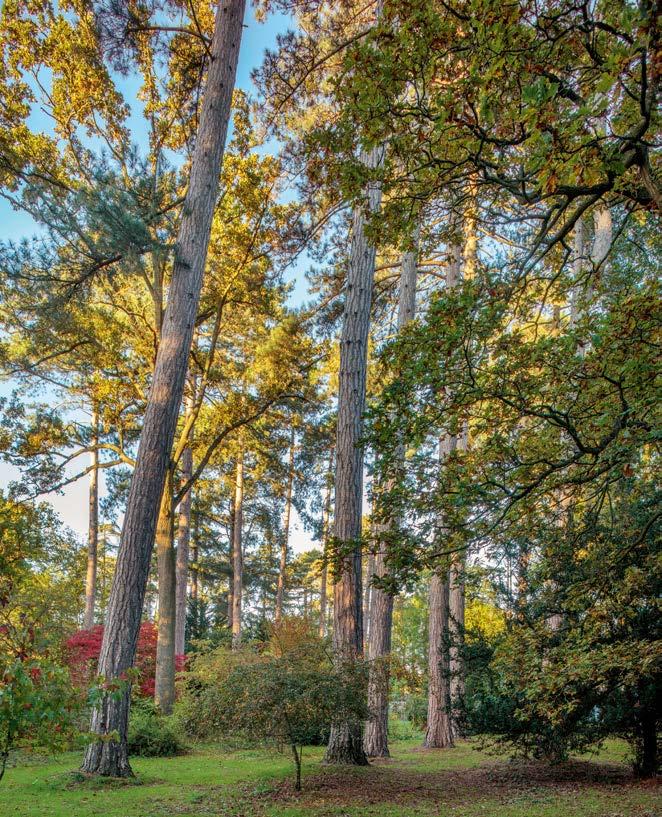
The Fountain Garden enjoys plants of interest at any time of year, but other areas are at their heady best in late autumn. In the south border, spent heads of Verbena bonariensis and Physalis alkekengi


peep through dense herbaceous plantings, evoking memories of the past rather than slavishly copying any single era. Blueprints have just been discovered for the classical temple that punctuates the border, built for Rose by her devoted husband, Robert Valentine Berkeley. After Rose’s death in 1922, a devastated Robert Valentine – and an equally distraught Ellen Willmott – conspired to carve a secret message into its eves. Sharp-eyed visitors may still locate the words of Omar Khayyam: ‘The Moon of Heaven is rising once again; / How oft hereafter rising shall she look / Through this same garden after me – in vain.’
With his sister-in-law’s advice, Robert Valentine did his best to continue his wife’s garden, but it was his son who took Spetchley to the next level. Large quantities of catalogues, society memberships, bills and receipts are turning up in the archives, proving that Captain Robert Berkeley was just as fixated with plants as his mother and aunt. Spetchley had opened once a year for the National Garden Society since the movement’s birth, but in the 1950s the Captain formally opened his grounds to the public.
Above Towering Corsican pines in the Copse date back to the 19th century.
Right Candy-pink berries of Sorbus ‘Pink Pearl’.
Below The spectacular leaves of Melianthus major surround the water feature in the walled Fountain Garden.
The Willmott sisters joined syndicates to buy expensive bulbs, then bred and shared their own varieties
36 THE ENGLISH GARDEN NOVEMBER 2022

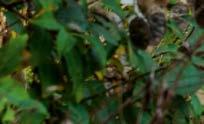 The crimson glory vine, Vitis coignetiae, scrambles through the trees, while bronze herons guard a pool.
The crimson glory vine, Vitis coignetiae, scrambles through the trees, while bronze herons guard a pool.



38 THE ENGLISH GARDEN NOVEMBER 2022 Handmade armillary, horizontal and vertical sundials +44 1873 840 297 • www.bordersundials.co.uk Border Sundials
Above The silhouettes of trees are reflected in the still waters of the lake in the glow an evening sun.

Left Buttery American yellowwood, Cladrastis kentukea ‘Perkins Pink’.

Below At Spetchley, purple-bronze Cercis canadensis ‘Forest Pansy’ is painstakingly trained over a pergola.
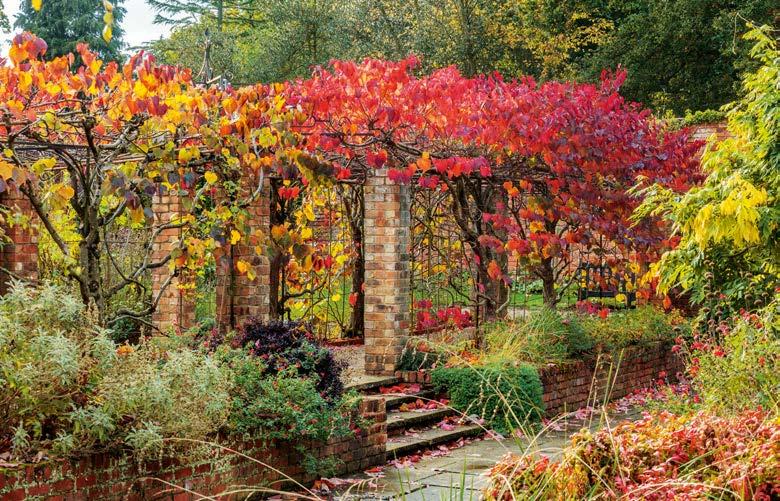
“It was marvellous being directed by somebody with such passion,” he recalls, “and it was incredible the number of plants he would buy.” No stick-in-themud, Mr Berkeley was happy to remodel the garden, especially when it involved buying even more plants.
Spetchley’s 1920s tennis courts are now the fabulous Millennium Garden. “It was designed with the changing climate in mind,” says Chris, “using a lot of Mediterranean plants. The soil has a high mineral content because it was where they used to dump the clinker from the house’s boilers.” Designer Veronica Cross had to work around another of John Berkeley’s purchases, an original Foster & Pearson glasshouse bought from West Mercia Police when they took over Hindlip Hall in the 1970s. Complete with ‘beaver-tail’ glass for directing rainwater away from the structure’s ribs, it is home to a giant vine. Perhaps the most unusual feature in this area, however, is the Cercis canadensis ‘Forest Pansy’, whose autumnal, orange-bronze-purple foliage romps across the pergola. “It’s tricky to train,” admits Chris. “The wood can become brittle, but the e ect is wonderful.” The cercis contrasts with Vitis vinifera ‘Spetchley Red’. “Mostly it’s a boring green but at this time of year the colour is magnificent.”
Spetchley is ever-changing. In keeping with a new, more ecological approach, a Victorian conservatory
Chris Miller began working at Spetchley while Captain Berkeley’s son, John Berkeley, was still alive.
NOVEMBER 2022 THE ENGLISH GARDEN 39
will no longer be heated and will instead host hardier specimens. Outside, Versailles planters based on originals brought from Ellen Willmott’s Essex garden burst with the seedheads of agapanthus. A large area, gardened by Captain Berkeley’s daughter, Juliet, until her death in 2019, is set to be transformed. Chris hopes it will include a memorial to Miss Juliet: “She was a true plantswoman.”
Henry and Kate Berkeley remain as passionate as their predecessors. They are keen to revitalise Spetchley’s Kitchen Garden, which, in a few short years, has become both stunning and productive.

Spetchley’s gardens are filled with stories and it is worth catching one of the four gardeners or equally
Top A haze of burnished gold is provided by the trees Metasequoia glyptostroboides and Nyssa sylvatica

Above More recently, the beautiful and productive Kitchen Garden has been developed by Spetchley’s current custodians, Henry and Kate Berkeley.
passionate volunteers to hear some of them. On any day you might learn of the northernmost cork oak in Europe, or the cedars of Lebanon that have been linked with John Evelyn, brought back by an early Berkeley grand tourist. The fate of the crownless cedar on the cork lawn changes according to the tale-teller. Victim of a lightning strike or a WWII American pilot flying too close while waving to friends below? Take your pick…
Ultimately, the gardens of Spetchley Park are the accomplished product of its many creators and are accordingly filled with great variety. “One of the best things about this garden is the many layers of underplanting that have been allowed to develop over time,” says Chris. “We have martagon lilies in our long walk; Colchicum autumnale, tulips, Lilium monodelphum and Crocus tommasinianus growing wherever they like.” Only a garden that has enjoyed multiple generations of passionate plantspeople can boast such riches. n
Spetchley Park Gardens, Spetchley, Worcestershire WR5 1RS. Open 22 March to 29 September 2023. Tel: 01905 345213; spetchleyparkestate.co.uk
The fate of the crownless cedar on the cork lawn changes according to the tale-teller…
40 THE ENGLISH GARDEN NOVEMBER 2022














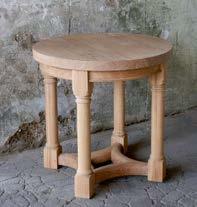

















32 Bourne Lane, Much Hadham, Hertfordshire SG10 6ER, UK. Tel 01279 842685 www.the ron ecollection.com 32 Bourne Lane, Much Hadham, Hertfordshire SG10 6ER, UK. Tel 01279 842685 www.the ron ecollection.com Chicken 10 - 19 cms high Alley Cat Looking Straight 49 cms Cockerel 16 - 40 cms high Alley Cat Looking Left 49 cms Hippo 17 cms long Girl with bowl 86 cms High Lizard 13 - 29 cms long Crayfish Curled 30 cms Long Cheshire Cat 40 cms long Girl reading book 65 cms Long Frog 12 - 28 cms long Toad 12 cms long Lantern 49 cms highChinese Temple Lions 30 cms high www.andrewcrace.com Genuine British Products. Crafted and made in the K Made from hardwood roko or Oak Griffin 72 cms Long



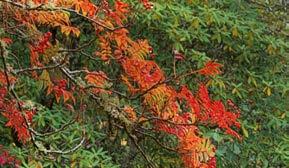




 WORDS LOUISE CURLEY PHOTOGRAPHS RAY COX SPOT
WORDS LOUISE CURLEY PHOTOGRAPHS RAY COX SPOT
On the windy north-west coast of Scotland lies the astonishing Inverewe, where planting pockets cut into the sheltering pine forest and the warming effects of the North Atlantic Drift have allowed an almost tropical garden to flourish
THE HOT

 Darmera peltata flanks the Rhododendron Walk at Inverewe, turning dramatic shades of yellow and red in the acid soil in autumn.
Darmera peltata flanks the Rhododendron Walk at Inverewe, turning dramatic shades of yellow and red in the acid soil in autumn.
NOVEMBER 2022 THE ENGLISH GARDEN 43
The north-west coast of mainland Scotland is a wild and windswept place, a rugged land of rocky inlets, glistening lochs and majestic Caledonian pines, above which golden eagles soar. This remote wilderness seems an unlikely spot for any garden, but on the shores of Loch Ewe is Inverewe, a 50-acre oasis of lush and colourful plants from around the world with a spectacular loch-side walled garden that has breathtaking views of the mountains of Torridon beyond.
Inverewe was the vision of landowner Osgood Mackenzie who moved there aged 21 in 1863 with his mother, Lady Mary Mackenzie of Gairloch. While Lady Mary set about building a grand home on a rocky spit of land overlooking Loch Ewe, Osgood turned his attention to making a garden. “On guided walks I’ll point to the area across the loch to show visitors what the land at Inverewe would have looked like before Osgood created the garden here,” explains Kevin Ball, Inverewe’s head gardener. “Osgood talks in his memoirs about there being only two willows growing on the peninsula. There was nothing here apart from heather, crowberry and willow. It was a barren landscape.” Add to this the thin, acidic, peaty soil, high rainfall and salt-laden winds that sweep in o the Atlantic and creating a garden in such a place seems like a crazy idea. But, undaunted, that’s just what he did.
One advantage of the garden’s location and a reason why such a diverse collection of plants can grow here is the warming influence of the North Atlantic Drift, which means that despite being on the same northerly latitude as Hudson Bay in Canada, Inverewe enjoys a much milder climate.
Osgood started by planting acres of trees, mainly the native Scots pine, to establish a shelterbelt. “Without this there wouldn’t be a garden here on what is one of the windiest coastlines in the world,” says Kevin. He also built a south-facing walled garden below the house on a strip of raised beach. Wherever Osgood planted, he needed to bring in soil by the cartload – particularly in the walled garden, where it was used to form the terraces that shelve down towards the shore of the loch.

Rather than following any kind of a grand masterplan, the rest of the garden evolved as Osgood observed how the shelterbelt was creating a microclimate. “Into the plantations of pines he started to cut pockets, filling them with more exotic species from Asia, Australia and New Zealand. One of the first of these areas was at the back of the house, which we now call Bambooselem after Osgood’s original plantings of bamboos,” says Kevin. “There are a number of Champion Trees located here, including the biggest podocarpus in the UK and a magnificent Magnolia campbellii, the largest in Scotland, which was planted in around
Right In the walled garden, south-facing terraces slope down towards the shore.

Bottom right Glowing vibrant scarlet, Acer palmatum ‘Elegans’. Bottom left The Loch Ewe shoreline reveals just how inhospitable conditions are here for making a garden.
Below From Argentina, Polylepis australis, known for its peeling bark.


44 THE ENGLISH GARDEN NOVEMBER 2022
1914. It’s a really impressive sight in spring when it’s covered in a mass of pink flowers.”

A network of crisscrossing paths takes you on a journey through a global collection of plants continued by Osgood’s daughter Mairi (a knowledgeable plantswoman in her own right) following her father’s death in 1922, and added to by successive gardeners after the garden was bequeathed to the National Trust for Scotland in 1952. There are towering Californian redwoods; eucalyptus from Tasmania, where the climate is similar to that of North West Scotland; phormiums and tree ferns from New Zealand; and the orangebarked Chilean myrtle, Luma apiculata, whose pretty white flowers bloom from summer into autumn. Inverewe’s national plant collections include three sub-sections of rhododendron, as well as olearia and aeonium. “We have a lovely collection

NOVEMBER 2022 THE ENGLISH GARDEN 45
of eucryphia too, which is a classic west coast garden plant,” says Kevin. “Shrubs or small trees, they have glossy, evergreen leaves and produce pretty flowers, which look like wild roses, from July to September.”
The spring and summer months bring a succession of colour from magnificent rhododendrons to roses, perennials and South African plants in the walled garden. The mild climate here blurs the lines between summer and autumn, so while the branches of sorbus trees with their gleaming red berries and acers that glow with fiery hues provide a classic autumn scene, you’ll turn a corner and find tender

Above The handsome evergreen tree Eucryphia x intermedia ‘Rostrevor’ is covered in large white flowers from late summer into autumn.
plants and annuals still blooming and the South African natives watsonia and schizostylis defying the shortening days with their vibrant flowers.
The legacy of creating a garden in such an extreme environment combined with the specific problems created by climate change does make caring for Inverewe a tricky task for Kevin and his team of ten gardeners. Problems include the peaty soil, which Kevin says is notoriously hard to re-wet after a dry spell; heavy winter rainfall that leaches nutrients from the soil; and the increasingly ferocious storms – most recently Storm Corrie, which caused significant damage in January 2022. “We lost more than 70 trees and 90 rhododendrons, mainly in the north side of the garden,” says Kevin. “The wind doesn’t normally come from that direction, and it was really upsetting for us to see the damage, but the 2005 storm was worse and the garden bounced back from that. We’ll have to reassess how we replant the shelterbelt. We’d already started to plant trees such as nothofagus from Chile, which will hopefully be better able to cope with our changing climate.”
Pest and disease management has become an increasingly important part of the job too. Under licence from the Scottish government, larch planted by Osgood had to be removed because of the disease Phytophthora ramorum. “Removing trees is sad and it isn’t straightforward because trees that grow closely together get used to growing like that and come to rely on each other, so removing trees makes the fringe trees more vulnerable.”
Rhododendron ponticum is a plant that’s hard to escape in this part of the world. It was introduced by Victorian landowners, including Osgood, who had no idea of the havoc it would wreak. “One of these plants can produce a million seeds, and when its branches grow heavy with age and come into contact with the soil, they form roots,” explains Kevin. “Its dominance can then push out native plants.” As part of Project Wipeout, set up by the National Trust for Scotland, the team at Inverewe have not only removed about 90 per cent of R. ponticum, they are also turning the remains into biochar after Kevin applied for funding to buy specialist equipment. Biochar, a charcoal-like product, is said to have a whole range of benefits,
46 THE ENGLISH GARDEN NOVEMBER 2022
Tough & TENDER
The autumn palette at Inverewe contains tender treasures and more familiar specimens
ABELIA SCHUMANNII
This semi-evergreen shrub has reddish branches and fragrant pink flowers.

FASCICULARIA BICOLOR
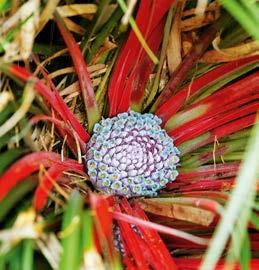
Excellent drainage to prevent waterlogging is key to growing this bromeliad.
from neutralising acidity and improving water and nutrient retention to aerating soil and providing habitats for soil microbes.
CUPHEA CYANEA
The colourful cigar plant is a half-hardy perennial in most parts of the UK, so needs protection from frost.

LUMA APICULATA
A large evergreen shrub with aromatic foliage and lots of small white flowers. Hardy in most parts of the UK.

NERINE BOWDENII

A sunny, sheltered spot suits these autumn-flowering bulbs best, here paired with Pittosporum ‘Tom Thumb’.

COTONEASTER FRIGIDUS
A bushy shrub or small tree bedecked with generous clusters of red autumn berries.

Above Treasures are massed together in the drive border, including abelia and Sparrmannia africana, a large-leaved shrub originating from Africa and Madagascar.
“We add it to our compost – a system we’re very proud of,” says Kevin “We aim for a 30:1 mix of woody, carbon-rich material to greens, using grass in summer and seaweed gathered from the beach in autumn. We also use a probe that’s plunged into the compost and tells us when the temperature inside the heap reaches 55°C – the optimum temperature to kill o weed seeds and diseases such as Phytophthora. We’re able to make compost in just six months, something that is really important here because we need to keep on replenishing the soil.”
Despite all these challenges Kevin is determined that the garden retains the spirit of its creators, Osgood and Mairi. “I’ve worked here since 2000 and it’s the sense of place that makes this garden so special – that and the sheer diversity of plants that we can grow here. We’re always looking to introduce new and exciting plants, just as Osgood did, and push the boundaries of what will grow this far north. I never get bored here.” n
Inverewe, Poolewe, Achnasheen, Wester Ross, Inverness-shire IV22 2LG. Opens 9.45am to 4pm, Tuesday to Saturday, until 29 October. Reopens in April 2023. Tel: 01445 712952; nts.org.uk
NOVEMBER 2022 THE ENGLISH GARDEN 47
in the


Made wi Pride Co wolds
If you love your garden, you’ll know it takes time and care to create something truly wonderful.
That’s why we put our faith in traditional joinery techniques such as mortise and tenon joints to give our greenhouses strength and integrity.
Using only the highest quality Western Red Cedar. Handcrafted in our Cotswold workshops.
No wonder Gabriel Ash are the only timber greenhouses endorsed by the Royal Horticultural Society (RHS).






For a Free Brochure call 01242 662 926 or visit gabrielash.com.



See us at selected independent Garden Centres, RHS Gardens or our Gloucester showroom.




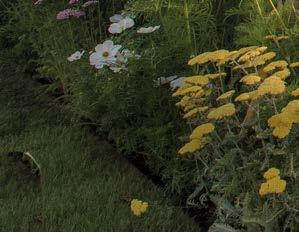 The Portico
The Portico
®The Royal Horticultural Society. The Royal Horticultural Society, and its logo, are trade marks of The Royal Horticultural Society. (Registered Charity No. 222879/SC038262) and used under licence from RHS Enterprises Limited.
RHS
Living HISTORY

Thirteenth-century Brockholds Manor in Hertfordshire is imbued with a sense of the past, from venerable old trees to an ancient moat and listed outhouses. Its owners aim to tread lightly, preserving its heritage while adapting the garden to withstand a changing climate
 WORDS NIC WILSON PHOTOGRAPHS ANNA OMIOTEK-TOTT
WORDS NIC WILSON PHOTOGRAPHS ANNA OMIOTEK-TOTT
An old ‘Howgate Wonder’ apple tree forms a venerable centrepiece at Brockholds Manor.
The garden at Brockholds Manor wears its autumn raiment with a relaxed charm. As the low afternoon sunlight falls across the lawn, it intensifies the warm butterscotch and to ee tones of the beech leaves and glints o the glossy scarlet Rosa rugosa hips in the hedges. In the borders, the textured seedheads of phlomis, sea hollies and alliums stand out against the clipped evergreen forms of box, yew and lollipop bay. This is a mellow garden; a place to linger and enjoy the soft luxury of autumn.

When Juliet and Richard Penn-Clark moved here in 2016, the garden was mostly roughly mown lawn surrounded by a tangle of brambles, thistles and nettles. Yet despite its overgrown state, they were excited by the potential of the three-acre site. As a child, Juliet had been fascinated by a visit to The Manor at Hemingford Grey in Cambridgeshire –one of the oldest continuously occupied properties in Britain. She was shown round by owner and author Lucy M. Boston and was completely drawn in by her ancient tales of the house and garden. Juliet feels that Brockholds Manor, which dates back to the early 13th century, has the same sense of heritage and timelessness about it.

Juliet, who works as an interior designer, enjoys the challenge of putting her mark on the garden while keeping the design in tune with the history of the site. She loves all the old features, including the groundfed moat at the edge of the woodland and the dried-up well, surrounded by towering self-seeded lovage on the terrace, delightful reminders of Brockholds Manor’s long history. Just in front of the terrace, roses twine over a picturesque tool shed that was originally a three-seater outdoor privy. This Grade-II listed outhouse nestles into the landscape, wreathed in the rambling rose ‘Francis E. Lester’ – just one of over 70 varieties in Juliet’s collection.
Over the past five years, Juliet and Richard have created a
long central herbaceous border, an orchard and a wildflower meadow, and they have developed the potager to provide vegetables and cut flowers for the house. On the north side of the long border, a series of garden rooms divided by clipped beech, yew and box hedging leads visitors through an eclectic range of styles and colour combinations.
Nearest the house, the White Garden fuses the subtle shades of irises, peonies and astrantias with the silver and glaucous foliage of Stachys byzantina and Brachyglottis greyi. Old roses such as Rosa ‘Madame Hardy’ with its ru ed, fully double blooms, and the milky-white fragrant flowers of R. ‘Alba Maxima’ complete this vision of elegance. Adjacent to the White Garden, the Prince Philip Garden, planted around the time of the Duke of Edinburgh’s death, smoulders in summer and early autumn with the fiery oranges and burnished coppers of Helenium ‘Sahin’s Early Flowerer’, Crocosmia x crocosmiiflora ‘Emily McKenzie’ and Achillea ‘Terracotta’.

Below Juliet and Richard Penn-Clark, owners of Brockholds Manor in Hertfordshire. Clockwise from top right Juliet has introduced hedging to create rooms; the listed outhouse, swathed in roses; a lingering rose bloom.
The final room in the trio – the Sculpture Garden –epitomises the spirit of the site with its fitting combination of the ancient, the quintessentially English and a striking modern minimalism. A Lutyens bench (a nod to the inspiration Juliet takes from the Arts & Crafts movement) faces what looks like a sinuous driftwood sculpture – actually a piece of timber from one of the original Medieval barns, discovered a few years ago in the moat. In contrast to the rest of the garden, the absence of plants in this yew-edged room concentrates the focus on the powerful juxtaposition of old and new.
As autumn gets into its stride, the sumptuous foliage of Cotinus ‘Flame’, Viburnum plicatum f. tomentosum ‘Mariesii’, Rhus typhina with its rusty-red seedheads, and the jet-black berries of Hypericum androsaemum take centre stage. Many stalwarts in the garden are still blooming, including Michaelmas daisies like
The low afternoon s ht te s fies the warm butterscotch and toffee tones of the beech
50 THE ENGLISH GARDEN NOVEMBER 2022
Symphyotrichum novi-belgii ‘Fellowship’, Aster x frikartii ‘MÖnch’ and S. novae-angliae ‘Andenken an Paul Gerber’, their composite flowerheads providing an important source of nectar for lateflying pollinators. A few tenacious roses like Rosa ‘Claire Austin’, whose soft creamy blooms wind around an obelisk in the White Garden, even persist into January and beyond.

A beautiful, gnarled ‘Howgate Wonder’ apple presides over the heart of the garden, spreading its generous canopy over the lawn. Laden with huge, red-flushed fruit in autumn, this was the only apple tree in the garden when the couple moved in and, after at least half a century of growth, it is still going strong. Juliet loves this cooking apple for its mellow sweetness and impressive size: “You can make crumble for four with just one apple,” she says with a smile. “They make Bramleys look small and you don’t need to add sugar: they’re so sweet.”


NOVEMBER 2022 THE ENGLISH GARDEN 51
 Smart black obelisks provide structure in the borders as the perennials die back and shrubs start to lose their leaves.
Smart black obelisks provide structure in the borders as the perennials die back and shrubs start to lose their leaves.
52 THE ENGLISH GARDEN NOVEMBER 2022
Alongside this venerable inhabitant, the new orchard has been planted with a diverse mix of fruit trees, including medlar, quince, apples, plums, damsons and greengages. As well as the spectacular show of spring blossom, which attracts bees and other pollinating insects, the orchard provides a harvest that extends well into autumn. Quince Cydonia oblonga ‘Meech’s Prolific’ crops heavily in October and the curiously puckered fruits of the common medlar (Mespilus germanica) are at their best when ‘bletted’ (softened) by the first frosts. Wildlife and the environment are central to the ethos of the garden and Juliet aims to tread lightly as she develops and manages the site. “It’s what we’d all like to do, but it is di cult,” she says. “I don’t want to kill things with chemicals and I want to give them as many opportunities to thrive as possible.”
In the mixed woodland to the north of the garden, standing and fallen dead wood has been left to create habitats for birds, mammals and invertebrates. Rosehips and seedheads provide food for birds such as thrushes and finches, and dead vegetation around the garden is left as shelter over the winter months.
Juliet is a passionate advocate for composting. She learnt from her mother who always gardened organically and made her own compost. “I love to draw visitors into the composting and bugs. It’s the teeny things that I’ve always loved. Ecologically, if they go, we’re toast.” Knowing her commitment to composting, just three weeks after they moved in, Juliet’s husband and daughter built her three
Top Clipped features like this tidy circle of box work to counterbalance the borders’ loose, seasonal wooliness. Above right Frosted hips of Rosa rugosa Above left The whorled seedheads of phlomis, or Jerusalem sage, look wonderful left to stand in autumn and winter.



Quince crops heavily in October and the curiously puckered fruits of the common medlar are at their best when ‘bletted’ by the first frosts
NOVEMBER 2022 THE ENGLISH GARDEN 53
compost bins for her birthday. These bins have grown over the years and seven heaps now produce the organic lifeblood of the garden.
Having grown up on clay, Juliet has found that the soil here couldn’t be more di erent. “What we have here is a very dry, lovely loam,” she explains, “but the water just runs through it.” Even with lots of compost, the garden su ered in the heatwave this summer. With long-term plans to make the planting more resistant to climate change and develop a wider range of habitats, this new garden on an old site is adapting to face the challenges of the future.
For her next project, Juliet hopes to encourage more wildlife into the moat while also making it possible for her to swim in, so she can recapture some of the precious experience of spending time by the Great River Ouse as a child. She feels at home at Brockholds Manor where the glorious views out to the borrowed landscape remind her of the huge skies of East Anglia and the edge of the fens. “I feel very much connected to the house and garden, the landscape and the weather,” she reflects. It’s obvious as you walk through the garden: her love for Brockholds Manor shines out of every border. n
Brockholds Manor, Brockholds, Old Hall Green, Hertfordshire SG11 1HE. Opens for the National Garden Scheme on selected dates and to groups by appointment from 1 February to 30 November. Tel: 01920 822113; brockholdsmanor.com; ngs.org.uk

Above The property has a history dating back to the 13th century, which Juliet loves to preserve and highlight through the garden’s design. Below In the vegetable garden, raised beds house crops around an impressive lollipop of bay in the centre.

At Brockholds Manor the glorious views out to the borrowed landscape remind Juliet of the huge skies of East Anglia and the edge of the fens
54 THE ENGLISH GARDEN NOVEMBER 2022
Handmade Garden Art
The Perfect Gift for Gardeners
Designed & Hand crafted in Devon, Mr Fox’s Garden offers a beautiful selection of metal sculptures and plant supports. Check our website for fun and rustic festive decorations as well as a wide range of pieces to add structure and interest in your winter garden. Please visit at




MR FOX’S GARDEN
us
www.mrfoxsgarden.com | Tel: 01803 612370
Fire in the MIST
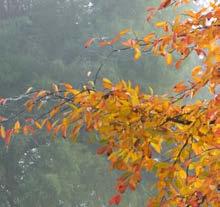






 Piercing the cool autumnal haze that hangs over the pools at Daws Hall on the EssexSussex border is a glorious array of beautifully shaped specimen trees, blazing with seasonal colour and adding interest to an intentionally naturalistic setting
WORDS & PHOTOGRAPHS NICOLA STOCKEN
Piercing the cool autumnal haze that hangs over the pools at Daws Hall on the EssexSussex border is a glorious array of beautifully shaped specimen trees, blazing with seasonal colour and adding interest to an intentionally naturalistic setting
WORDS & PHOTOGRAPHS NICOLA STOCKEN
 Set between two silvery streams, the brilliant red and gold autumn foliage of the tupelo, Nyssa sylvatica, shines through the early-morning mist.
Set between two silvery streams, the brilliant red and gold autumn foliage of the tupelo, Nyssa sylvatica, shines through the early-morning mist.
There is no escaping the autumnal East Anglian mists that drift up the River Stour and linger over the gardens of Daws Hall, shrouding trees that loom like mysterious wraith-like giants. Then, as the mist disperses it reveals the forms of ancient oaks and a Cedar of Lebanon that casts its reflection in a still pond – as it has for some 400 years – while a blaze of red, gold and orange foliage engulfs maples and nyssas, cotinus and liquidambars.
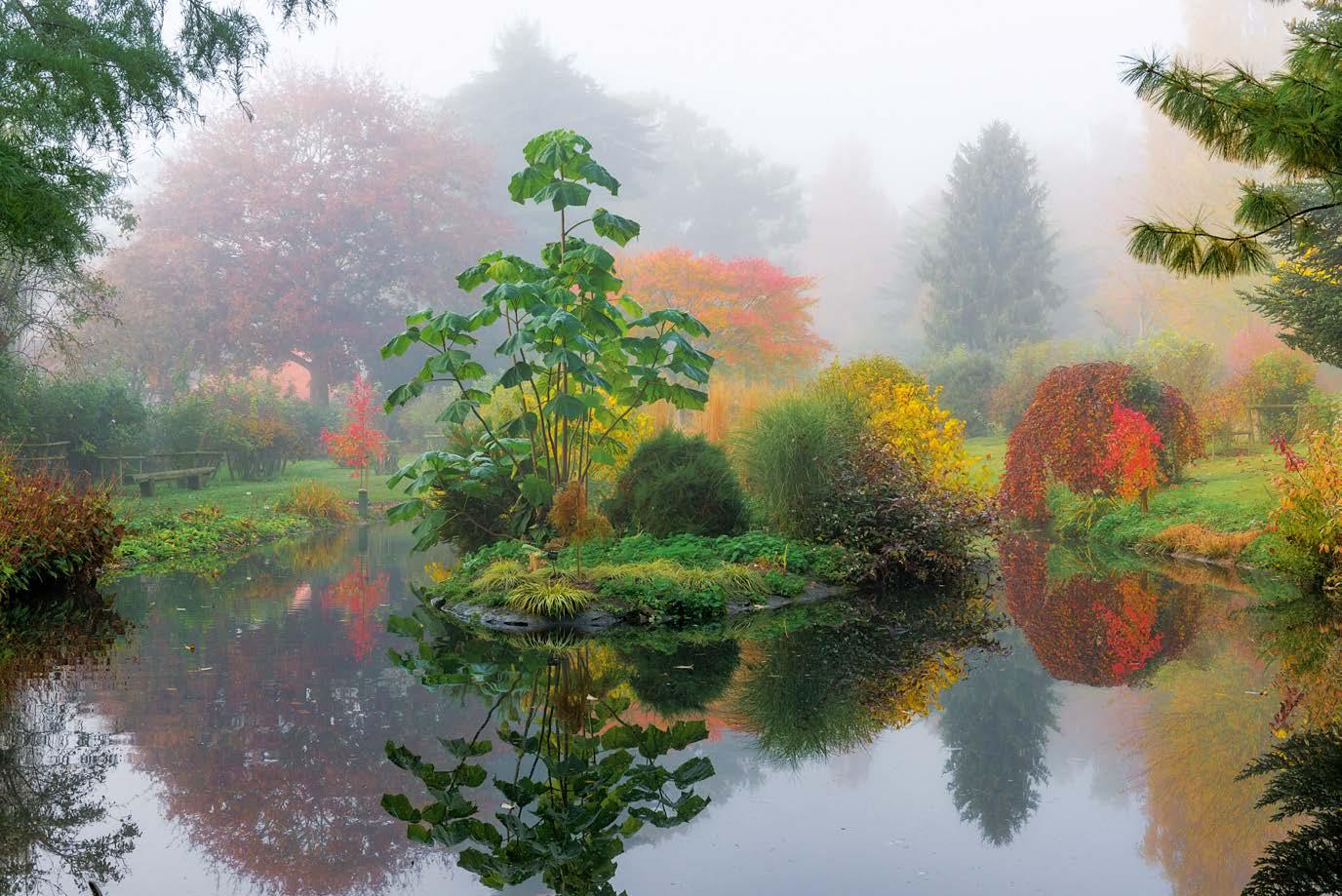
Set amid a patchwork of copses and fields near the village of Bures on the Su olk-Essex border, these 25 acres of woodland, ornamental gardens and nature reserve are the work of Major Iain Grahame who moved to Daws Hall in 1965 and immediately started planting trees. “It has been my life’s work since leaving the army,” says Iain. “If I have done anything worthwhile in my life, it has been to plant trees – and I’m still planting even now.”
It is nearing 60 years since Iain planted his first trees and watched them mature over the decades. Among the most spectacular are a
Above On an island, a coppiced foxglove tree, Paulownia tomentosa, is reflected perfectly in the still water, against a fiery backdrop of maple, birch, beech and tupelo.
Below A tiered wedding cake tree, Cornus controversa ‘Variegata’.
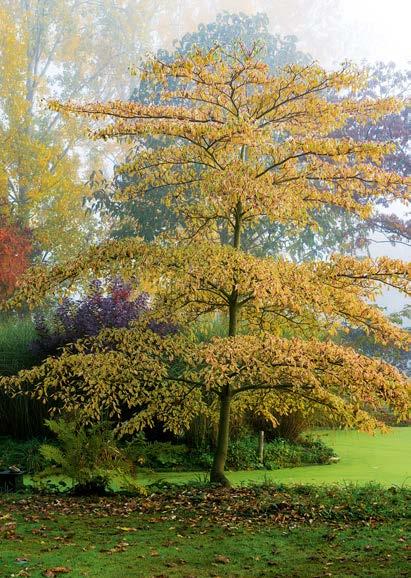
giant fir, Abies grandis; a coast redwood, Sequoia sempervirens; several swamp cypresses, Taxodium distichum; and a pair of fastigiate beeches, Fagus sylvatica ‘Dawyck’, which straddle the path leading down to the main pond. Each tree now serves as an anchor to smaller, neighbouring specimens.
“As each tree has matured, I have chosen plants to complement it, creating a balance of interest across the di erent seasons,” Iain explains.
It transpires that Iain started out with no horticultural experience.
“In the early days, I made a lot of mistakes,” he acknowledges. “I planted trees I liked, but soon learned to leave space for each one to mature without crowding out the others.” With light, slightly acidic soil, there were some losses initially. “But I continued planting in bursts, as and when I had the time and cash,” he adds. Acers featured early on, inspired by autumn visits to Westonbirt Arboretum during a year spent at the Royal Agricultural College in Cirencester.
Planting was interrupted in 1987 when The Great Storm uprooted beeches, many oaks and an ancient
58 THE ENGLISH GARDEN NOVEMBER 2022
Above Major Iain Grahame and his wife, the antiques expert Bunny Campione. Right Small but striking Acer japonicum ‘Aconitifolium’. Below A magnificent 300-year-old tulip tree, Liriodendron tulipifera, with butter-yellow foliage. Left Illuminating the banks of the stream, a colourful tupelo



mulberry tree. “Miraculously, a 300-year-old tulip tree beside the house was unscathed, but it took an entire year to clear the debris,” Iain remembers. He was helped by a young man called Jonathan Clarke who came to work in the gardens for 12 months and stayed for 35 years. “His contribution has been invaluable,” Iain maintains. The worst casualties were from a group of 50- and 60-year-old beeches and oaks in an area near the main pond. “It took a year to clear, but then there was a blank canvas and I could start afresh,” says Iain. Once cleared, a mass of wildflowers appeared – primroses, bluebells and violets – having lain dormant for many years.
Enriched from decades of falling leaves, the soil was good, so Iain began planting in earnest. By chance, one of his earlier introductions was a blue haze larch, Larix kaempferi, which is now registered as a Champion Tree in The Tree Register. Gradually, Iain learned to regularly trim back wayward branches to encourage beautiful forms, including that of a splendid golden maple, Acer cappadocicum ‘Aureum’, its perfectly balanced canopy carpeting the grass beneath with rich amber lobed leaves. “It has the most wonderful form, but we gently shaped it that way,” he points out.
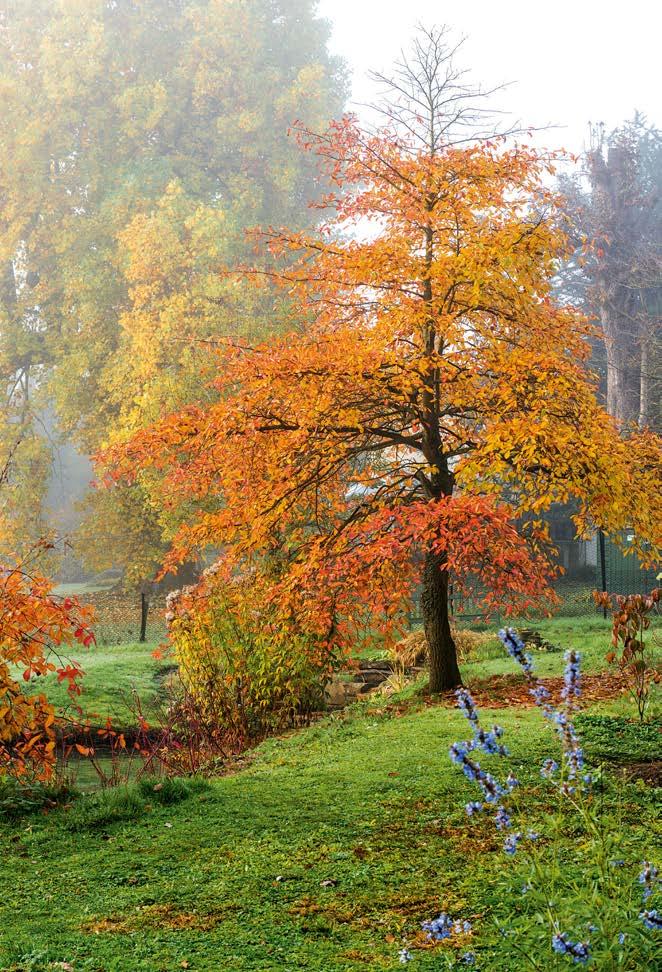
NOVEMBER 2022 THE ENGLISH GARDEN 59
It is a similar story with a mature coral bark maple, Acer palmatum ‘Sango-kaku’, which, after 20 years, looked rather poorly. “A visitor suggested we chop it back to the ground and, to our surprise, it sprouted a host of scarlet stems. Now we cut it back every two or three years,” says Iain. Acers feature throughout the arboretum, and he grows around 50 in all. “The family is so wonderfully varied, and many have such marvellous autumn colour.”
Iain also grows nyssa, or tupelo, which are slowgrowing and graceful and thrive in moist spots. “The first one I saw was reflected in the lake at She eld Park Gardens,” he recalls. “It was so magnificent, I asked a gardener for its name.” Fine examples of Nyssa sylvatica and Nyssa sinensis grow beside all three ponds, their brilliant red and gold leaves floating on the dark water. Iain believes this top pond could be the original Tudor clay pit and, some 40 years ago, he created a borehole to feed the main pond, which drains down to two smaller ponds and finally into a ‘scrape’ – a shallow depression that seasonally holds water for wading birds – and a dipping pond for visiting schoolchildren.
On the middle pond, an island is dominated by a coppiced foxglove tree, Paulownia tomentosa “I first saw one many years ago in Beth Chatto’s garden, but she told me it would be jolly di cult to get hold of one.” Iain remembers. He persisted, finally sourcing one several years later. “I soon discovered that foxglove trees grow like weeds here, throwing out their long suckers,” he says. As a result,
it is not unusual to see six metres of growth in a season, so each February, Iain coppices selected suckers, cutting out all but the four or five strongest stems. He also grows the rare Paulownia kawakamii which flowered for the first time here in 2018 and has a much more richly coloured flower than P. tomentosa.
As autumn deepens, Iain turns his attention to the task of collecting fallen leaves. “We have huge piles and hire a mini-digger to turn them over,” he explains. However, well-rotted leafmould has proved invaluable for helping young trees establish and for mulching to conserve moisture. “I’m pleased to say that we haven’t lost too many plants,” he notes.
Iain shares the garden with his wife, Bunny Campione, an expert who regularly appears on the BBC’s Antiques Roadshow. Recently, their grandchildren gave him a book on winter gardens which has inspired the division and naturalisation of snowdrops throughout the woodland. “A garden is forever a work in progress, and whereas some plantings work, there are inevitably those that disappoint, but, along the way, you are sure to discover much of interest,” he observes. n
Daws Hall, Henny Road, Lamarsh, Bures, Essex CO8 5EX. The garden and nature reserve are open for autumn colour on 23 October and 6 November (11am to 3pm). Details of other events and open days can be found at dawshallnature.co.uk
Top The burnished autumn leaves of Acer palmatum var. heptalobum grace both the tree and the dew-soaked grass.

Above Smokewood Cotinus ‘Grace’, has purple leaves that turn a vibrant red in autumn.

60 THE ENGLISH GARDEN NOVEMBER 2022













NOVEMBER 2022 THE ENGLISH GARDEN 61 Established for 20 years, Plankbridge shepherd’s huts are exclusively endorsed by the RHS © The Royal Horticultural Society 2020. Endorsed by the Royal Horticultural Society. Registered Charity No 222879/SC038262. rhs.org.uk plankbridge.com 01300 348414 Established for 20 years, Plankbridge shepherd’s huts are exclusively endorsed by the RHS © The Royal Horticultural Society 2020. Endorsed by the Royal Horticultural Society. Registered Charity No 222879/SC038262. rhs.org.uk plankbridge.com 01300 348414 www.andrewkaysculpture.co.uk Free UK delivery LIFE SIZE ANIMAL SCULPTURE www.andrewkaysculpture.co.uk 07740 306412 Free UK delivery LIFE SIZE ANIMAL SCULPTURE www.clavertoncloches.com +44 7521 467371 | enquiries@clavertoncloches.com CLAVERTON CLOCHES Exquisite Victorian cast-iron garden cloches. Designed and made in England for a lifetime of use.
Wonders of the West
Enjoy a four-day break taking in the idyllic gardens of Somerset and Dorset, arranged for readers of The English Garden by travel specialists, Sisley Garden Tours


There are gardens featured in these pages that we would love to visit – but not all open to the public or, if they do, it’s perhaps only for a day or two. Or they go on lists of ‘gardens to visit one day’, but arranging those visits never quite happens. Until now, for with Sisley Garden Tours, we’re excited to bring The English Garden to life with ‘Wonders of the West’, an exclusive four-day holiday in Somerset and Dorset in June next year.
“Our garden holidays are for people who are looking for exclusive access to beautiful gardens, good hotels and delicious food,” says Colette Walker, who runs Sisley Garden Tours with Fran Pride. Fran’s father-in-law Tony Sissons, a garden writer and plantsman, founded the company in 1992 before Fran and Colette took
over. Professionally trained guides, keen travellers and gardeners, Fran and Colette ensure their trips are relaxed and personal. Guests keep on returning to enjoy Sisley’s tours, which have o ered unrivalled access to private gardens for some 30 years.

The itinerary for our ‘Wonders of the West’ tour has been arranged to make the most of the location without making you feel rushed. One beautiful garden opens its gates to you followed by another – in a schedule that would be hard to replicate without Sisley’s behind-the-scenes access.
MONDAY 12 JUNE 2023
We’ll meet at The Eastbury Hotel in Sherborne, our four-star base for the tour. This family-run boutique hotel was originally designed as an 18th-century Georgian gentleman’s residence and exudes
warmth and character. The 2 AA Rosette restaurant o ers food made from homegrown produce and boasts views of the hotel’s charming walled garden.
In the afternoon, we’ll tour Dorset Walled Garden in Upper Sydling with its owner, Susanne Cooper. The garden was created in 2002, with more recent help from designers Julian and Isabel Bannerman. Expect roses, scented planting, imposing yew beehives and an expert floristry demonstration. Back in Sherborne, there’ll be time to taste local wine from Sherborne Castle Vineyard before dinner at the hotel.
TUESDAY 13 JUNE
In the morning, Bella Hoare will take us on a tour of her garden at Gasper Cottage on the Stourhead estate – where Bella’s ancestors lived before the family seat was
Dorset Walled Garden
Colette Walker & Fran Pride
Gasper Cottage
62 THE ENGLISH GARDEN NOVEMBER 2022
EXCLUSIVE GARDEN TOUR
taken on by the National Trust. Bella, an artist, loves colourful perennials and Oudolf-style planting. The garden is constantly in development: lawn often gives way to flowers and part of the orchard is currently being converted into a pollinator-attracting forest garden.
After lunch at a garden in nearby Bruton, we’ll head to Batcombe House in Shepton Mallet, the home of landscape designer Libby Russell. Enjoy a riot of colour in her kitchen terraces and borders and, on the other side, a grass amphitheatre o ering a calmer, more contemporary space with wide herbaceous borders. In the evening, guests are free to explore Sherborne and dine at their leisure.
WEDNESDAY 14 JUNE
The day starts with an exclusive tour of Mapperton House with Julie, Viscountess Hinchingbrooke, before the garden opens, followed by a private tour of the house.
Mapperton is known for its romantic gardens. Tucked into a steep-sided combe, they descend from formal topiary gardens and an orangery in the north to an arboretum in the south, beyond which the land unfolds down to the sea.

In the afternoon we’ll head to South Wood Farm, where head gardener Lewis O’Brien will show us around the Arne Maynard-designed country garden. Here, a 17th-century thatched house is surrounded by roses, herbaceous borders, yew topiary, wildflower meadows and a kitchen garden. After that, it’s back to the hotel for dinner.


THURSDAY 15 JUNE
On the fi nal morning we visit Highbridge House, home of racehorse trainer Paul Nicholls OBE, whose rose collection will be hitting its stride. Then it’s on to The Newt in Somerset. Formerly the home of Penelope Hobhouse’s family and then Nori and Sandra Pope, the garden has been reimagined by Patrice Taravella. After lunch and a Somerset cyder tasting, we’ll take a tour of the gardens, with extra time to explore, before returning to The Eastbury Hotel to say our goodbyes.
HOW TO BOOK
‘Wonders of the West’ tour to Somerset and Dorset 12-15 JUNE 2023

To book your place on our 2023 ‘Wonders of the West’ tour to Somerset and Dorset, visit sisley. co.uk/TEG, where you’ll find full details of the tour, how to book and terms and conditions. Spaces are limited to 20 guests to give a relaxed and personal feel.

The four-day tour costs £2,600 per person (sharing a twin/double room) with a £315 supplement for solo occupancy of a double room. The trip includes three nights’ accommodation, breakfasts and two dinners at The Eastbury Hotel, two lunches, all garden entries and tours, travel between gardens and an experienced Blue Badge guide alongside either Colette or Fran, owners of Sisley Garden Tours.
Tel: 01423 396506
Email: tours@sisley.co.uk Visit: sisley.co.uk/TEG
 IMAGES LEWIS
This holiday is administered and managed by Sisley Garden Tours and all reservations should be made directly with them on behalf of The English Garden magazine.
The Newt in Somerset
South Wood Farm
Mapperton House
IMAGES LEWIS
This holiday is administered and managed by Sisley Garden Tours and all reservations should be made directly with them on behalf of The English Garden magazine.
The Newt in Somerset
South Wood Farm
Mapperton House
NOVEMBER 2022 THE ENGLISH GARDEN 63
JASON INGRAM; HEATHER EDWARDS;
O’BRIEN; STEPHEN BANKS; THE NEWT IN SOMERSET




































































































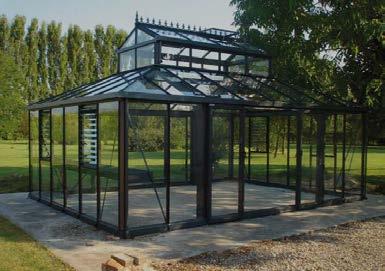
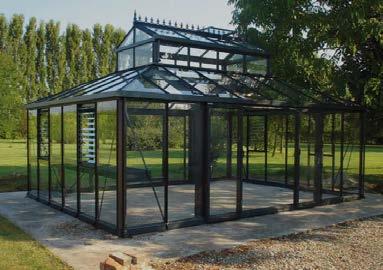

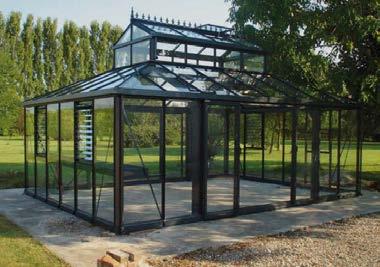







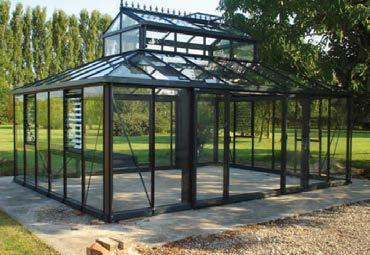



























































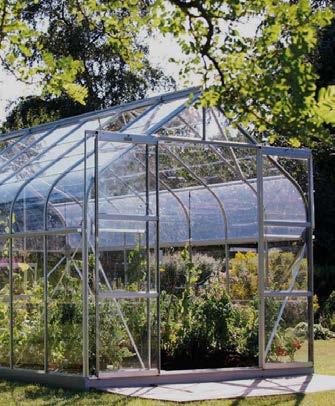



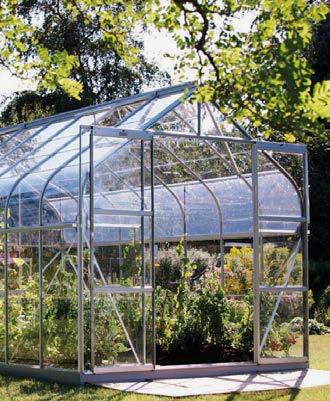


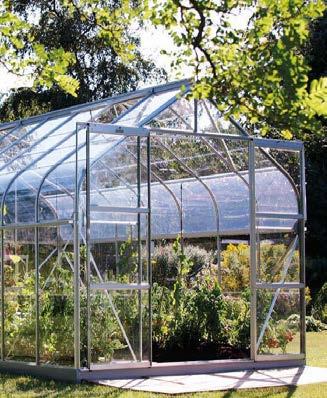































































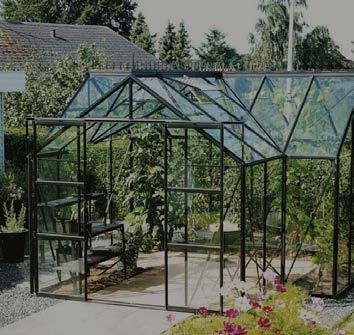


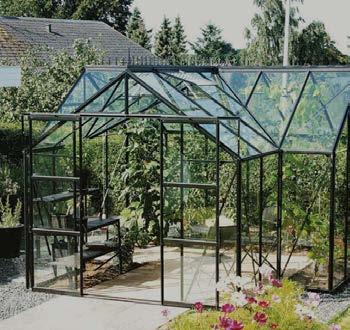
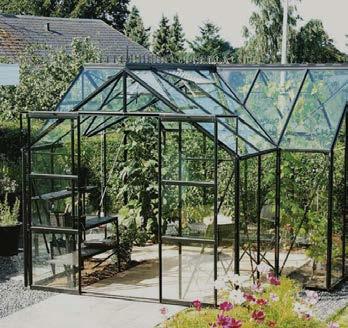
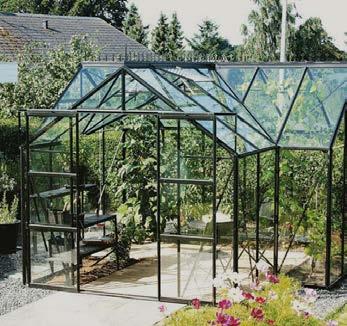



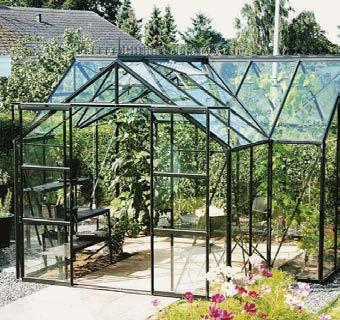

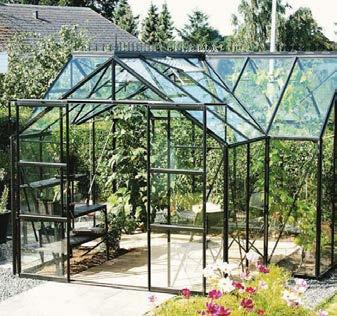
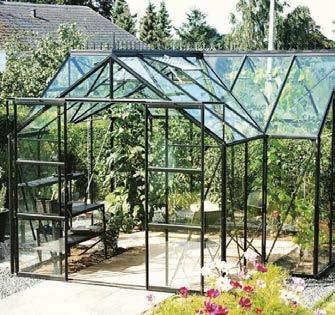

















































































GREENHOUSES GARDEN ROOMS ORANGERIES @VitaviaLtd 01473218100 info@vitavia.co.uk For moreinformationonVitaviaorJanssensGreenhouses, contactyournearestretailerorvisit vitavia.co.uk GREENHOUSES WALL GARDENS COLD FRAMES ACCESSORIES UK DISTRIBUTOR
Multiple Choice
Multi-stem trees are a strikingly beautiful addition to any garden, and designer Stefano Marinaz suggests ten candidates particularly well suited to the form
Sculptural and shapely, multi-stem trees owe their good looks to traditional coppicing techniques. When trees are a year or two old, the central stem is removed, encouraging it to shoot the following year. Multi-stems grow more slowly than those with a single trunk, but whether they’re evergreen, deciduous, large or small, they will have a bearing on the surrounding planting. “Bulbs, perennials, annuals,
climbers and shrubs will all be influenced by the type of tree you choose,” says garden designer Stefano Marinaz. “Think about the conditions you want to create, then select the tree you need.” Here he picks ten good multi-stem candidates for year-round interest.
Stefano Marinaz Landscape Architecture, 9 Fishers Lane, Chiswick, London W4 1RX. Tel: 020 3727 7264; stefanomarinaz.com

1 Ginkgo biloba


A neat growth habit and pretty leaves through summer and autumn makes this a good street tree, and it is widely planted in urban centres. But it also works well in gardens. “It is particularly interesting if grown as a multi-stem specimen,” says Stefano. “It’s drought tolerant and has beautiful colours in autumn.”

NOVEMBER 2022 THE ENGLISH GARDEN 65 TOP 10 PLANTS INTERVIEW VIVIENNE HAMBLY IMAGE SHUTTERSTOCK
2 Amelanchier lamarckii


This useful tree has many common names, including juneberry and snowy mespilus, both reflecting its attractive attributes. “It’s small, with delicate branches and a see-through aspect,” Stefano observes. “After a show of beautiful spring flowers, its summer berries feed the birds, then its foliage takes on lovely autumn hues.”
3 Cornus kousa ‘Milky Way’
White bracts borne in late spring and early summer are a highlight of a shrub that o ers year-round interest. “This is a great tree for areas of dappled shade, or for soil that really retains moisture,” says Stefano. By summer, the bracts have given way to strawberrylike fruits, while in autumn its leaves turn a fiery shade of red.
4 Pinus sylvestris ‘Watereri’

A chic addition to minimalist gardens, perhaps with a more contemporary mood. “This is a slow-growing, shrub-like evergreen tree that’s normally wider than it is tall,” Stefano notes. “Grow it in a sunny area of the garden, where it will tolerate dry, sandy soil – it also looks great paired with grasses.”

5 Gymnocladus dioica
“This valuable tree for bees is drought tolerant and has interesting paripinnate leaves that turn an attractive shade of yellow in autumn,” says Stefano. It has a loose, open-crowned form, and bears dense plumes of flowers followed by long seedpods of co eelike beans – hence the common name of Kentucky co ee tree.
66 THE ENGLISH GARDEN NOVEMBER 2022 TOP 10 PLANTS
6 Sorbus aucuparia
It’s hard to miss UK native Sorbus aucuparia in autumn when it is smothered in dense clusters of cheerful red berries. “It has a nice growth habit,” says Stefano, who also notes the value of its berries to garden wildlife. Its height can range from 5m to 15m and it is best suited to gardens with well-drained soil.

NOVEMBER 2022 THE ENGLISH GARDEN 67 IMAGES SHUTTERSTOCK; GARDEN WORLD IMAGES; GAP/JENNY LILLY
7 Magnolia stellata
A spring show of delicate starry white flowers is the hallmark of this popular magnolia species. Often naturally quite shrubby, it is a worthy candidate for the multi-stem treatment, which renders it very well-suited to a small space. “It’s particularly good for gardens with dappled shade,” Stefano advises.

8 Koelreuteria paniculata
“This tree is drought tolerant, has beautiful foliage and bears very interesting seedpods from the end of the summer throughout autumn,” says Stefano. Commonly known as pride of India, the tree also bears panicles of small yellow-bronze flowers. Grow it in full sun in moist but well-drained soil.

9 Nothofagus antarctica

Native to South America and growing as far south as Tierra del Fuego, the southern beech is a small deciduous tree well-suited to the multi-stem treatment. “It has a see-through canopy with small leaves and beautiful yellow colours in autumn. It’s hardy and suitable for most soils,” Stefano explains.
10 Rhus typhina
This tree bears crimson fruits in autumn and winter. “It tends to send out suckers from the ground, so it is best contained – either in a pot or using a root barrier membrane around the rootball to prevent the tree spreading everywhere,” says Stefano. “It’s particularly interesting for a naturalistic-looking garden.” n

68 THE ENGLISH GARDEN NOVEMBER 2022 TOP 10 PLANTS
IMAGES SHUTTERSTOCK; GAP/CLARE GAINEY/NICOLA BROWNE; GARDEN WORLD IMAGES




















NOVEMBER 2022 THE ENGLISH GARDEN 69 PLANT SUPPORTS & Garden Artefacts Beautiful designs for perennials, roses, shrubs & climbers Made in England www.leanderplantsupports.co.uk Tel. 01773 550495 Leander Quarter Page Advert V1 (English Garden).pdf 1 29/01/2018 09:25 Whatever the Size! Maintenance free structures designed to suit your space requirements and lifestyle Our attention to detail is evident no matter how large or small the project Perfect for your garden www.griffinglasshouses.com or call us on 01962 772512

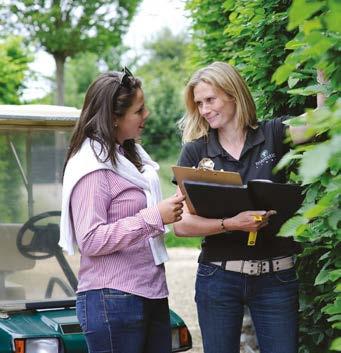
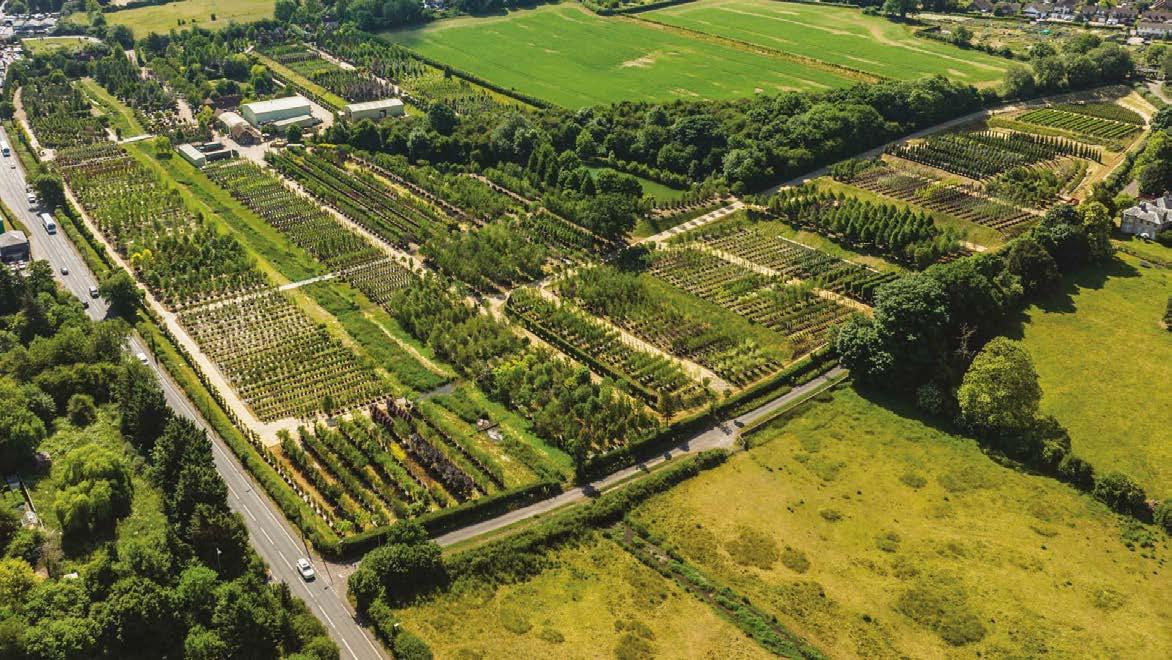





www.majestictrees.co.uk | 01582 843881 | info@majestictrees.co.uk Chequers Hill, Flamstead, Nr St.Albans, Herts, AL3 8ET • ADVICE • DELIVERY • PLANTING • AFTERCARE Come and explore our 27 acre nursery, where you can personally select your trees with the assistance of our experienced horticultural advisors. Over 450 varieties of semi-mature and mature trees and hedging, grown in 35 to 4,000 litre AirPot containers. " Great place to visit - trees galore, super advice, quality products and excellent sales & after-sales service. Junction 9 M1 is THE place for trees. " PHILIP SEWELL PLANTING MAJESTIC TREES NATIONWIDE FOR 20 YEARS! "A fantastic selection of fine specimen trees, very well organised and laid out on a sizeable site. The support and advice given, together with professional placement of trees into the pre-prepared tree pit, was extremely well received. Would strongly recommend this company." CHRIS RIMMINGTON Grower of the Year: Nursery Stock 2008 • 2011 2015 • 2017 Supplier of the Year 2020 Google reviews 4.9 out of 5
Trees for All
Winter
Pleached trees, like these limes, are brilliant for screening and lend sophisticated style to any garden design.




Once leaves have fallen and trees have entered their dormant season, it’s the ideal time to get a brand new tree in the ground. Provided the soil isn’t frozen or waterlogged, you can plant new trees any time from October to April and look forward to it getting o to the best start.



The only question is, which tree? There’s a huge choice, and it can be tricky to narrow it down. Unlike smaller herbaceous plants, trees take up much more room and you might have space for only one or two. It’s also harder to change your mind about a tree further down the line, so it pays to make the right choice. To help, we’ve rounded up a selection of fi ne trees for di erent purposes.

In association with
is the very best time of year to plant trees, and we have suggestions for small gardens, seasonal interest, different soil types and those seeking privacy TREES WORDS CLARE FOGGETT IMAGE GAP/JULIETTE WADE NOVEMBER 2022 THE ENGLISH GARDEN 71
Trees for small spaces






Rowans are a lovely choice in a small garden, with delicate feathery foliage that doesn’t cast too much shade. One of the nicest small ones is Sorbus vilmorinii, which has lovely ferny leaves and red berries in early autumn that fade to pink and then white as they age. Height: 5m.


Magnolia stellata is a favourite tree (although some might call it a bushy shrub) for those tight on space, reaching just 3m. Star-shaped, pure white flowers open in spring from large silky buds.
Another popular choice, Pyrus salicifolia ‘Pendula’ is a graceful weeping pear tree with white blossom in spring and elegant silver leaves. It reaches 5m and will grow virtually anywhere.
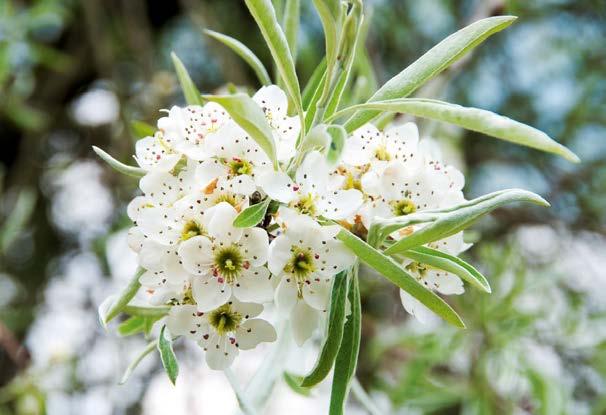

Something upright and slender could be the answer in really tight spaces. The 8m tall crab apple Malus x robusta ‘Red Sentinel’ grows up rather than out and boasts glossy red fruit in autumn.
Top left The pearlescent pink berries of Sorbus vilmorinii, which won’t cast too much shade in small spaces.
Top right Blowsy Prunus ‘Shirofugen’ blossom. Above right The crab apple, Malus ‘Evereste’ is a tree for all seasons, with spring blossom and autumn fruit.
Above left Silvery Pyrus salicifolia ‘Pendula’.
Trees for spring flowers

The words ‘spring blossom’ immediately bring cherry trees to mind. “Of the Japanese flowering cherries, I like Prunus ‘Shirofugen’ and Prunus x yedoensis. They are such good value,” says Graeme Jenkins of Practicality Brown. ‘Shirofugen’ reaches 8m and bears a profusion of double flowers. At 12m, P. x yedoensis is larger, and its palest pink, almondscented blossom is enchanting.



Most cherries o er good autumn colour, too, and when you’ve got room for only one tree, it makes sense to pick one for multiple seasons. Crab apples are another of Graeme’s favourites for the same reason, producing blossom in spring and fruits in autumn. Malus ‘Evereste’ is his choice, at 8m tall with white spring flowers and coral-flushed fruit.
If you want something really special, consider a Judas tree (Cercis siliquastrum), which produces purple-pink flowers in early spring. Height: 10m.
72 THE ENGLISH GARDEN NOVEMBER 2022 In association with TREES
Trees for summer interest







Known as the wedding cake tree because of its tiered branches, Cornus controversa ‘Variegata’ is a beautiful tree. Delicate green and cream leaves hang from the branches while its white summer flowers perch above. Height: 8m.

Somewhat larger at 10m tall, Koelreuteria paniculata has much going for it. The pinnate leaves emerge pink-red, turning green and then butteryellow in autumn. Delicate sprays of yellow flowers appear in summer giving it its common name of golden-rain tree. These are followed by pink-flushed fruit capsules that look like little lanterns.
But for summer flowers, little will beat Eucryphia nymansensis ‘Nymansay’. Evergreen, with glossy, dark green leaves, in late summer it produces large white flowers. Avoid it if you have alkaline soil though, as it won’t thrive. It can ultimately reach upwards of 12m, but it does grow slowly.

Top left The distinctive tiered branches of Cornus controversa ‘Variegata’.

Top right The beautiful and fragrant autumn foliage of Cercidiphyllum japonicum


Above right Vibrant Cercis canadensis ‘Forest Pansy’.

Above middle Berries on Sorbus ‘Joseph Rock’. Above left Eucryphia’s large white flower.

Trees for autumn colour
Berries and autumn leaf colour are the calling cards of the trees that liven up autumn, and rowans tick both boxes. On Sorbus ‘Joseph Rock’, berries the colour of clotted cream darken to yellow-orange among orange, red and purple leaves. Height: 10m. Sorbus ulleungensis ‘Olympic Flame’, meanwhile, has large leaves that produce fi recracker autumn tones alongside orange-red berries. Height: 8m.
The hawthorn, Crataegus persimilis ‘Prunifolia’, looks glorious in autumn when its leaves turn orange and it’s plastered with scarlet berries (4.5m). Another option is Cercis canadensis ‘Forest Pansy’. Heartshaped, burgundy leaves are su used with vivid orange, bronze and scarlet hues in autumn (8m). Not only does Cercidiphyllum japonicum have vibrant autumn colour – glowing ember orange and coral red – its falling leaves have a candyfloss scent that will stop you in your tracks. Height: 12m.
 JONES
JONES
NOVEMBER 2022 THE ENGLISH GARDEN 73In association with IMAGES SHUTTERSTOCK; CLIVE NICHOLS; GAP/HEATHER EDWARDS; GARDEN EXPOSURES/ANDREA
The Ultimate Overcoat





74 THE ENGLISH GARDEN NOVEMBER 2022 cocoon-online.com Catalogue and fabric swatches 01869 337770 COCOON
Luxuriously soft warm and elegant Genuine Austrian loden cloth of pure merino wool with a water resistant finish Made to measure in our Oxfordshire workshop Makers of fine coats since 1985 www.perilla.co.uk tel: 01886 853615 for the finest British Alpaca socks
Trees for winter
Evergreen trees are always a good choice for the winter months, and holly, with its connotations of the festive season, springs immediately to mind. Ilex aquifolium ‘Handsworth New Silver’ has silverygreen leaves with cream margins and scarlet berries.
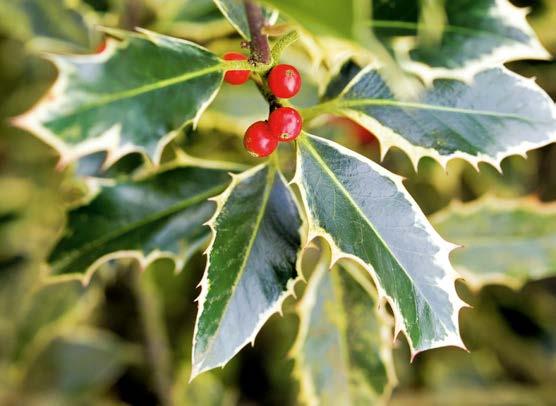
Most often, when we think of trees for winter, we’re drawn to those with interesting bark. Prunus serrula is a classic, with its polished mahogany trunk (up to 12m) and branches, and there are many acers with interesting colours and patterns. Acer griseum, with its flaky cinnamon-coloured bark, is one to consider (up to 12m), Acer palmatum ‘Sangokaku’ with its coral-red stems is another (6m). With their brilliant white trunks, birches never fail to draw attention during winter and Betula utilis var. jacquemontii ‘Grayswood Ghost’ (15m) is regarded by many as the whitest and most dazzling of all.

Top left The shining bark of Prunus serrula, a tree that also o ers lovely pink spring blossom.
Top right Pretty Styrax japonicus is a good choice for acidic soils.

Above right Arbutus unedo bears its fruit and flowers at the same time.

Above middle Springflowering Cornus mas is a suitable candidate for more alkaline soil.


Above left Elegantly variegated holly ‘Handsworth New Silver’.
Trees for acid or alkaline soil







Halesia carolina (8m) is known as the snowdrop tree for its dangling bell-shaped white flowers in late spring. Styrax japonicus (10m) is commonly known as the Japanese snowbell for the white flowers that hang from the underside of its branches. Both need neutral to acid soil and a spot sheltered from wind to thrive. Chionanthus, or fringe trees, are handy small trees for acid soil at around 3m tall. C. virginicus has fragrant white tassel-like flowers, followed by blue-black fruit. Other good choices are eucryphia, magnolias and the strawberry tree, Arbutus unedo
Accommodating cherries are tolerant of chalky, limey soil. Prunus ‘Cheal’s Weeping’ has pendulous branches with double bright pink flowers in spring, and at 3m tall it is perfect for small gardens. Other good choices for alkaline soil are reliable sorbus and crab apples, maples and Cornus mas

NOVEMBER 2022 THE ENGLISH GARDEN 75In association with
TREES IMAGES SHUTTERSTOCK; CLIVE NICHOLS; GARDEN EXPOSURES/ANDREA JONES
PLANTING AND CARING FOR TREES
Graeme Jenkins of Practicality Brown shares his planting tips
Graeme recommends mixing compost into the soil with which you backfill your tree’s planting hole, but don’t sit your tree on it. “If you’re not careful the tree will sink as soon as it gets wet, and then it can end up at the wrong level. It’s better to dig the hole to the depth of the rootball and let that sit firmly on the sub-base.”

Measure the rootball and use a cane across the top of the hole to check its depth as you dig. “You don’t want to be adjusting the height of the hole once you’ve put in the tree. Every time you move it you risk damaging the tree.”
Unless it’s a multi-stemmed tree or a sheltered site, stake your tree to prevent wind-rock, which a ects root development.
Many specialist tree nurseries, including Practicality Brown, o er a planting service – it’s definitely worth considering for larger and more expensive specimens.
New trees will likely need watering for their first two summers after planting. “It takes a while for a tree to fend for itself. Evergreens need water throughout dry periods, deciduous trees from March or April. To ensure ample water install an irrigation system – they’re more e cient and they can be used in a hosepipe ban.”
Above Choose a pleached evergreen tree for year-round privacy; this is Phillyrea angustifolia
Trees for privacy
Trees do a superb job of screening, and if they are evergreen they will shield your garden all year round. “Evergreens for screening are among our most popular trees,” Graeme explains. “They quickly do the job of solving privacy issues in a very cost-e ective way.” For the quickest fi x, invest in trees with a trunk height that clears your fence or boundary, so that the tree’s bushy canopy is precisely where you need it to be.
Suppliers
Architectural Plants
Tel: 01798 879213; architecturalplants.com
Hardy Eucalyptus
Tel: 07307 413052; hardy-eucalyptus.com
Majestic Trees
Tel: 01582 843881; majestictrees.co.uk
New Wood Trees
Tel: 01803 782666; newwoodtrees.co.uk

Practicality Brown
Tel: 01753 652022; pracbrown.co.uk

Ready Hedge
Tel: 01386 750585; readyhedgeltd.com
Pleaching is a great way of creating screening in smaller gardens. The e ect of a ‘hedge on stilts’ makes these trained tree forms invaluable for privacy. Young trees can be trained from scratch, but patience will be required to coax them into that distinctive, two-dimensional form at the right height. More often, ready-trained trees provide an instant solution.
Many specialist tree nurseries provide pleached specimens of tree species such as hornbeam and lime. At The Alnwick Garden in Northumberland, and in Arne Maynard’s garden at Allt-y-bela, there are beautiful squares of pleached crab apple; another interesting choice would be purple-leaved beech (Fagus sylvatica Atropurpurea Group). For yearround privacy, an evergreen is required. Imagine a screen of scarlet-flushed Photinia x fraseri ‘Red Robin’, glossy leaved Viburnum tinus ‘ Lucidum’, Japanese privet (Ligustrum japonicum) or the holly Ilex ‘Nellie R. Stevens’, all of which are o ered as pleached trees by Practicality Brown. n

76 THE ENGLISH GARDEN NOVEMBER 2022 In association with
TREES IMAGES GAP/CAROLE DRAKE
Practical Instant Hedge™ is pre-grown in 1m lengths, making handling and planting very easy, and using specially designed trough bags it can even be planted all year round. Since its launch Practical Instant Hedge™ has regularly been used in multiple award-winning gardens at the RHS Chelsea and Hampton Court flower shows.
Instant Hedges & Large trees Iver Bucks SL0 9LA 01753 652022
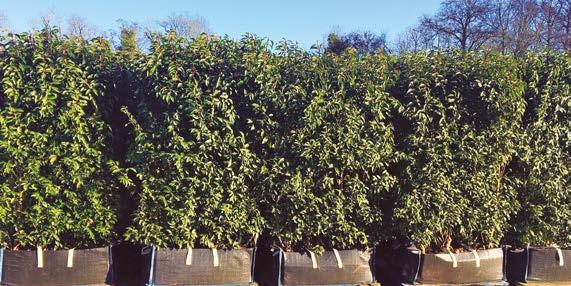
Practicality Brown have been supplying premium quality semi-mature large trees and instant hedges since 1989. Using our years of experience in developing, maintaining and planting instant hedging, we now grow our own Practical Instant Hedge™ range, as well as trees, at our nursery in Buckinghamshire.
We also specialise in providing large semi-mature and specimen trees, offering a complete delivery and planting service, bringing instant impact to any garden or landscape. We select the best quality evergreen and deciduous trees each season from over 400,000 trees in over 240 varieties, so you have the best possible trees available.


 Semi Mature Trees
Delivered from our Nursery
Practical Instant Hedge™
Semi Mature Trees
Delivered from our Nursery
Practical Instant Hedge™
PRACTICALITY BROWN LTD THE INSTANT HEDGE SPECIALISTS Swan Road
| Tel:
| hedge@pracbrown.co.uk
Find more information at: www.pracbrown.co.uk
ONE YEAR GOOD GARDENING DIPLOMA
BOOK NOW FOR SEPTEMBER 2015
September 2022 – beginning July 2023
DIPLOMA COURSES
One Year Good Gardening Diploma – A Planting Design Course
September 2015 – June 2016
Covers the best in planting design while training in the more serious aspects of horticultural techniques (1 day a week (Tues), 10am–3.15pm, over three 10 week terms).

Covers the best in planting design while training in the more serious aspects of horticultural techniques. Practical sessions held at Arundel Castle under the guidance of head gardener Martin Duncan and at Sandhill Farm House, Rogate. Lectures by many leading gardening personalities and regular visits to exclusive private gardens. Students also learn to draw up planting plans. (1 day a week (Tues), 10.30am–3.15pm, over three terms)
THE ESSENTIAL GARDEN DESIGN DIPLOMA

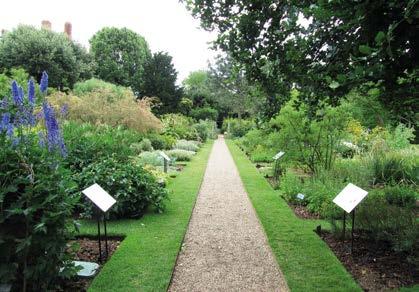

January – March 2023
10 WEEK INTENSIVE GARDEN DESIGN DIPLOMA
January – March 2016
Covers all you need to know in this diverse subject, including TWO real design projects and CAD tuition. (3 days a week in school, 10am-3.15pm, plus 2 days homework)
GARDEN MAKERS DAY
Based at the Chelsea Physic Garden and led by Rosemary Alexander and architect Catriona Rowbotham, the course is an overview of Garden Design, covering all the elements needed to rethink an average garden. Taking students step by step through site surveying, using the grid, horizontal and vertical features, garden layouts and planting plans, costing and specification, plus drawing tuition and homework on design and plant portfolios. Tutors are well respected in the industry and will guide students on how to succeed in this diverse profession. (2 days a week (Wed & Thur) 10.30am-3.15pm, plus 2 days homework)
October 2015
GARDENING FOR BEGINNERS
Wednesday & Thursday 19, 20, 26, 27 April 2023
Distance Learning Courses - study anytime, anywhere in the world. 1-3 years to complete.
GARDEN DESIGN & CARING FOR YOUR GARDEN
A step by step guide to designing your own garden: drawing up plans, hard landscaping, site analysis, planting etc. Taught through a comprehensive course book, with projects submitted by post.

One of our most popular courses, led by master horticulturalist Ben Pope, which aims to take each student through all the practical elements of caring for a garden from soil, tools, maintenance, seed sowing and propagating, weed control and pests and diseases. The first 3 days will be spent with lectures at the Chelsea Physic Garden and the final day will be spent gaining practical experience in Rosemary Alexander’s much praised garden near Petersfield and another private garden nearby, where Ben is in charge. Participants will be given a chance to prune, plant, sow seeds and regular maintenance tasks will be discussed. A light lunch and refreshments will be provided daily.
GARDEN DESIGN & CARING FOR YOUR GARDEN
Distance Learning Courses study anytime, anywhere in the world
A stepping stone to a new career. These two correspondence courses are a step by step guide to either designing your own garden or learning how to plant and maintain an existing garden: drawing up plans, hard landscaping, site analysis, planting, month by month tasks etc. Taught through a comprehensive course book, with projects submitted to us. 1-3 years to complete and individual assessment.
Garden of Medicinal Plants – Chelsea Physic Garden Photo: R Alexander
Long established as the leader in all matters horticultural and based at the historic Chelsea Physic Garden
© Marianne Majerus
78 THE ENGLISH GARDEN NOVEMBER 2022 ll ll n ll n
Not sure which Diploma course is for you? We prefer potential students to attend an Information Session when Rosemary explains the whole course content and you can see our facilities at the historic Chelsea Physic Garden. JUST CONTACT US TO SET UP A DATE/TIME www.englishgardeningschool.co.uk Email: info@englishgardeningschool.co.uk Tel: 01730 818373 Long established as the leader in all design and gardening tuition and based at the unique and historic Chelsea Physic Garden
For full details, dates, prices visit our website www.englishgardeningschool.co.uk Email: info@englishgardeningschool.co.uk Tel: 020 7352 4347 Garden of Rosemary Alexander, Principal EGS Sandhill Farmhouse, Hampshire Not sure which course is for you? Come along to an Information Session to find out more.
Gardening School_B634393_2mg.indd 1 02/07/2015 BOOKING NOWGarden Makers Day 2 November with Ambra Edwards, Jo Thompson and Xa Tollemache
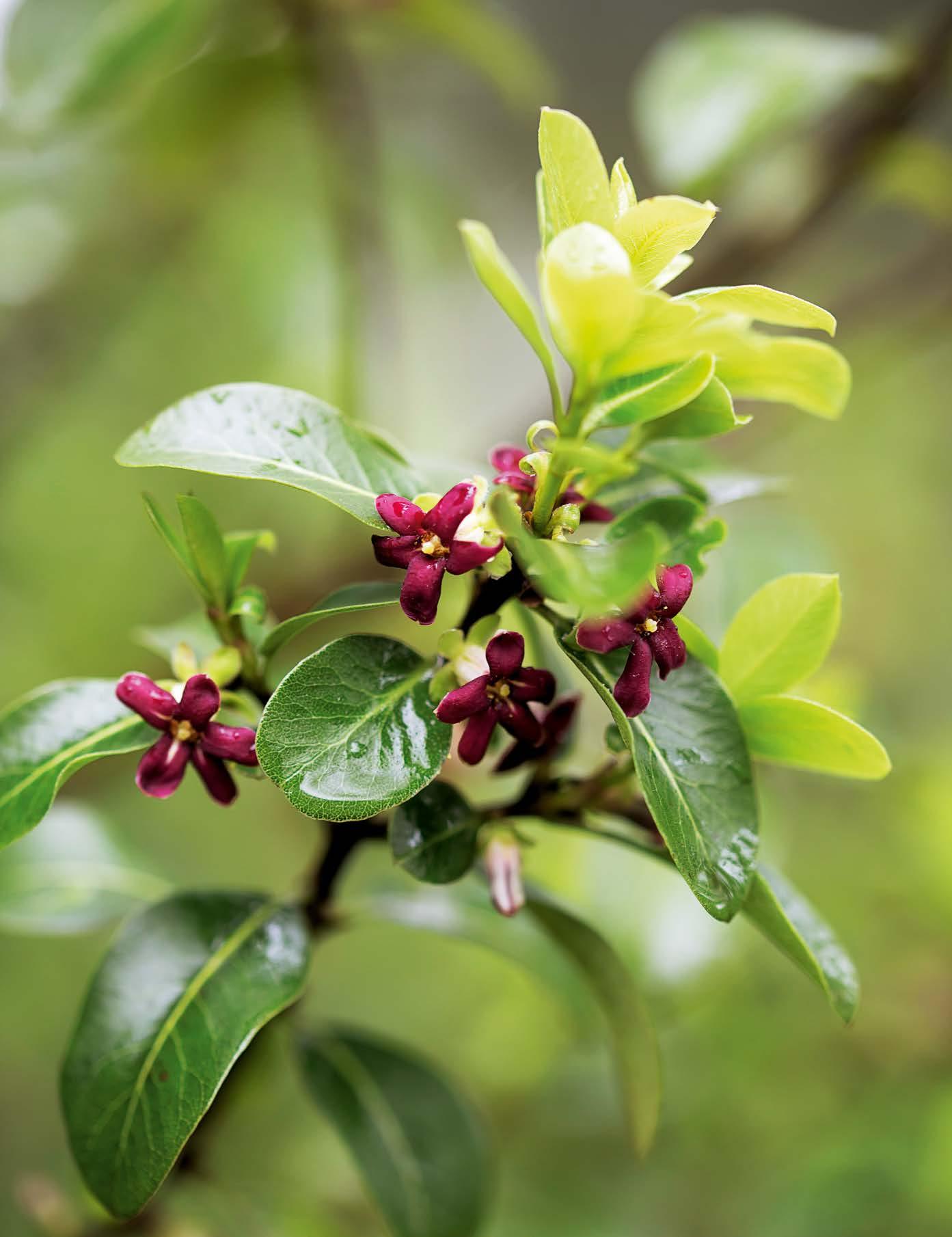 Evergreen Pittosporum tenuifolium ‘Tiki’ has glossy leaves and small but fragrant flowers of the richest purple.
Evergreen Pittosporum tenuifolium ‘Tiki’ has glossy leaves and small but fragrant flowers of the richest purple.
Get the Gloss Robust, vigorous and diverse, hard-working evergreen pittosporum is the go-to statement shrub for practically any situation thanks to its gorgeously glossy foliage and low-maintenance habit PHOTOGRAPHS DIANNA JAZWINSKI NOVEMBER 2022 THE ENGLISH GARDEN 79 PLANT FOCUS WORDS VIVIENNE HAMBLY
You like po-tay-to and I like po-tah-to, you like pitt-oh-sporum and I like pitt-oss-porum… There is certainly more than one way to pronounce the name of this well-known genus, with apologies to Ira and George Gershwin. One thing is certain: pittosporum is so diverse, there is a plant for almost every garden need. From robust hedging to all-green box alternatives and even eye-catching container specimens, this broadly hardy evergreen shrub is justifiably popular.
Primarily native to New Zealand, where the widespread species P. tenuifolium is known as kohuhu, pittosporum is believed to have developed on the ancient supercontinent of Gondwana. Its natural distribution, therefore, stretches up the eastern hemisphere towards Japan, reflecting the single landmass that existed several hundred million
Above New spring shoots on Pittosporum tenuifolium ‘Variegatum’, whose slow growth and drought tolerance makes it ideal for containers.
years ago. While there are around 210 species in the genus, only a handful or two of these are cultivated for ornamental use. The leaves, so attractive to gardeners, are simple and arranged in spirals. Their small, fragrant flowers are five-merous, that is, they have five petals and five stamens, and mature plants can range from a height of just 75cm to several metres tall.

How to use it in the garden
While flowers come and go, foliage forms the backbone of good gardens, especially in autumn and winter, and here pittosporum comes into its own. There is a great range of leaf forms and colours, straight-edged or undulating, bright or muted, dark purple, lilac, creamy white or olive green, so there is likely to be a variety to suit.

The most commonly hybridised species in this country is P. tenuifolium, which rivals yew and box as a hedging candidate. With dark stems and small, fairly slender, glossy, wavy leaves, this species bears small, dark brown, honeyscented flowers in early summer. Since it is unlikely to withstand a hard frost, it’s best grown in southern gardens, or kept in a sheltered spot away from a north or east wind. It can become unruly, but it responds well to light clipping. To accommodate this character, grow young hedging plants about 1m apart: they will soon fi ll the gaps.
Although very few plants have quite the same versatility as box, Pittosporaceae, the family to which pittosporum belongs, is thought to be distantly related to Buxaceae, of which box is a part. The variety P. tenuifolium ‘Golf Ball’ is naturally clump-forming and is now widely used as a box alternative: it develops small leaves and responds well to regular pruning. Although it presents a slightly rougher look to a traditional box ball, this is often more than compensated for in ease of care. ‘Golden Ball’ also has a suitable growth habit and ‘Tom Thumb’ is similar but bears particularly striking deep purple leaves, which contrast with bright green young growth in spring. It’s a scenestealer in its own right and should be grown in a sheltered spot in full sun or partial shade.
It is surprising how often a quick replacement for a plant is needed in gardens. Grown as a specimen shrub, pittosporum will easily fi ll a gap or screen an eyesore, such as a neighbour’s shed, but they also blend in seamlessly with surrounding
80 THE ENGLISH GARDEN NOVEMBER 2022
PLANT FOCUS
Above left Contrasting apple-green new shoots against old purple foliage on P. ‘Tom Thumb’.
Above right The leaves of ‘Golden Ball’ have a chartreuse tinge.
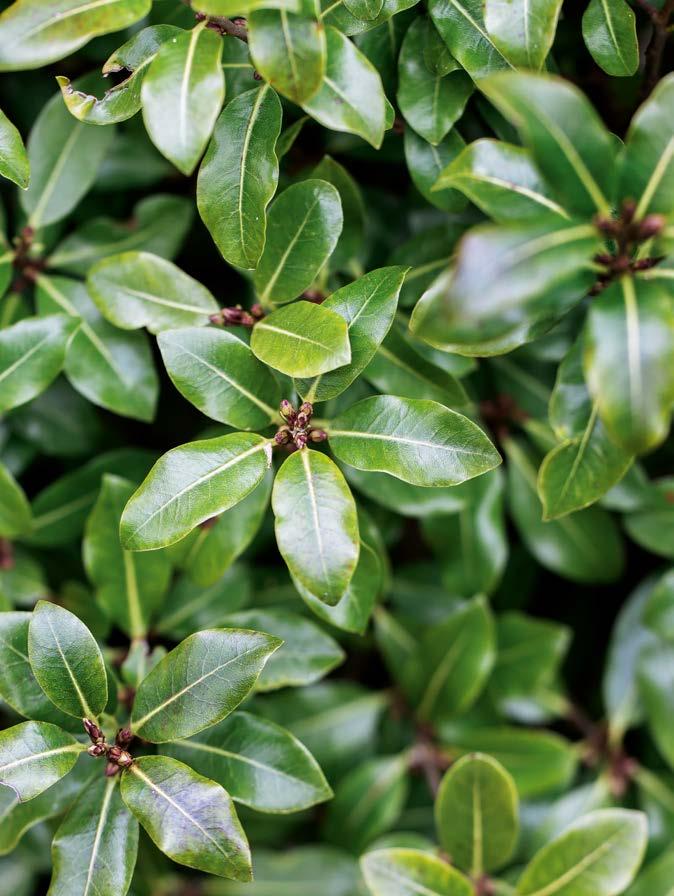
Below right Speckled variegation on the leaves of ‘Irene Paterson’.
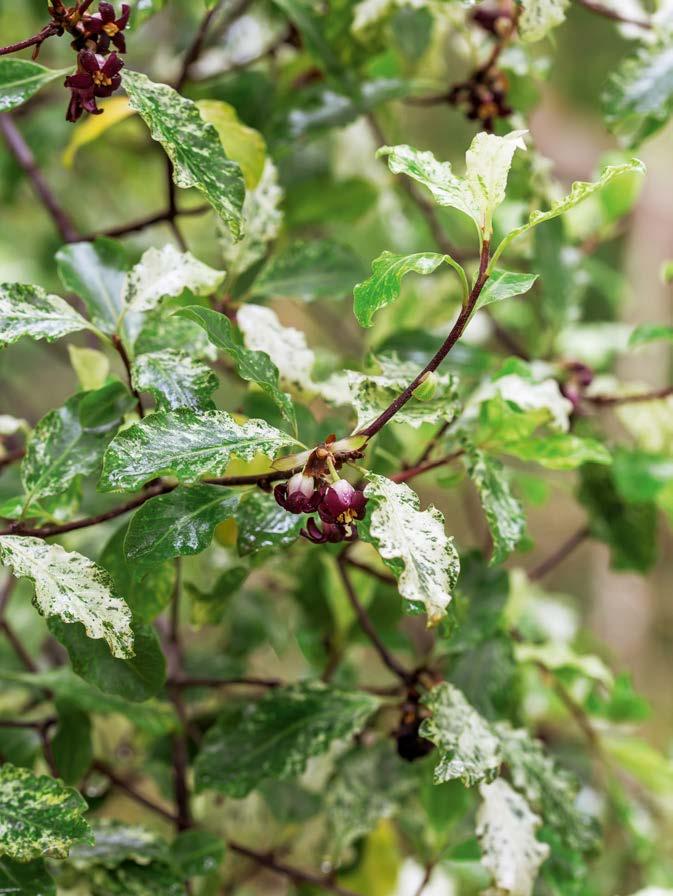
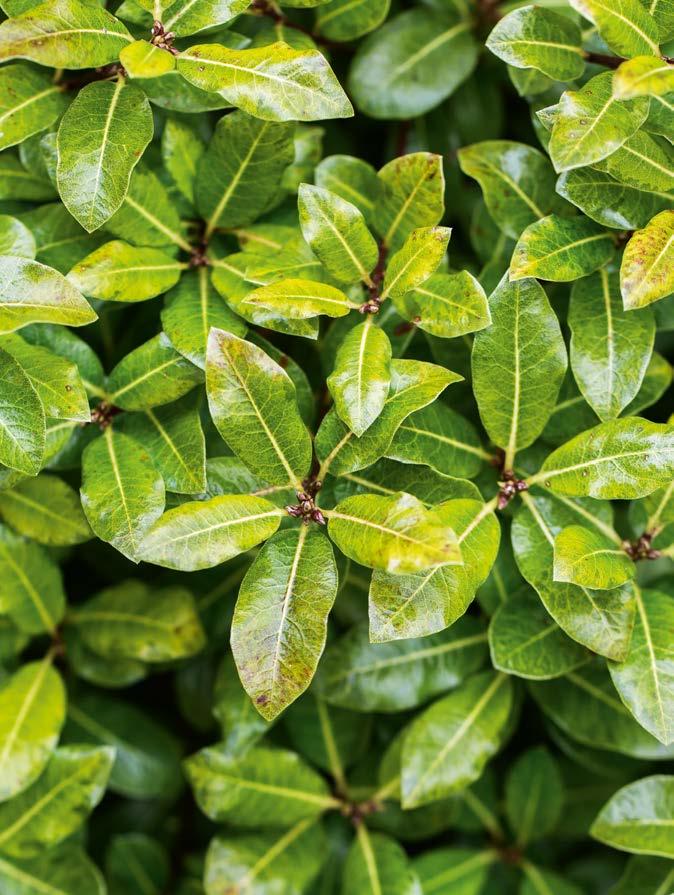
Below left ‘Golf Ball’ has a rounded habit and is amenable to clipping, making it a good box alternative.

planting. A specimen can make an excellent foil for other, scene-stealing plants you might want to show o , or provide a backdrop for low-growing planting, including spring bulbs. Highly decorative P. ‘Elizabeth’ o ers attractive, wavy leaves with a bright pink speckled edge. A more sedate candidate is P. tobira AGM, a slightly hardier, slow-growing species from Japan. It bears glossy dark green leaves and, in early summer, orange-scented creamy-white flowers similar to those of choisya, which explains its common name of Japanese mock orange.
As a contrast against darker shrubs, or to enliven mixed shade, try P. ‘Garnettii’ AGM, whose olivegreen leaves have a defi ned cream trim. Left alone it forms a lovely relaxed shrub, but it can also be clipped into formal shapes, including substantial pyramids. ‘Irene Paterson’ AGM, with distinctive bright white blotches on its leaves, is justifiably popular in darker corners. It’s a comfortable companion to Sarcococca hookeriana, or subtly variegated Euonymus fortunei ‘Emerald Gaiety’. P. ‘Bicton Silver’ has dark stems and narrow leaves with a silver margin. Bear in mind that variegation is most pronounced in bright sun, so complete shade will produce a less impressive result.

In containers, use pittosporum as the constant against an ever-changing seasonal cast. In winter, set it against pots of hellebores
Above left ‘Elizabeth’ has wavy leaves with a pink speckled edge for an unusual splash of colour. Above right ‘Abbotsbury Gold’ has handsome glossy foliage, and could even be used to create a tropical look.
beside the front door for a welcoming display. In spring, pair a variegated variety with the likes of Narcissus ‘Silver Chimes’ for a breezy look. Several candidates will provide an easy-care solution to containers. P. tobira ‘Variegatum’ is slow-growing, reaches only around a metre tall and is fairly drought resistant. Lightly variegated P. ‘Peter Pan’ is both drought tolerant and clump forming, while purple ‘Tom Thumb’ would look marvellous set against the vibrant oranges and pinks of tulips such as ‘Cairo’ and ‘Queen Jewel’. Try P. tenuifolium ‘Abbotsbury Gold’ for pale yellow-tinged leaves that are trimmed with a darker green.
How to grow it
Good Resources
Shrubs: Discover the Perfect Plant for Every Place in the Garden by Andy McIndoe (Timber Press, £25)
Burncoose Nurseries Sells pittosporum species grown in Cornwall. Tel: 01209 860316; burncoose.co.uk


County Park Nursery Surrey nursery open by appointment. countyparknursery.co.uk
Most pittosporum are hardy only to a point, doing best in southern gardens or sheltered spaces. They’re particularly vulnerable when young before their woody stem has developed so protect them. P. tenuifolium, the most widely grown species, enjoys slightly acidic soil which should be fertile and well drained.
If they’re not grown as topiary, pittosporum need only light pruning in late summer to keep them in shape. Variegated plants can quickly become dominated by vigorous nonvariegated shoots. In spring, after the frosts, look out for these and cut them at the base of the plant. Spring is also a good time to prune a pittosporum hedge. n
82 THE ENGLISH GARDEN NOVEMBER 2022
PLANT FOCUS

















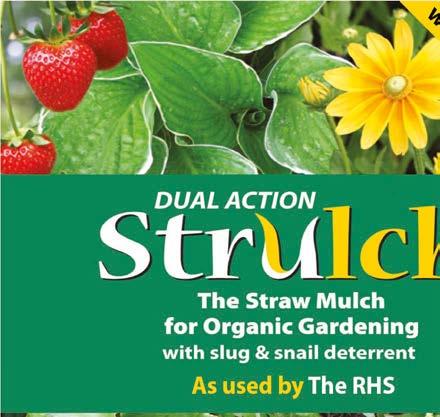













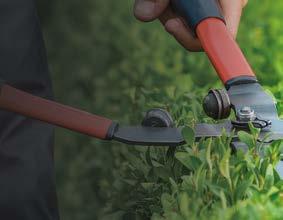









NOVEMBER 2022 THE ENGLISH GARDEN 83 Gardening trousers with integrated kneepads © The Royal Horticultural Society. Endorsed by the Royal Horticultural Society. Registered Charity No 222879/SC038262. rhs.org.uk No more wet knees Available in bulk and in 9kg bags from our stockists Order Online Now! HEDGEPLANTS.COM Hedge Plants.com Garden hedging made easy. Ready to Plant Hedging HEDGEPLANTS ADS 202x129.indd 4 12/05/2022 11:57:27


www.torcpots.com
Plants for NOVEMBER


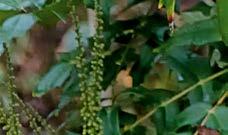
N ovember, of all the months, is often hardest to plan and plant for. It’s not yet fully winter, and that brief, glorious, goldenhued sweet spot when fiery autumn leaves reach peak conflagration may or may not have passed. Precious time in the garden is reduced as thoughts of the shortest day and approaching festivities loom in the mind. But as any gardener worth their salt knows, there are always plants to depend on, and in November the choice is thankfully far wider than the limited displays in garden centres would have you believe.
 Mahonia x media ‘Lionel Fortescue’ blooms from November, o ering a lemon-yellow crown of upright flower racemes.
In the first of a four-part series exploring the most covetable plants of the winter season, Philip Clayton looks at shrubs for berries, flowers and foliage
Mahonia x media ‘Lionel Fortescue’ blooms from November, o ering a lemon-yellow crown of upright flower racemes.
In the first of a four-part series exploring the most covetable plants of the winter season, Philip Clayton looks at shrubs for berries, flowers and foliage
A CUT ABOVE IMAGE GAP/MARTIN HUGHES-JONES NOVEMBER 2022 THE ENGLISH GARDEN 85
Try something fruity
Ornamental fruit is often much longer lived than bright foliage colour. The usual berried suspects are trotted out with tedious regularity at the garden centre, various (but viciously thorny) pyracantha almost always o ered. These have their merits as burglar-proof hedges or trained carefully along the wall of a house, but usually they are pretty boring; it’s hard to imagine anyone getting worked up about them. By contrast, the glories of the many euonymus that are grown for their fruit can be jaw-dropping.
I’m a big fan of Euonymus planipes, which makes an upright tree-like shrub to about 3m. It actually hits the mark twice in autumn: first with its dazzling plummy-scarlet foliage, and then with cascades of red-pink fruit that open to reveal contrasting orange seeds, the display starting with the leaves, but lasting well after they have fallen. Then there is striking E. hamiltonianus ‘Koi Boy’, of similar size, its fruits clean white with orange seeds and glowing yelloworange autumn leaf colour. More unusual still is


Top from left Glowing amber fruits of V. opulus ‘Xanthocarpum’; Euonymus planipes has scarlet foliage and orange seeds. Above from left Whiteberried Euonymus hamiltonianus ‘Koi Boy’; metallic-blue fruits of Symplocos paniculata; Callicarpa bodinieri var. giraldii ‘Snow Queen’ is a striking pure-white beautyberry.
E. cornutus var. quinquecornutus with dangling, pink-tinged, spidery fruits, each with five or six hornlike structures and, again, bright orange seeds – this is best trained on a wall to show o the display.

Yawn-inducing Viburnum opulus so often appears at the garden centre, potentially a large treelike shrub to around 4-5m tall and across, bearing clusters of reddish fruit. There are some much more exciting viburnums, however, which are well worth seeking out. V. opulus ‘Xanthocarpum’ bears masses of beautiful, glowing, amber-coloured fruits that are really unusual. For me, the best berried viburnum of all is V. betulifolium, a tall shrub to 4m. At its best it positively drips with bunches of small sealing-wax red fruits that last well into winter. To fruit properly it needs to be planted in a group with others of its kind – worth the space if you have it. It’s the same story with one of the most arresting of all autumn fruiters, Symplocos paniculata, a deciduous shrub of 2-3m that bears astonishing bright metallicblue berries, quite unlike anything else. Again, you’ll

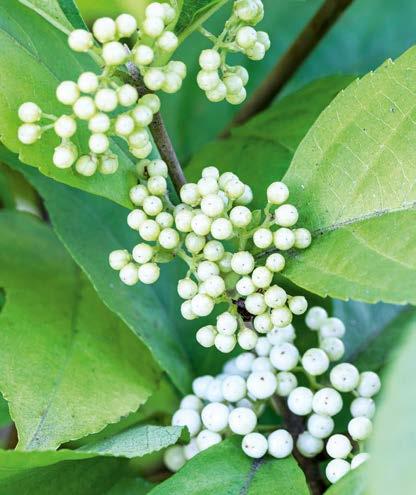
86 THE ENGLISH GARDEN NOVEMBER 2022
A CUT ABOVE
need a couple of plants for cross-pollination and a sunny, warm place to ensure good performance.
Purple-berried Callicarpa bodinieri var. giraldii ‘Profusion’ is a great plant when grown well, and has recently been joined by more select choices, among them C. bodinieri var. giraldii ‘Snow Queen’, whose pure white fruits make a superb contrast when grown with purple ‘Profusion’. Last year I happened upon C. kwangtungensis at my local garden centre, a plant not even listed in the latest The Hillier Manual of Trees & Shrubs. It is a Chinese species to around 1.5m with clusters of violet berries held on gracefully arching dark stems – far more elegant than the usual twiggy upright form of C. bodinieri.
Bring on the flowers and foliage
Your November garden need not be bereft of flowers, but familiarity, it is said, breeds contempt. Ubiquitous Mahonia x media ‘Charity’ is a first class, if prickly, architectural evergreen, flowering brilliantly before the turn of the year, but there are more interesting choices. M. x media ‘Lionel Fortescue’, growing to around 2.5m, is simply charming in November, its long upright racemes of bright yellow flowers being the first to open dependably in this month. More impressive is M. oiwakensis subsp. lomariifolia, an upright shrub forming, in time, a small tree to around 5m tall. Its long leaves are composed of smaller, more numerous leaflets than M. x media and it bears great clusters of golden candle-like flower spikes at the tips of its shoots. It needs some shelter and warmth to do well, but it is a spectacular sight in full bloom.

Another shrub damned by its ubiquity is Aucuba japonica ‘Crotonifolia’ (spotted laurel). It’s a tough evergreen that’s able to grow in dry, root-filled soil in full shade, but deathlydull, poor thing – indeed you’ll almost certainly find it thriving at your local cemetery. Slightly less bomb-proof perhaps, but way more interesting, is glittering A. japonica ‘February Star’, a knockout plant reaching 2m tall and wide, with slender foliage boldly spangled with gold freckles, forming a neat, easy-going shrub. A. japonica ‘Picturata’ is a favourite of mine, its broad leathery leaves spotted but also featuring a bold central golden blaze: do watch out for reversion however. There’s no need to keep an eye on more compact A. japonica ‘Rozannie’, for its foliage is rich glossy green all over. It’s grown for its generous crops of red berries that make a beautiful foil for the leaves, looking good until Christmas. n
Philip Clayton’s new book, A Plant for Every Day of the Year, is published on 6 October by DK (£20).
Top Glossy red berries of Aucuba japonica ‘Rozannie’.

Above right Mahonia oiwakensis subsp. lomariifolia can grow to 5m tall.
Above left Unusual dangling fruits of Euonymus cornutus var. quinquecornutus
Left Tough, evergreen Aucuba japonica
‘Picturata’ has striking leaves with a central golden blaze.


Ubiquitous Mahonia x media ‘Charity’ is a first class, if prickly, evergreen, but there are more interesting choices
NOVEMBER 2022 THE ENGLISH GARDEN 87
IMAGES GAP/JOHN GLOVER/RICHARD BLOOM/NOVA PHOTO GRAPHIK; CLIVE NICHOLS; GARDEN EXPOSURES/ANDREA JONES; GARDEN WORLD IMAGES












88 THE ENGLISH GARDEN NOVEMBER 2022 We Make The Seats, You Make The Memories NEW RHS Four Seasons Bench ® The Royal Horticultural Society. The Royal Horticultural Society, and its logo, are trade marks of The Royal Horticultural Society (Registered Charity No 222879/SC038262) and used under licence from RHS Enterprises Limited. The only bespoke swing and bench maker endorsed by the RHS sittingspiritually.co.uk 01297 443084 The only bespoke swing and bench maker endorsed by the RHS sittingspiritually.co.uk 01297 443084 Spring Autumn Summer Winter SI0191 The English Home October 2022.indd 1 18/08/2022 11:18 01270 753826 info@whitecottage.co.ukwww.whitecottage.co.uk Designed to optimise your growing space and built to last a generation. Our combination of painted Accoya, the timber industry leader in sustainability and performance, with a maintenance-free aluminium roof, gives peace of mind on all fronts. Minimise your impact on the environment Approved manufacturer
Late to the Party
At







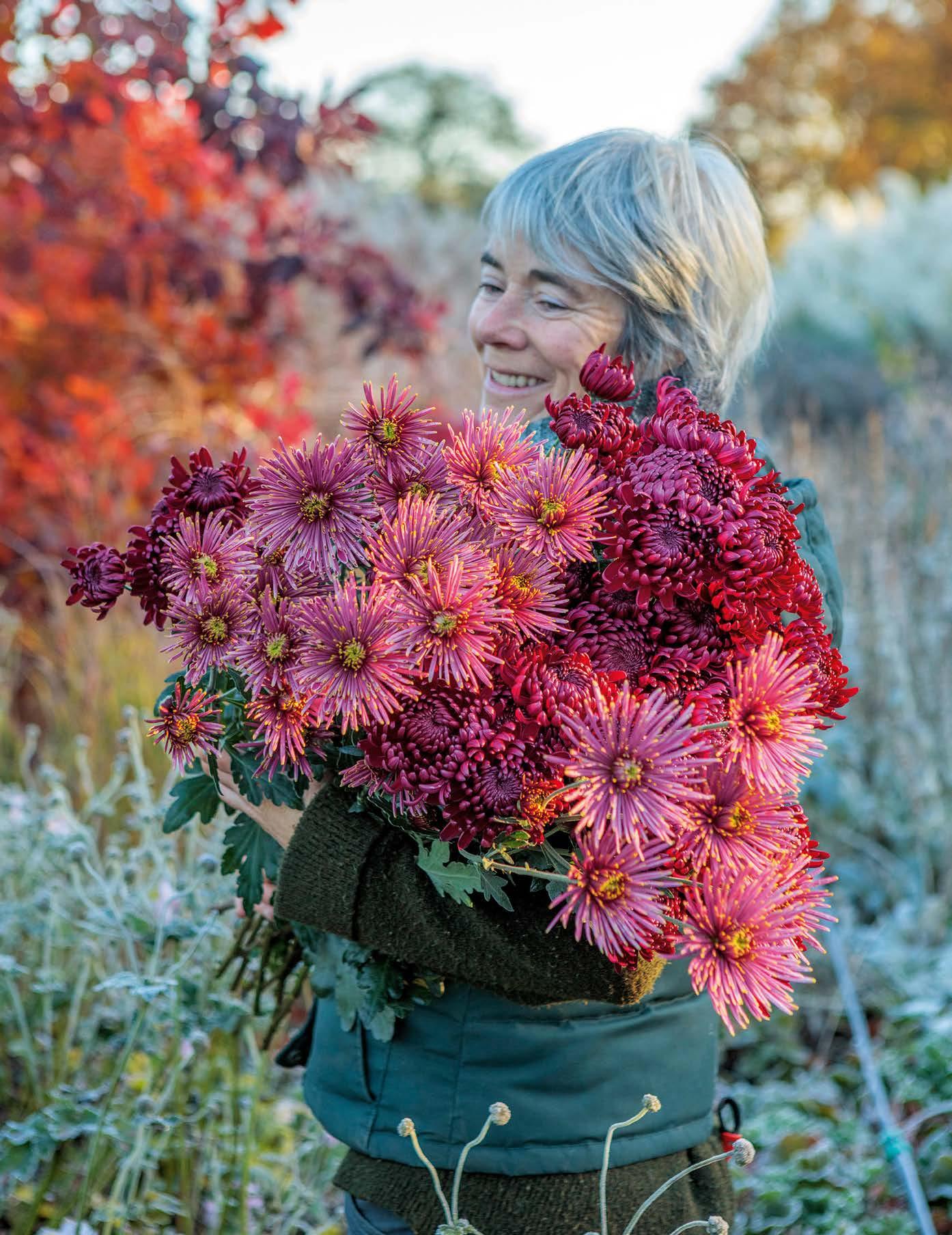 Rachel Siegfried, with an armful of freshly picked chrysanthemum blooms on a frosty morning at Green & Gorgeous.
WORDS JACKY HOBBS PHOTOGRAPHS NICHOLS
Rachel Siegfried, with an armful of freshly picked chrysanthemum blooms on a frosty morning at Green & Gorgeous.
WORDS JACKY HOBBS PHOTOGRAPHS NICHOLS
Green & Gorgeous in Oxfordshire, owner Rachel Siegfried lets us in on the secrets to successfully growing flamboyantly opulent cut chrysanthemums – a fitting finale to a colourful season of growing
CLIVE
NOVEMBER 2022 THE ENGLISH GARDEN 89 CHRYSANTHEMUMS
Chrysanthemums are enjoying a comeback. Hanging o the dahlia’s dazzling coat tails, they provide a cavalcade of colour right into autumn. But chrysanthemums have long been undervalued and misunderstood as garden plants and cut flowers. For years they were seen as either lurid bedding plants or time-consuming, glasshouse-grown exhibition blooms. And as cut flowers they were funeral stalwarts, or the ghastly plastic-wrapped bunches sold on garage forecourts.
“When I started Green and Gorgeous in 2008, I looked to chrysanthemums as late-blooming focal flowers, to extend the season and keep weddings going into November,” says owner Rachel Siegfried. Grow them she did, but sell them she did not. “There was simply no market for them whatsoever, so I abandoned them for several years,” she explains.
That was until November 2016, when Rachel visited Japan and was astounded by the fantastic seasonal festivals and exhibitions held across the country to celebrate chrysanthemums – the autumn
Above Rachel’s crops are grown in large polytunnels to protect them from the worst excesses of the lateseason weather.
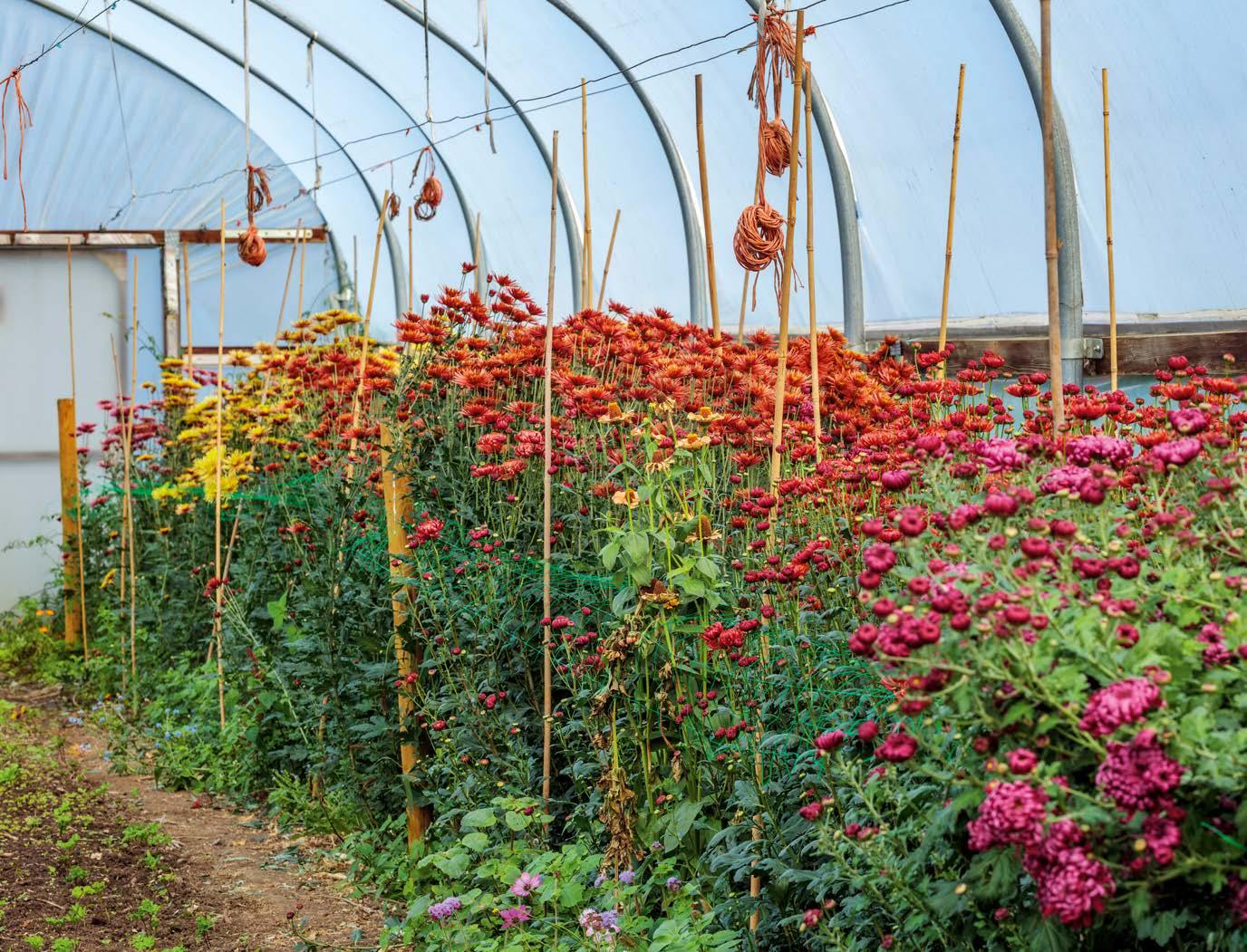
Right Long, stately stems of Chrysanthemum ‘Spider Bronze’.

90 THE ENGLISH GARDEN NOVEMBER 2022
equivalent of cherry blossom. “In Japan they are revered, incredibly diverse with fascinating new selections all growing in a climate similar to our own,” she says. On her return, Rachel revisited specialist catalogues and found not only a wider range of attractive newly bred cultivars, but also a number of environmentally conscious, discerning customers, keen to buy local and in season.
“The o ering is still narrow, with far fewer possibilities than the thousands of desirable dahlias,” says Rachel. Initially she was thrown by the catalogues’ rigid single-stem imagery aimed at traditional ‘exhibition’ growers. “With knowledge and experience, though, I learned to see past the single ball-on-a-stick flowers and imagined how I might grow looser, branching flowers. I honed in on the more intricate ‘William Morris-style’ blooms, the Intermediate or Decorative chrysanthemums and
Top from left Yellow-pink C. ‘Tula Improved’; rich, rust-coloured ‘Spider Bronze’; the glossy petals of ‘Bigoudi Red’ have incredible sheen. Above Arranged by hue, a vibrant array of cut chrysanthemums ready to be sold fresh from Rachel’s farm gate.


the urchin-like Spider types. A selection of early-, mid- and late-season cultivars ensures a succession of blooms through to the end of November.”

Rachel grows her chrysanthemums under cover, but not because they all need to be grown indoors. “Some do, but as a commercial flower grower I need to protect my crop,” she explains. “Chrysanthemums are tall – 1.5m plus – and even with support they need to be sheltered from wind and rain, since wet outer petals quickly turn mushy. The later-flowering Intermediates or more delicate Spider types need to be grown in a frost-free environment.”
Many of the early varieties do make good garden plants. “I grow half hardy, early, double, outdoor sprays and some early Intermediates outside,” says Rachel. “Last year they even survived the first couple of frosts.” Her prime outdoor space, however, is usually full of dahlias each autumn, so she resourcefully maximises otherwise unused space indoors, lifting the chrysanthemum plants at the end of November to make way for spring bulbs.
“If space isn’t at a premium, chrysanthemums can be left in for three years and then replaced as they become congested, rust-prone and lose their vigour,” Rachel notes. “Climate change might improve success with growing more chrysanthemums in the garden, but it is imperative that they have formidable support in a sunny, well-drained and really sheltered site,” she advises. “Any garden plant grown for cut flowers needs more feed, more water, more love.”
Rachel has narrowed down her chrysanthemum selection to a rich and opulent palette of around 20 di erent cultivars, among them double outdoor sprays, Intermediates and Spiders, which light up autumnal arrangements. “My selection is the best of the best, trialled over several years and picked for indoor-grown, cut-flower perfection, but they can, in the right conditions, be garden grown, especially the

NOVEMBER 2022 THE ENGLISH GARDEN 91


































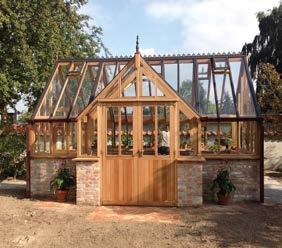


92 THE ENGLISH GARDEN NOVEMBER 2022 At Appletree Bespoke Timber Buildings Limited we offer high quality, bespoke timber buildings and specialise in Shepherd Huts. Our family run business focuses on giving customers a friendly, personalized service resulting in high quality, custom-made buildings which will stand the test of time. Finance is available on all our products, ranging from Workshops, Sheds, Garages, Summer Houses, Garden Offices, Sedum Roofs and Bespoke Designs. Appletree Bespoke Timber Buildings 01953 850072 | info@appletreebespoke.co.uk www.appletreebespoke.co.uk Shepherd Huts | Workshops | Garages | Sheds | Shepherd Hut Studios Offices | Beach Hut | Summer Houses | Bespoke Timber Buildings Ideal Christmas Gifts for Everyone Please visit our website for the full range 01202 232357 www.backdoorshoes.co.uk • Lightweight • Waterproof • Durable • UK Sizes 3-14 • Over 30 designs to choose from Grow like a pro A way of growing to enrich and sustain your way of life The best for sunlight and temperature management From extending your growing season to a gardener’s sanctuary Keder Greenhouse, Newtown, Offenham, Evesham, Worcestershire WR11 8RZ kedergreenhouse.co.uk T 01386 49094 E sales@kedergreenhouse.co.uk Made with heart in Worcestershire £2,185* 3 metre from *Self-install and subject to length kede0047_The_English_Garden_Ad_v02.indd 1 02/09/2022 09:38 WOODPECKER JOINERY WESTERN RED CEDAR GREENHOUSES, COLDFRAMES AND GARDEN BUILDINGS BY APPOINTMENT TO HRH THE PRINCE OF WALES TIMBER GREENHOUSE AND COLDFRAME MANUFACTURERS WOODPECKER JOINERY UK LTD BRAMSHALL, STAFFORDSHIRE For more information Telephone: 01889 562 610 www.woodpeckerjoinery.co.uk
Favourite chrysanthemums FOR CUTTING









EARLY VARIETIES
LATE VARIETIES
SPIDERS
Bigoudi Series
Tula Series
‘Hanenburg Red’ Burnt orange with a mustard back, this versatile variety resembles a bicolour.
‘Gilbert Leigh Silver’
A Decorative for indoor growing, with lovely silver-backed dusky-plum petals.
‘Spider Bronze’
An airy form with a metallic colour. Grow it indoors to protect the delicate petals.
‘Pandion Bronze’
A really tough, prolific Decorative with a metallic centre, which does well outdoors.
‘Avignon Pink’
The chrysanthemum equivalent of Dahlia ‘Café au Lait’, this is surprisingly hardy.
‘Tarantula Red’
A plumper spider, with fleshier florets that look like legs extending from a body!
‘Salmon Allouise’
Incurved flowers with a lovely loose shape. Bomb-proof and good outdoors.
A show-stopping indoor type, with glossy petals. Rachel loves ‘Bigoudi Purple’.
Sea-urchin-like, with quilled petals. Most versatile is two-tone ‘Tula Improved’.
NOVEMBER 2022 THE ENGLISH GARDEN 93
Grow Chrysanthemums for Cutting
TAKING CUTTINGS
n In February or March take basal cuttings from the new shoots of overwintered mother plants. Remove 10-15cm long stocky shoots with a clean, sharp knife and put into individual pots filled with gritty seed compost with added perlite to aid drainage.
n Water the cuttings lightly and cover with polythene to keep moisture in (Rachel uses lightweight, recycled dry-cleaning bags). Keep in a frost-free glasshouse, place on a heat mat or use a heated propagator on a bright windowsill, but not in direct sunlight. Water sparingly but don’t let the cuttings dry out. Once rooted, after two to three weeks, remove the polythene.
n Alternatively, order in rooted cuttings from good suppliers such as Sarah Raven, Halls of Heddon, Woolmans or Chrysanthemums Direct.
GROWING ON
n Pot the rooted cuttings on into 9cm pots filled with potting mix and grow on in a bright, frost-free glasshouse until 30cm tall. Keep plants well-spaced and ventilated, because they can be prone to rust at this stage. If rust pustules form on the leaves, remove all a ected foliage or destroy a ected plants.
n Chrysanthemums should be pinched out – if not you will end up with very tall, topheavy plants prone to windrock and blowing over. Cut back to 15cm to encourage multiple branching stems. If you want more plants you can treat the cut-o tops as stem
cuttings: cut below a node, strip the bottom leaves and propagate the tops as per basal cuttings.
n In a polytunnel, plant out in beds from mid-May to midJune. Outside, harden o earlies before planting in a well-drained, sheltered, sunny site – but only once all risk of frost has passed. Plant laterflowering varieties in big pots that can be moved indoors if frost threatens.
n For cutting, space plants 45cm apart in the row with 45cm between the rows so each plant has equal access to light, water, and feed.
n Inside, stretch taut two layers of 15cm square pea and bean netting between stout posts across the bed at 50cm high and again at 1m for support. Outside, use nets or stake or cane plants individually.
n Apply high-potash fertiliser once plants start flowering for top-quality, long-flowering blooms. Deadhead if you’re not picking them regularly.
OVERWINTERING
n Cut back top growth at the end of October or November when plants are running out of steam and, if growing inside, lift the best specimens to overwinter before propagating in spring. Outside, lift or leave in the ground, covered with a generous mulch of compost.
n Place lifted rootballs (technically known as ‘stools’) in crates that are lined with perforated plastic. Cover with compost to overwinter in a frost-free, unheated greenhouse, garage or shed.
Above One of Rachel’s arrangements, in which chrysanthemums are paired with dahlias, miscanthus and slenderleaved eucalyptus.

earlies. Each year I add new cultivars to trial, and save the tried and tested ones I love so I can generate new plants from basal cuttings next spring,” she explains.
Chrysanthemums are brilliant for cutting. Like dahlias, they are cut-and-come-again, and have the longest vase life of any flower – some up to six weeks. “Japan not only reintroduced me to chrysanthemums, it enhanced and confirmed my own aesthetic style,” reveals Rachel. “Japanese florists compose arrangements using asymmetry and empty space, which creates a wildness that I too enjoy. Growing looser, multistemmed chrysanthemums creates a natural, airy selfarrangement of flowers, and the Spiders particularly, seem to float. I accompany these warm, illuminating blooms, with abelia for autumn colour.”
The rich tones of chrysanthemums are complemented by other late-season shrubs and perennials Rachel grows, such as grasses, Hydrangea paniculata ‘Limelight’ and euphorbia. She also uses the fresh foliage of eucalyptus and the vibrant colour-changing leaves of heavenly bamboo. The russet tones of desiccating beech, the ruby hues of smoke bush, Cotinus coggygria, and autumnal berried branches of crab apples, snow and spindle berries also all work perfectly with Rachel’s radiant but refined chrysanthemum selections. n
For courses, weddings and farm-gate flowers, visit greenandgorgeous.co.uk. Rachel’s new book The Cut Flower Sourcebook: Exceptional Perennials and Woody Plants for Cutting, is published in February 2023 by Filbert Press (£35).
94 THE ENGLISH GARDEN NOVEMBER 2022
CHRYSANTHEMUMS





NOVEMBER 2022 THE ENGLISH GARDEN 95 garden art and sculpture www.gardenartandsculpture.co.uk T 0750 121 3800 • E design@gardenartandsculpture.co.uk Contemporary Sculpture for the Garden Love in A Nutshell Inspired by the British Museum’s 16th century Flemish prayer nut Christin Ranger’s sterling silver acorn makes a beautiful heartfelt gift. Bursting with symbolism the acorn represents love’s longevity and opens to reveal a golden heart, the universal symbol of love. Presented on a 24” silver chain in a bespoke gift box £79. Free UK shipping Available at www.Christinranger.com or call 01424 773091 Christin Ranger Jewellery COUNTRY GARDEN AD LAYOUT.indd 1 21/09/2022 17:01:54



sales@stuartgarden.com www.stuartgarden.com Stuart Garden Architecture Classic Rose Arch and Moon Gates o er 6 £1,995, 4 £1,795 includes VAT Includes; Arch Four posts, Trellis Panels within arch, Moon Gates and gate furniture Installation price on request. Free Delivery (UK mainland) not including Scotland. 01984 667458





 The grapevine’s lateral shoots are tied in to provide just the right amount of foliar coverage in the doubleframed vine house.
THE GREAT VINE
The grapevine’s lateral shoots are tied in to provide just the right amount of foliar coverage in the doubleframed vine house.
THE GREAT VINE
A Fine Vintage Ian Tocher, garden manager at Hampton Court Palace, explains how he and his team care for the garden’s enormous 254-year-old ‘Black Hamburg’ grapevine and recommends varieties to try at home NOVEMBER 2022 THE ENGLISH GARDEN 97
IMAGE HISTORIC ROYAL PALACES/IAN TOCHER
Hampton Court’s Great Vine is recognized by Guinness World Records as the world’s largest grapevine. At 254 years old it’s something of a celebrity. It was planted in 1768 under the instructions of the Palace’s then head gardener, Lancelot ‘Capability’ Brown. The plant originated as a cutting from a vine at Valentines Mansion in Essex, and is of the variety Vitis vinifera ‘Schiava Grossa’ (synonym: ‘Black Hamburg’), a sweet, black dessert grape.
During his tenure at the palace, Brown received a handsome bonus for providing forced fruit such as strawberries, and this probably prompted the planting of the Great Vine. By the early 19th century, Hampton Court had an enviable reputation for the quality of its fruit and its crops were used to illustrate George Brookshaw’s beautiful book Pomona Britannica. The vast productive gardens eventually closed (to be partly recreated in 2014), but the Great Vine persevered, tucked away in its own vine house. An aluminium-framed house, dating from 1969, covers the iron frame of the 1904 vine
Above The vine produces black dessert grapes, thinned to one bunch per 30cm of stem, with individual bunches further thinned to produce better-sized fruits. The harvest begins in September. GREAT VINE CIRCUMFERENCE PLANTED

house, which the vine had entwined itself around. Its huge trunk, which had a circumference of 3.8m when measured for the record in 2005, is located at one end, and the framework of permanent branches extend along wires that run the length of the house.
The vine is looked after by the Vine/Kitchen Garden Keeper, with help from other gardeners at peak times. Caring for it is a year-round e ort. When it is dormant, from November to January, its flaky bark is scraped o from the main branches so pests have nowhere to lay their eggs. Care is taken not to cut into live wood, so a blunt knife or fi ngers work best for this task. Then the vine is sprayed with a natural Winter Wash as a further precaution against pests. Every third winter, a thick layer of well-rotted horse manure is spread over the large area of bare soil outside the vine house where the vine’s roots grow, providing lasting nutrition. In spring, a balanced granular fertiliser is applied to the interior soil of the vine house. The young shoots that grow each year from the spurs of the permanent framework are known as ‘laterals’. These are pruned to two leaves beyond the fi rst bunch of flowers in late

98 THE ENGLISH GARDEN NOVEMBER 2022
THE
TRUNK
3.8m DATE
1768
spring. The laterals are tied in with flexi-tie in a way that ensures there’s an even cover of foliage through the vine house: not too much, since this a ects fruit development, nor too little, as this can a ect fruit colour.
Sulphur vaporisers are used at night through spring and early summer to prevent mildew, and we use biological controls on pests, including Cryptolaemus montrouzieri larvae and adults, which eat mealybugs. Regular watering is carried out to ensure even fruit development. Old vines are prone to overcropping, so in May and June some grape bunches are removed to leave one bunch per 30cm of main stem –around 1,000 bunches in total. Individual bunches are thinned so that the remaining grapes swell to a good size. We do this using special scissors and a stick with a V-shape at the end to steady the grapes and stop us touching them by hand, which can rub o their protective bloom. We used to heat the vine in spring to bring the grapes on early, but now we grow it in an unheated vine house and the grapes are harvested in September. In November, the main pruning begins.
Dessert grapes are grown for eating rather than winemaking and, while they grow best under cover, many can be grown outside. A lot of dessert grapes grow best in the milder south of England, but


Above left White grape Vitis vinifera ‘Phoenix’ is heavy-cropping and disease resistant, producing grapes suitable for eating or winemaking.
Above right Large and vigorous ‘Brant’ is another dual-purpose grape, with sweet fruit. Right Vines can be grown as standards in pots. Here, ‘Madresfield Court’ displays superb autumn colour.
Planting & Caring for Grapes
When planting vines outdoors, choose a warm, sunny site. A south- or west-facing aspect is good and against a wall is ideal, since this will provide warmth. Vines need a support system of wires, held up by vine eyes. They look great over a pergola or arch, providing fruit, shade for a seating area and strong autumn colour.

Mix organic matter into a planting hole and add grit to aid drainage. Plant the vine with a cane, around 15cm from the wall or other structure, and mulch with organic matter. You can also grow vines in containers as standards. Vines benefit from a regular application of high-potash fertiliser, such as tomato feed, applied throughout the growing season until the grapes ripen.
As their sap rises early, vines are prone to bleeding from pruning cuts, so we prune the Great Vine as soon as it becomes dormant in November. The new stems, or ‘rods’, are cut back by a third to encourage vigorous growth the following season. Side branches are pruned back to two plump buds from the main stems to create ‘spurs’. This is known as the rod-and-spur pruning system (or cordon system), used for pruning indoor grapes and those growing outside against walls.
With vines, it’s important not to make pruning cuts too close to the bud, since this could cause dieback. Pruning the Great Vine has a useful bonus product: it provides material for hardwood cuttings to make new vines, which we occasionally sell to visitors.
tougher cultivars will thrive in northern areas. We grow other vines in our Kitchen Garden, including Vitis vinifera ‘Picurka’, a golden-yellow seedless dessert grape with a freckled skin, and V. vinifera ‘Flame’, a lovely red seedless eating grape. There are many others to choose from and their dormant season, from November, is an ideal time to plant them. Try white ‘Phoenix’, which has good disease resistance, or black ‘Regent’, a dual-purpose grape suitable for eating and winemaking. ‘Brant’ is a lateseason grape with small, sweet fruit and spectacular autumn colour, while ‘Boskoop Glory’ reliably produces heavy crops of sweet eating grapes. n
Hampton Court Palace, East Molesey, Surrey KT8 9AU. Tel: 0333 320 6000; hrp.org.uk
NOVEMBER 2022 THE ENGLISH GARDEN 99
IMAGES HISTORIC ROYAL PALACES/IAN FRANKLIN; GARDEN WORLD IMAGES
Choose the Elegant Solution
When an extension is needed to your growing space, choose a handmade Glasshouse from Hartley Botanic’s extensive range to meet your needs with trademark grace and practicality
Budding gardeners can sometimes find themselves wanting more space once they’ve started growing. Those first few trays of young seedlings in February quickly become hundreds of pots full of rapidly growing plants by April, all jostling for space inside.
Overcome this problem with careful planning and ruthless selection. Disregard any plants that are past their best and no longer thriving, and limit the numbers of seedlings you grow on to those you really need, composting the rest. When you begin the new growing season, think ahead and plan for required expansion so it doesn’t take you by surprise.
If your staging is still overcrowded, work up a priority list so that surplus seedlings can be planted out early or rehomed
elsewhere. Tender plants are at risk if they are moved outdoors before the last frost, but could get by if the weather is kind. If you are still short of space, seriously consider extending your facilities.
The Hartley Botanic Heritage range can be extended. In Hartley’s Wisley Greenhouse, for example, you could add on a couple of extra ‘panes’ gaining nearly 1.5m extra length. Speak to the knowledgeable sales team for advice.
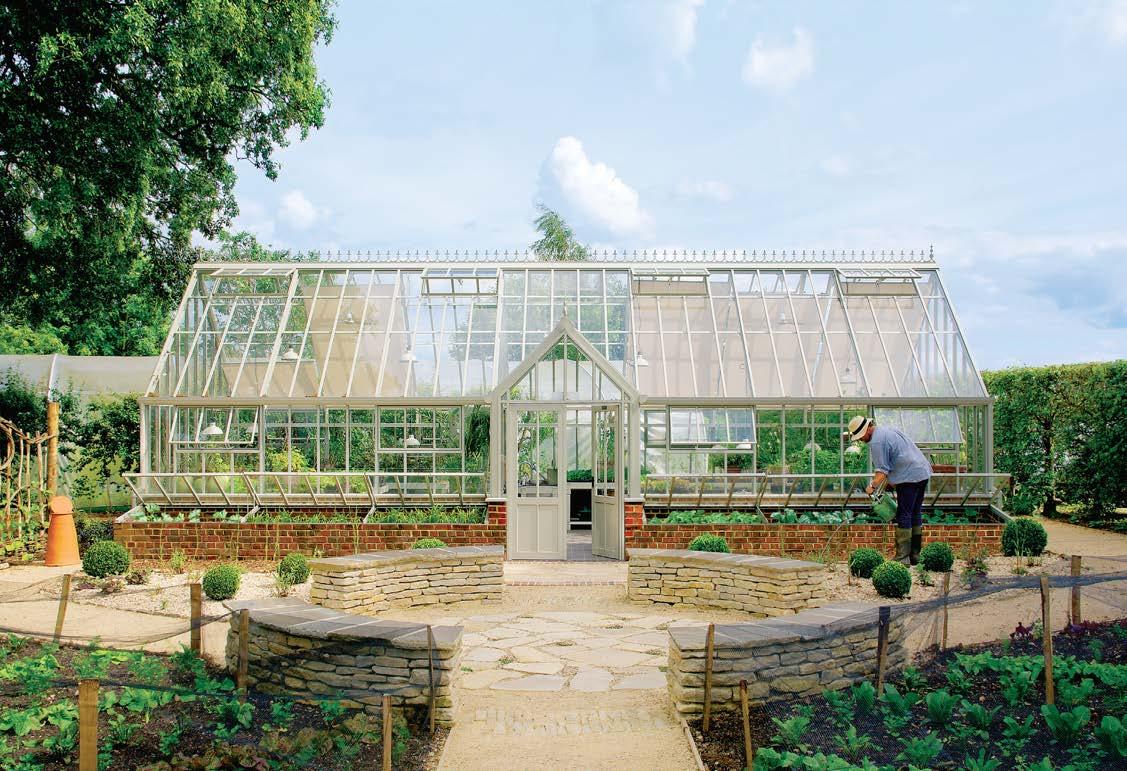
Why choose Hartley Botanic?
Unrivalled. Unparalleled. Unique. There are Glasshouses, and there are Hartley Botanic Glasshouses. Combining inspired
design with enduring quality, nothing enhances your garden like a Hartley Botanic. The manufacturer prides itself on five pillars of service that set it apart:
1. Beauty and Elegance An incomparable range of stylish and elegant structures means Hartley Botanic can create designs that are distinctive and unique. The Victorian, Heritage and Modern Glasshouse ranges mean customers don’t have to look elsewhere to find the type of beautiful, high-quality Glasshouse that best suits their style.
2. Structurally Superior Every Hartley Botanic Glasshouse is handmade in the North of England to customers’ exact requirements, using the finest materials with unparalleled durability, safety and beauty. Each section has a specific structural purpose, and for aesthetic
Above Hartley Botanic’s Victorian Grand Manor Glasshouse, here at Le Manoir aux Quat’Saisons in Oxfordshire, is a timeless, elegant centrepiece for any garden.
100 THE ENGLISH GARDEN NOVEMBER 2022
PROMOTIONAL FEATURE
reasons Hartley Botanic will never take shortcuts by ‘sticking’ aluminium to glass. It has such confidence in the structural integrity of its Glasshouses that it o ers a 30-year guarantee.
3. A Reputation Beyond Compare Hartley Botanic’s heritage and reputation has been built on trust for more than 80 years. The company has earned a reputation for crafting the very finest Glasshouses money
can buy through a combination of hardwon experience, craftsmanship and the very highest standards of service.
4. Unrivalled Knowledge and Expertise
A wealth of knowledge and expertise is built into every Hartley Botanic Glasshouse, and generations of customers have put their trust in the hands of the manufacturer’s expert, time-served, highly skilled craftsmen. Hartley Botanic
Boost growing space with a coldframe
Make room in the Greenhouse by hardening off in a frame

Seasonal overflow can cope with reduced protection as it matures. Coldframes or sheltered standing areas can therefore do much to relieve the pressure within the main Glasshouse. Coldframes are especially handy for hardening o plants and crops that are due to be moved to the garden later on. A three-week acclimatisation period in a coldframe will gradually accustom plants to conditions outside.
Coldframes are invaluable for other uses, too. Use them to raise hardy perennials, shrubs and trees from seed and for propagating ripe or semi-ripe woody cuttings taken in autumn. Marginally hardy succulents, bulbs
and other plants can also derive a little extra winter protection inside one. And during the growing season you can use the same frames for semi-protected crops such as ridge cucumbers, melons, strawberries or speedy spring and autumn salad leaves.
Left Launched this year, the Heritage Wisley 8 Grow & Store combines a traditional Glasshouse with handy extra storage space.

Below Hartley Botanic’s extensive range also includes contemporary Glasshouses, like this modern Magnum Opus with clean expanses of glass to create a striking architectural look.
is renowned for creating Glasshouses of distinction as a result of decades of specialist knowledge and care.
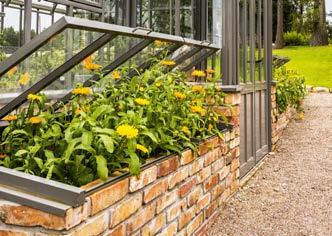
5. Exceptional Service Once an order has been handmade to a customer’s personal requirements and Hartley Botanic’s exacting standards, the delivery and installation will be exceptional. The team at Hartley Botanic are there to ensure the process runs smoothly, providing customers with the information they need to keep them up to date throughout.
Contact the Hartley team now Every Hartley Botanic Glasshouse is handmade to order, so for customers looking for structures designed perfectly to suit personal interests, lifestyles and tastes, the possibilities really are endless.
Visit hartley-botanic.co.uk or call 01457 819155 for more information.
® The Royal Horticultural Society. The Royal Horticultural Society, and its logo, are trade marks of The Royal Horticultural Society (Registered Charity No 222879/SC038262) and used under licence from RHS Enterprises Limited.
NOVEMBER 2022 THE ENGLISH GARDEN 101
IMAGES TOMEK CIESIELSKI; K LEE TENNEBOE; GINGER HORTICULTURE





Suppliers & Manufacturers of Luxury Ply-Lined Garden Sheds. Finished in the colour of your choice... Not Just Any Old Shed... To find out more call 01623 861364 or visit www.thecosyshedco.co.uk
Winter is Coming
As autumn progresses and temperatures fall, it’s time for gardeners to take steps to keep half-hardy and tender plants safe by keeping them protected over winter

Some tender plants can be protected in situ with fleece and stu ngs of straw, but there’s always an element of risk. You never know quite what winter will bring or how wet or cold it might be. Plants in the ground are prone
to waterlogging and the biggest killer of less hardy plants is always roots rotting away in soggy soil. The safest way to overwinter plants is often to bring them in and o er them some protection – and this is where a coldframe or a greenhouse will really prove their worth.
Tender and half-hardy container plants are easily moved into the protection of a greenhouse for the duration of winter.
NOVEMBER 2022 THE ENGLISH GARDEN 103
WORDS JIM CABLE & CLARE FOGGETT IMAGE GAP PHOTOS
Cold Comfort
Jim Cable explores the advantages of the versatile coldframe and how it assists with both protection and propagation
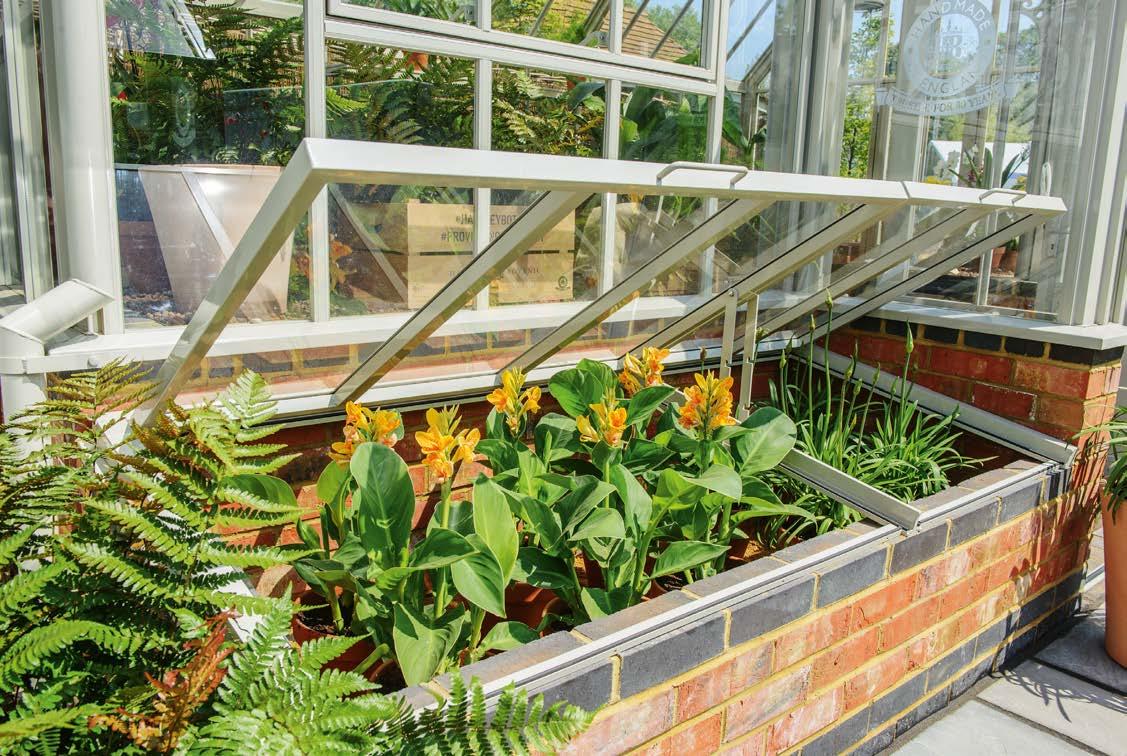
Some autumn days are benign, and we can still enjoy the warmth of the weakening sun. But night frosts threaten, it can be windy and, on some days the rain lashes down. With winter just around the corner, we look to di erent ways of keeping cosy. Some of our plants need protection from the elements too, and a coldframe can be the simplest space-saving solution.
These low-level miniature greenhouses might have glazed, wooden or brick sides, but all are united in having a clear sloping cover that may be hinged or entirely removable. In sunshine the temperature inside a coldframe is typically 5-10°C above ambient. Plants nestled within are sheltered from wind and their watering can be controlled.
There is nothing new about growers protecting their plants in an attempt to cheat nature. The Romans made their coldframes using straw or stone walls topped with sheets of mica to let in light.
Above Tender plants such as canna lilies will benefit from a coldframe, like this one from Hartley Botanic, where they can enjoy extra warmth while getting established.
They were also the first to use glass for windows –albeit translucent rather than clear. Manufacturing methods slowly improved over the centuries, and by the early 17th century glass windows were common in England and the first greenhouses were being constructed. Glass manufacturing and construction techniques developed further during the 18th century, which led, in turn, to the glass and iron palaces of the Victorian era.
Cast iron frames then became available to Victorian gardeners of modest means, allowing them to emulate the grand estates and grow such exotics as cucumbers and melons and give Mediterranean vegetables a protected start in life. Mrs Beeton, perhaps more famous as a cookery writer, also wrote extensively about garden management during the 1860s. She gives detailed advice on choosing or constructing a garden frame, ‘a structure moveable at pleasure… for raising and protecting early crops
104 THE ENGLISH GARDEN NOVEMBER 2022 In association with
in a warm aspect in the spring, and for obtaining and saving lettuces, etc., throughout the winter’.
If you have been growing salad leaves and leafy herbs such as coriander and mint in pots on the patio, moving them into the shelter of a coldframe now will keep them cropping for a few weeks more.




The first week of November (two weeks earlier in the north) is your last chance to start o winterhardy salad subjects such as claytonia, pak choi and mustard. Sow into modules of peat-free compost, water and place in a coldframe or, for speedier germination, on a windowsill indoors. You can then move them into the coldframe as young seedlings. It is important that the frame occupies the sunniest space you can give it – south-facing and as far from tall trees and buildings as you can manage. Shadows are long at this time of year and, of course, days are short. Light is at a premium and plant growth will be slow, so while you should not expect a large
Top from left Extend the season for spinach; claytonia can be started o in a coldframe now; the temperature in a coldframe is typically 5-10°C above ambient.
Above right A young lupin plant goes into the coldframe to stop winter wet rotting its roots.
Above left Letting onion skins ripen in the warmth of a coldframe.
harvest it is satisfying to pick a few spicy or crunchy leaves to pep up a winter salad.
Coldframes provide the ideal environment for overwintering small stock plants, whether these are rooted cuttings or specimens bought at a show, nursery or garden open day. If you intend to overhaul a border during the winter months, these plants will be happy waiting in the wings in a coldframe until their permanent quarters are ready. Young plants are more vulnerable to waterlogging and cold, and even perfectly hardy species can su er in an open bed over winter. If they are borderline hardy, such as the ‘Wish’ series of salvia or French lavenders, then some protection is essential.
Now is the ideal time to plant spring-flowering bulbs. If you put some in pots either in addition to flower beds or as your sole display, sheltering some inside a coldframe will help create a staggered display. The protected bulbs will get ahead in the

NOVEMBER 2022 THE ENGLISH GARDEN 105 In association with IMAGES JONATHAN WARD; GAP/MARTIN-HUGHES-JONES/MARK BOLTON; CLIVE NICHOLS; SHUTTERSTOCK
New Year and you can transfer them to create a focal point outdoors just before they flower. If you live in a high rainfall area, bulbs in pots can sometimes rot. In this case, placing them all under glass where you can control their watering makes sense. It will also help deter marauding squirrels.
A coldframe is ideal for raising alpine subjects such as Cyclamen graecum or ipheion species since
Above Aluminium and toughened glass coldframes tend to be the strongest and should be able to withstand the harshest of winds.
it protects them from excessive wet and snow.
The ideal scenario is to grow alpines in pots plunged into fine-grade gravel in the base of the frame. This moderates both temperature and available moisture.
Commercial coldframes come in di erent heights. Consider the overall size of the plants – and their containers – that you want to protect. Materials vary, too. Most coldframes are light enough to be moved around your growing space, which can be useful, but beware of flimsy construction that will easily succumb to wind damage. Heavier frames are advisable for windy gardens, and aluminium and toughened glass models are strongest. Cheaper designs use wood and polycarbonate sheeting and, while not as sturdy, can still give several years of good service.
A north frame is a particular type of coldframe placed on the soil to the north of a building or other structure so that it is entirely shaded from the sun. While light is allowed to penetrate, the absence of direct sunlight and the enclosed nature of the frame keeps temperature fluctuations to a minimum. This and high humidity inside the frame provide
Make your own coldframe
A cost-effective way to boost your growing space
If you or a family member enjoy a DIY project, than a coldframe is quite easy to make. It can be satisfying to use recycled timber – sca old boards or railway sleepers for instance. Alternatively, tanalised softwood is readily available.

If the boards are around 15cm wide, use two of them at the front and three at the back. The end walls need to be constructed from two layers of boards topped with a third cut on the diagonal so it slopes from the back to front walls and is flush with each. Join the walls together by
screwing them into uprights in each corner of 5cm x 5cm timber.
A polycarbonate sheet screwed to a wooden frame makes a good lightweight lid. Add a handle at the front and hinges to attach it to the back of the base. Alternatively, Edwardian sash windows can be upcycled into coldframe lids.
Brick-built coldframes should be laid on shallow foundations of concrete. Whatever the construction materials, painting the interior white or lining with aluminium foil will increase the light levels inside.

106 THE ENGLISH GARDEN NOVEMBER 2022 In association with
the ideal conditions for rooting cuttings inserted directly into the soil. Semi-ripe cuttings of broadleaved evergreens such as box or euonymus can be propagated in this way, which can be useful if you need lots of them – to make a hedge for example. This is a job for next year in early- to mid-summer. Hardwood cuttings of shrubs such as dogwood, buddleja, willow and philadelphus can be taken from November through to February.
Top A row of pineapples growing in a Hartley Botanic coldframe.
Above right Alpines such as Cyclamen graecum thrive in pots in gravel at a coldframe’s base.

Above left Ipheion species are also suited to coldframe growing.

very cold or wet. They can be kept frost-free by covering with hessian or a blanket on clear frosty nights. Water in the mornings, preferably only on sunny days. Your aim should always be to avoid shutting in plants with wet foliage, which will encourage fungal attack.
Good Resources
Access Garden Products
A range of free-standing coldframes and miniature grow houses made from aluminium and safety glass. Tel: 01788 822301; garden-products.co.uk
Agriframes
Aluminium coldframes in various sizes with sliding doors and adjustable shelving for your plants. Tel: 0117 9341790; agriframes.co.uk
Alitex
Coldframes supplied by the metre for integrating with a greenhouse or to stand alone. Tel: 01730 826900; alitex.co.uk
Claverton Cloches
Cast iron Victorian-style cloches for protecting smaller plants in situ. Tel: 07521 467371; clavertoncloches.com
Gabriel Ash
A selection of coldframes made of cedar wood to go with the range of fullsized cedar greenhouses. Tel: 01242 662926; gabrielash.com
Hartley Botanic
Full-size greenhouses can be supplied with integral coldframes, or there’s the compact, standalone Patio Glasshouse for smallscale overwintering. Tel: 01457 819155; hartley-botanic.co.uk

Two Wests & Elliott
Coldframes need monitoring to provide the ideal conditions for their inhabitants. Ventilate by lifting the lid during the day unless the weather is
Perhaps you should add a coldframe to your Christmas wish list. Next spring you could be starting dahlias into early growth in order to take cuttings and increase your favourites, germinating seeds and gradually acclimatising tender plants before they fledge to the open garden.
A range of greenhouse heaters, including the popular thermostatically controlled electric fan heaters from Bio Green. Tel: 01246 451077; twowests.co.uk
NOVEMBER 2022 THE ENGLISH GARDEN 107 In association with
IMAGES GARDEN EXPOSURES/ANDREA JONES; GAP PHOTOS; SHUTTERSTOCK; CLIVE NICHOLS
Supersize It
Clare Foggett on how the greater capacity of a full-size greenhouse increases the possibilities for overwintering plants
While coldframes are very useful, if you are a serious grower then there is nothing quite like a fullsize greenhouse. These allow you to overwinter tall plants and o er room for the gardener to enter – albeit with di culty when the space is crammed with tender treasures!
Compared with using a coldframe, there is less stooping and a greenhouse can give you the opportunity to potter among your protégés when the weather is grim. Furthermore, the greater capacity of a greenhouse means that temperature control is easier since there is usually the option to add electricity and a thermostatically controlled heater.
Even if you don’t heat your greenhouse over winter, just by virtue of being enclosed in glass its interior will be a degree or two warmer than outside. That may not sound like much, but it could be all you need to nurse borderline hardy plants through

Above For those with a larger number of tender plants, a greenhouse o ers a much bigger walk-in space. This is Hartley Botanic’s Victorian Grand Lodge.
the colder months – many need only a minimum of 3°C to tick over as long as they are kept dry. And it also enables you to do much more: an unheated greenhouse can be used to prepare winter blooms for the house, start o seeds for next year, propagate plants and grow winter crops. Use heating to boost the temperature and even more possibilities open up.
Winter should start with a clean greenhouse. Remove summer shading and wash the glass until it sparkles – maximising light is essential for healthy plant growth over winter. If the prospect of a bucket of soapy water and hours of elbow grease engenders feelings of dread, greenhouse supplier Hartley Botanic can provide self-cleaning glass, while some suppliers o er a cleaning service. Winter is also the time to have any broken panes of glass replaced and to repair cracks or damaged seals.
As the temperature begins to drop, start bringing plants inside. Thoroughly check pot plants before
108 THE ENGLISH GARDEN NOVEMBER 2022 In association with
putting them in the greenhouse, removing dead leaves, old flower stalks and lurking pests. Check for root damage courtesy of vine weevil grubs and ensure plants are otherwise healthy. There’s little point expending e ort and potentially costly heating to cosset plants that aren’t worth it.
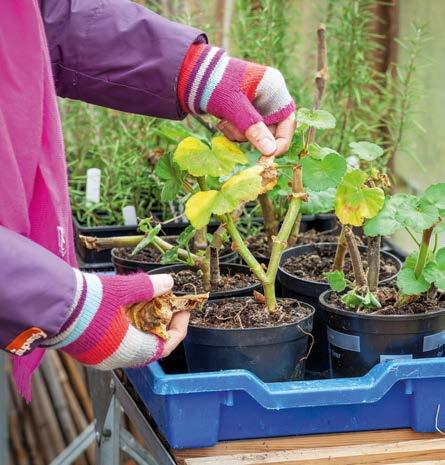
To give tender plants the best chance of surviving winter, the temperature really needs to be at least 7°C and ideally 10°C. In the UK that means heating. All forms of heating cost money, so evaluate whether it will be worth it: a prized collection of rare orchids may warrant the expenditure, whereas a few bedding plants will be cheaper to buy again next year. Many gardeners prefer to take a chance, overwintering plants in an unheated greenhouse and taking a que será será attitude to any losses.
If you do heat your greenhouse, keep bills as low as possible by insulating with bubble wrap. In a larger greenhouse, you can use a bubble wrap screen

Top from left Get the panes sparkling clean to maximise light; remove old leaves and stalks before moving plants under glass; bubble wrap will provide valuable extra insulation.
Above Neat rows of salad crops, with pumpkins and squashes laid out to cure, in this serious grower’s greenhouse.
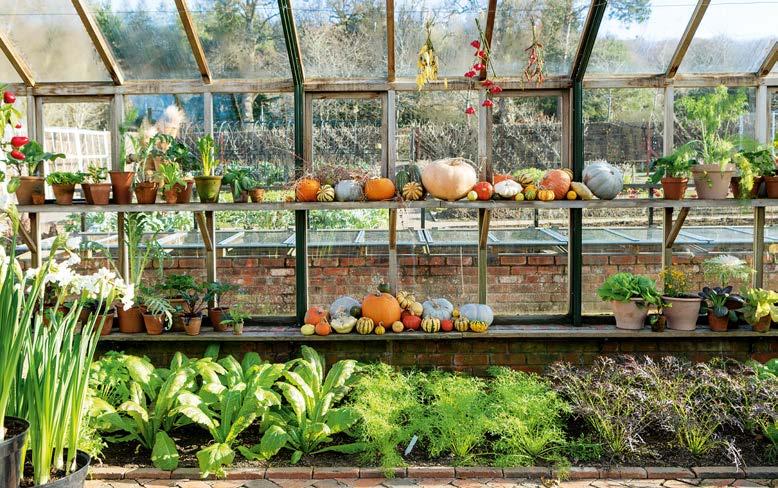
to portion o the smallest possible area where heat is required rather than heating the entire space. Hartley Botanic has a helpful calculator on its website for working out, roughly, how much power will be required to heat a greenhouse depending on its size.
A thermostatically controlled electric fan heater is the best option for heating, although the greenhouse will then need mains electricity. When adding a new greenhouse, always consider whether electricity can be installed at the same time – it’s just as valuable for lighting as it is for heating and is rarely regretted. The advantage electricity has over fuels such as gas or para n is that it’s clean and doesn’t emit water, soot or carbon monoxide, all of which can adversely a ect plants. Gas heaters can be heavy and bulky, while para n heaters are usually small and lightweight and, as a result, all too easy to knock over – a potential fire hazard that you may prefer not to risk.
With a minimum temperature of 7-10°C, plants like pelargoniums will continue to grow over winter, albeit more slowly due to reduced light levels. If they are growing, watering will be necessary, but be guided by the plant and never overwater: let the compost dry out between sessions. In an unheated greenhouse where plants are all but dormant over winter, keep compost on the dry side. Often, if the temperature dips below freezing for a short spell, dry roots could just save a half-hardy plant’s life.
A cold, damp atmosphere inside can also sound the death knell for many plants, so, whenever the weather is sunny, open vents and doors to let fresh air in and allow condensation to evaporate away. n

NOVEMBER 2022 THE ENGLISH GARDEN 109 In association with IMAGES GAP/JONATHAN BUCKLEY/MARK BOLTON

*Terms & Conditions: Use code RAR14 for total saving of £25.94 including FREE standard delivery and returns for Mainland UK only. O er ends 7th January 2023 and cannot be used in conjunctionwith promotional codes, multibuys or discounted items. O er is valid on advertised styles (N69L) only. All orders are subject to acceptance under WoolOvers standard terms and conditions. Items can be exchanged or your money refunded, providing it is returned within 28 days from the date of purchase. WoolOvers shall not be liable for any washing errors or detergent damage. For full terms and conditions visit www.woolovers.com/terms. “Great design, warm and good quality. The garment is very soft against my skin.” Jennifer, Plymouth Use Code: RAR14 NOW £49 SAVE £20* FREE delivery FREE returns Side Bu on Marl Stripe Jumper 100% Lambswool Machine washable Size: XS∙S∙M∙L∙XL Model wears: Grey Multi Ref: N69L WAS £69
Specialists in hardy trees, shrubs and climbers including a huge selection of unusual and rare species and varieties.




Expert advice is available from our helpful staff. The nursery is surrounded by a nineacre woodland garden (RHS Partner Garden), and visitors are welcome all year round.

Informative website and reliable mail order service if you would like plants delivered.
A plantsman’s paradise and an independent nursery situated in the West Midlands open seven days a week.
We specialise in hellebores, hardy cyclamen, salvias, hepaticas, lewisias, hydrangeas, dwarf conifers, snowdrops, Primula auricula and many more beautiful plants. Our UK mail order service sends plants, garden essentials and gifts direct to your doorstep. John’s Garden is also open on Saturdays 10am-4pm. Please visit our website for full details.

A plant fanatic’s paradise on the edge of the beautiful Surrey Hills, just 10 minutes from the A3/ M25. Brilliant homegrown trees, shrubs, climbers, grasses, perennials, roses, ferns, hedging and fruit, plus these November starlets: Arbutus unedo ‘Roselily’, Cotoneaster x suecicus ‘Juliette’, Carex testacea ‘Priarie Fire’, Coprosma ‘Pacific Sunset’, Heuchera ‘Forever Red’, Leuocothoe ‘Scarletta’ and Pittosporum ‘Bannow Bay’
Former home of gravel gardening pioneer, Joyce Robinson, and celebrated landscape designer, John Brookes MBE, Denmans is an award-winning, Grade II, RHS Partner Garden renowned for its curvilinear layout, complex plantings, gravel gardens, unusual plants, structure, Walled Garden, ponds, and Conservatory. Superb winter garden. Home and gardenware, vintage and one-off gifts in the gift shop, unusual plants in the plant centre. Midpines Café offers refreshments and light meals. Year-round. See website an award-winning specialist nursery in West Sussex with a reputation for designing and planting exceptional gardens the breadth of the UK. With an extensive collection of Japanese and European topiary, tropical specimens, screening plants and exotic rarities can swiftly transform clients’ gardens and innovative work. your visit nursery. design@ architecturalplants.com Garden Design
GARDENS & NURSERIES TO INSPIRE IN EARLY AUTUMN Tel: 01243 278 950 office@denmans.org | www.denmans.org Denmans Lane, Fontwell, Nr. Arundel BN18 0SU DENMANS GARDEN
OPEN:
We are
at our nursery, we
our
with exciting
Book
online to explore our
Contact
for our
service. We also deliver anywhere in the UK. Tel: 01798 879213 enquiries@architecturalplants.com | www.architecturalplants.com Stane Street, North Heath, Pulborough, West Sussex RH20 1DJ ARCHITECTURAL PLANTS Hedging UK are specialist growers of quality hedging plants. Plants are available to purchase at wholesale prices across the UK through our mail order service. Buy direct from the grower, delivered direct to your door. Readers of The English Garden get a 5% discount (quote TEG2022). Tel: 01704 827224 or 07789 922457 sales@hedginguk.com | www.hedginguk.com Boundary House Farm, Holmeswood Road, Holmeswood, Lancashire L40 1UA HEDGING UK
Tel: 01483 284769 info@springreachnursery.co.uk | www.springreachnursery.co.uk Long Reach, Ockham, Surrey GU23 6PG SPRING REACH NURSERY
Tel: 01530 413700 sales@bluebellnursery.com | www.bluebellnursery.com Annwell Lane, Smisby, Ashby de la Zouch, Leicestershire LE65 2TA BLUEBELL ARBORETUM & NURSERY Tel: 01384 401996 mailorder@ashwoodnurseries.com | www.ashwoodnurseries.com Ashwood Lower Lane, Kingswinford, West Midlands DY6 0AE ASHWOOD NURSERIES




















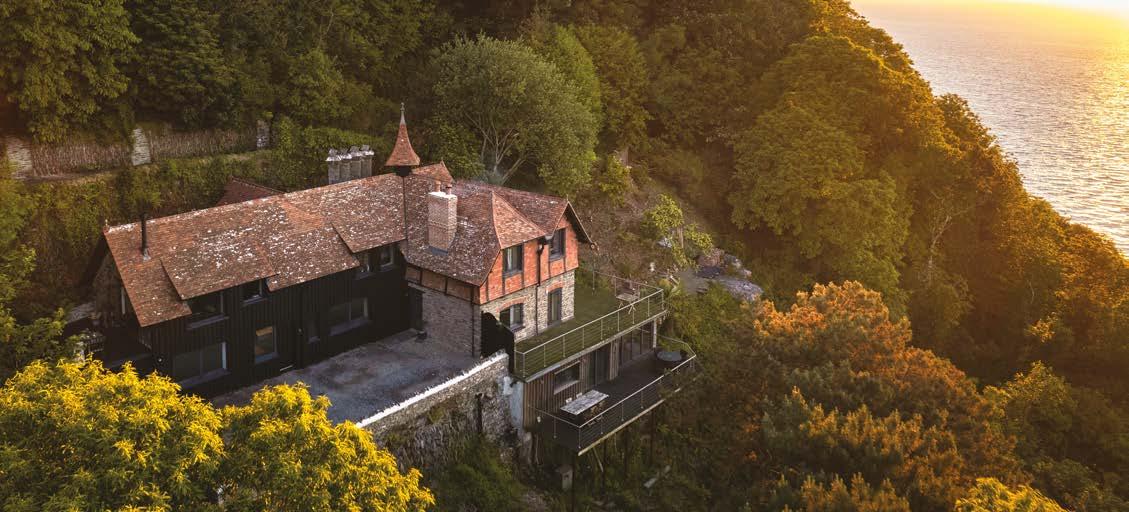
CLOTHING To advertise in the English Garden Classi ed Directory please call 020 7349 3700 or visit us at www.theenglishgarden.co.uk FOR MORE INFORMATION VISIT US AT WWW.THEENGLISHGARDEN.CO.UK COURSES GARDEN TOOLS TO ADVERTISE • TEL: 020 7349 3700 • EMAIL: info@chelseamagazines.com GETAWAYS Pretty cotton nightwear Christmas gifts Use code EGN10 at checkout for 10% off Order online at www.victoriagoss.co.uk Gardening Courses Home-study Free info FREEPHONE 0800 083 9191 or 01409 220 777 Or email: info@hccollege.co.uk www.hccollege.co.uk •For leisure or for a career •Over 30 courses in Gardening, Garden Design, Arboriculture, Forestry, Floristry and more • Many courses prepare you for RHS or RFS/ABC quals. EST 1930 HCC EST 1930 HCC HCC The English Garden 21 40x99.indd 1 21/07/2021 12:27 Cornishwear Cornish smocksperfect for gardening Made in Cornwall www.cornishwear.com hello@cornishwear.com 01736 732236 Over 100 varieties of field and pot grown hedge plants and young trees. Nationwide delivery. Glebe Farm, Langham, Colchester, Essex CO4 5PP e: hedge-plants@btconnect.com THE HEDGING SPECIALISTS GLEBE FARM HEDGING for advice or a catalogue contact us on t: 01206 323200 www.glebefarmhedging.co.uk boutique-retreats.co.uk +44 (0)1872 553 491 enquirie s@ boutique-retreats.co.uk From raising the flag on your own private island to watching the stars over the sea from your hot tub, Boutique Retreats specialise in unique, stylish properties that celebrate their surroundings whilst embracing luxurious living. We know how good getaways should be. STYLISH RETREATS IN THE UK’S HOTTEST LOCATIONS
Annual labelling is a thing of the past with Alitags. Simply write on Alitag aluminium labels with Alitag or HB pencil. The pencil will react with our specially made aluminium tags and become permanent.




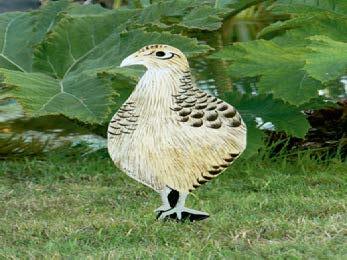


Alitag labels can also be punched with Alitag character punches & jig. Copper, Teak, Bamboo, Oak labels, numbered tags are also available.







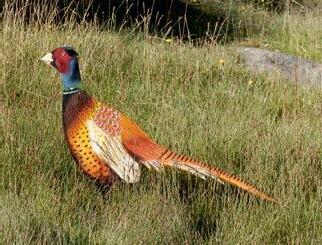



 wooden Keyrings : 95 locations
Herb and Sentiment Stone Labels
Boulder Stone Pots Teak Hanging Baskets
Wooden Doorstops
Owl Candle LanternBoulder Stone Pestle & MortarMouse Candle Lantern
Garden
wooden Keyrings : 95 locations
Herb and Sentiment Stone Labels
Boulder Stone Pots Teak Hanging Baskets
Wooden Doorstops
Owl Candle LanternBoulder Stone Pestle & MortarMouse Candle Lantern
Garden
32 Bourne Lane, Much Hadham, Herts SG10 6ER, UK. Tel 01279 842685 www.alitags.com www.alitags.com
www.giftsandgardens.com 32 Bourne Lane, Much Hadham, Hertfordshire SG10 6ER, UK. Tel 01279 842685
Friends made of aluminium that will not rust. Painted by hand on both sides. Suitable for outdoor. Hens, Cockerels, Squirrel, Ducks, Fox, and more are also available.
The Fantastic Fig
A truly gorgeous tree that produces delectable fruits when the conditions are just so, the fig is a favourite of Non Morris, who recommends select varieties

By the end of July the fig tree in my London garden was heavy with purple-green fruit, each one ready to burst and filling my cupped palm with its voluptuous weight, like a pouch of melted rubies from a forgotten fairy story.
I had been away for a month, leaving the garden to intense heat and no rain. My shady fleet of Hydrangea macrophylla ‘Westfalen’ were distressed and crisp, their gorgeous carmine flowerheads tiny and wizened. But the fig tree was magnificent, sprawling contentedly and in perfect health in the sunniest corner – and its produce was dazzling.
Whatever the nursery promises, if you grow a fig tree outdoors in the UK you will probably get a respectable crop only when conditions are exactly right – perhaps every three years. On good years you can eat figs in salads and tarts, give them away to friends and use the rest for Nigel Slater’s excellent fig chutney.
On the years in between there will always be gorgeous architectural foliage to enjoy. The leaves will light up the sky with their glowing green shoots in spring, become lush enough to provide serious shade in summer and then entrance again with gorgeous open hands of butter-yellow in October.
The fig is a romantic tree, ours especially so since it was given to us 30 years ago as a wedding present in a terracotta pot. This skinny, thigh-high specimen basked happily in the front well of our small terraced house until our twin sons were born and we went in search of somewhere bigger.
The choice of varieties is delectable, rich in stories and history. You could try Ficus carica ‘White Marseilles’, introduced to the UK by Cardinal Pole in
the mid 16th century (the original stands proudly in Lambeth Palace), regarded as one of the most delicious figs in cultivation, with pale translucent flesh and a juicy, honeyed flavour. Or you could choose ‘Violette Dauphine’, the favourite variety of Louis XIV, which has violet skin and a delicate strawberrycoloured interior.
Before you get carried o to the South of France, don’t forget the ultimate size of the tree you choose. Although we planted our wedding present between restricting retaining walls when we moved to our family house, it has grown into a wildly ranging champion tree that now reaches to the third floor. We never knew our fig’s name, but I feel sure it is ‘Brunswick’ described by Christopher Lloyd as ‘the largest fig you are likely to meet: about five inches long and very juicy’. ‘Brunswick’ was – worryingly, I later realised – selected by Lutyens specifically to cover large areas of new wall when the garden at Great Dixter was first made. Much as I love our fig tree, for a smaller garden I would now consider the ‘Chelsea’ fig, a super-tough variety discovered growing on the banks of the Thames and ideal as a small standard or in a container. I would also keep things meaner by adding gravel or broken terracotta pots into the planting site.
Thriving in the hottest driest conditions, the fig is a beacon of a tree for our future. It sits happily in both classic and contemporary gardens, creates a handsome living wall and does best when not remotely pampered. Perhaps a small compensation for our warming climate is that you soon won’t have to wait three years between each succulent crop.
rvroger.co.uk; pomonafruits.co.uk

Each fruit was ready to burst, filling my cupped palm with its voluptuous weight, like a pouch of melted rubies from a forgotten fairy story
114 THE ENGLISH GARDEN NOVEMBER 2022 TO CONCLUDE
ILLUSTRATION MARIA BURNS PORTRAIT RACHEL WARNE






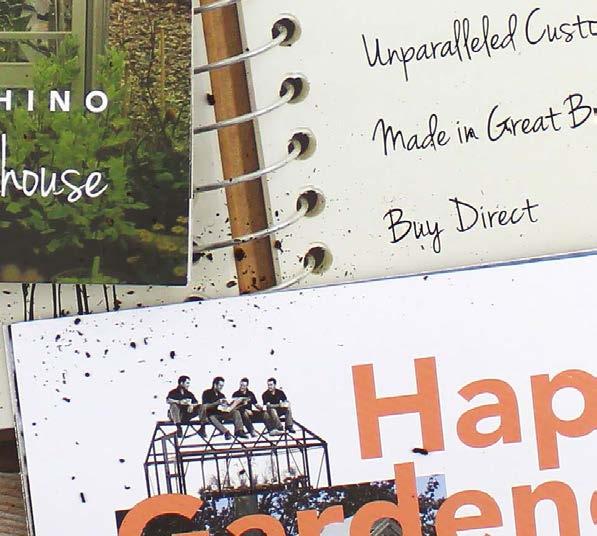


If you love your garden then you should place a Rhino at the heart of it. Because not only is it incredibly sturdy and cleverly designed, with an unrivalled standard specification, the stylish construction and elegant colours will ensure you have something beautiful to look at all year round. rhinogreenhouses.co.uk 0800 694 1929
